June 30, 2019
The Cunning Little Vixen at the Barbican Hall
And history is on their side. An advertorial in the Brno newspaperMoravské noviny, prior to the premiere of the opera at the Na hradbách Theatre on 6th November 1924 had little to say about the music or the design, but promised the paying public ‘seventy costumes’ designed by artist Eduard Milén, including - as Jennifer Sheppard notes in her article ‘How the Vixen Lost Its Mores: Gesture and Music in Janáček’s Animal Opera’ - ‘grasshoppers and crickets in “yellow-green tailcoats and magnificent little wings”; black-and-white glow-worms with reflectors “to light up their bottoms” in the night scenes; a wire-frame rooster costume lined with brightly coloured fabrics; and a green, blue and black dragonfly of “melancholy beauty”, whose tiny, delicate underwings were illuminated in glittering gold’. [1]
Not to be outdone, for their first production of the opera in May 1925 the Prague National Theatre engaged Josef Čapek, brother of the author Karel, as designer, and he duly dished up ‘flying goggles for the mosquito; flouncy polka-dot petticoats for the hens; cowboy spurs with golden rowels for the rooster; a furry deerstalker for the forester’s dog’ (Ibid).
Such aspirations for mimicry-cum-verisimilitude are not on the agenda of Peter Sellars, whose production of Vixen - first seen in Berlin in 2017 - was performed at the Barbican this week by his long-term collaborator and friend, Sir Simon Rattle, and the LSO. Here, minimalism prevails. The entire cast - soloists, London Symphony Chorus, the children of LSO Discovery Voices - are dressed in simple black and perform the action on a bare raised platform in from of the orchestra. Props comprise the odd chair or table, carried on by cast members as required.
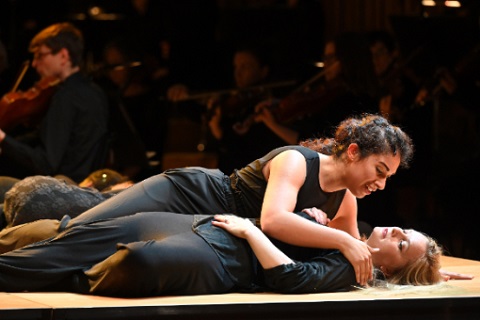 Sophia Burgos (Fox) and Lucy Crowe (Vixen). Photo credit: Mark Allan.
Sophia Burgos (Fox) and Lucy Crowe (Vixen). Photo credit: Mark Allan.
In the light of Janáček’s rather arbitrary ‘pairings’ of man and beast - the same singer takes the roles of the Forester’s wife and the Owl, the Priest’s animal embodiment is the Badger, and the inebriate Schoolteacher and Mosquito share a role and a bottle - my first thought was how on earth were we to distinguish the animals’ identities and their human correlations? But, I need not have worried: video designers Nick Hillel and Adam Smith (of Yeast Culture) offer an Attenborough-esque Planet Earth natural history side-show which presents tadpoles as they wriggle into life, dragonflies engaging in shimmering. flickering mating rituals, peering owls, migrating geese, fluttering sun-flecked forests and moonlit mountains.
Indeed, Sellars’ approach pre-empts objections which are sometimes voiced about the stylisation of gesture in which some productions indulge; and if we can’t always differentiate between man and animal, then this only serves to emphasise the inter-connectedness of the entire natural world, man included.
Billboards in Brno in 1924 had enticed prospective punters, ‘It will be a dream, a fairy tale that will warm your heart’, but there is no sentimentality in Sellars’ Vixen. That’s not to say that it does not touch one’s heart, but the strings it pulls of the more sombre, dark kind. Warmth came in the form of the wonderful playing of the LSO. The score includes many instrumental episodes, which are often both balletic and mimetic, and Sir Simon Rattle ensured that every rhythm was delineated with pulsating vigour, every surge of harmonic passion blossomed fulsomely, every extreme of register was meticulously scaled: there was some especially beautiful playing from the strings. In the programme booklet Rattle declares this opera was “the piece that made me want to become an opera conductor … and [its] still one of the pieces that reduces me to tears more easily than any other”, and the loving tenderness with which he articulated the score’s emotions and dramas might well have inspired a tear from many in the Barbican Hall. The LSO did not just mimic or suggest stage movement or feeling, they took responsibility for the drama, filling in the gaps in the episodic structure, immersing us in a glorious musical embrace.
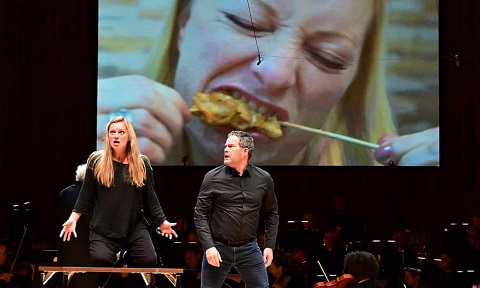 Photo credit: Mark Allan.
Photo credit: Mark Allan.
Lucy Crowe was a stunning Vixen - insouciant, courageous, feral, sensuous, daring, brazen and honest. This is one of best things I’ve seen Crowe tackle. This Vixen was strong and nimble, and Crowe relished the physical animation as much as she did the vocal vivaciousness. Standing astride the Forester’s kitchen table she impassionedly goaded the repressed hens into socialist revolt, and when she failed, she resorted to tricksy tactics, claiming that she’d rather be buried alive than live with such losers. A winning move: the Cock’s vanity got the better of him and his ‘bravery’ saw him succumb to the ‘playing dead’ mime. The Vixen’s gluttonous gourmandising on chicken skewers was played out in gloriously chin-greasy detail on screen.
Crowe’s Vixen was both ethereal - her soprano silky in the reflective soliloquies - and earthy. In the cartoons by Tĕsnohlídek upon which the opera was based, the Vixen relieves herself into the badger’s den to force him to evacuate, and Crowe sprayed with gleeful vigour! She sang with flashes of brightness and fire, balanced by soft sensuousness. It was an utterly beguiling performance.
Sophia Burgos’ Fox was surprisingly tender: no strutting and posing here, instead coaxing and caring in a beautiful love duet with the Vixen. Initially I thought that Burgos struggled to carry over the strong orchestral fabric, but she grew in stature, crafting a convincing personality: a sort of house-husband of paternal benevolence, anxiously ushering their growing brood of cubs into the under-stage den when their mother was threatened by Hanno Müller-Brachmann’s Poacher, Harašta, after she’d raided his basket of poultry. If the Vixen’s death did not seem quite so shocking as it sometimes can do, then that did not seem to matter: the Vixen’s death was not the climax of a dramatic arc but rather just one happening, incidental and quickly forgotten by a natural world whose chief concern was to nurture the next generation.
As the Forester, Gerald Finley’s performance captured the moral complexities faced by the humans living in the forest. Amorality met anxiety met ambiguity in the personage of this Forester. This was an expressive tour de force. And, a vocal triumph too. Some may have objected, but I loved the way that the original cartoon’s intimations that the Vixen was the animal embodiment of Harašta’s seductive beloved, Terynka, was referenced in Finley’s encounter early with the Vixen - a passionate love-making accompanied by overflowing orchestral warmth, which teased out myriad emotions. Upon returning home, the Forester was met with a disapproving scowl from his Wife, richly sung by Paulina Malefane (also Owl and Woodpecker). Was the encounter real or imagined? The ghostly green glow in which the encounter was bathed by lighting designer Ben Zamora made it difficult to know. But, their subsequent struggle in which they seemed locked was as much a physical one as a psychological one: with the Vixen, by turns, beaten for stealing the Forester’s food, biting back in defiance, nestling needily alongside her captor, needling him with her desire for freedom.
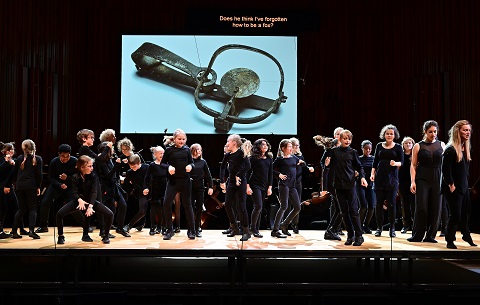 Photo credit: Mark Allan.
Photo credit: Mark Allan.
This was a luxuriously cast performance, even allowing for the dearth of native Czech speakers. Peter Hoare was equally commanding and characterful as Schoolmaster, Cock or Mosquito; Jan Martiník was a fine Parson/Badger, gruff and glum. Müller-Brachmann stalked opportunistically and menacingly around the Barbican Hall, his hunting gun perched, ever-ready. Anna Lapkovskaja’s Dog was convincing put out by the arrival of a usurper in the Forester’s household, but animal instinct took over though the companionship she craved was denied her. The London Symphony Chorus sang with vigour and managed their entrances and exits swiftly, while the children of the LSO Discovery Chorus were well drilled, vocally and dramatically, charming us in every scene in which they appeared.
And, what of Sellars’ slide-show? Well, images such as the gruesome hunter’s trap and the conveyor belts of chickens heading to their destined doom certainly made their mark. But, the city apartment blocks were an odd evocation of the Forester’s milieu and the folk dancers who supplied the entertainment at Harašta’s wedding seemed less fitting. Overall, I found the visuals rather hyperactive: however well one knows the opera, how could one take in the dramas playing out on both screen and stage, in song and symphonic strata, simultaneously?
The three Acts ran segue with no interval; in fact, Rattle allowed barely a breath between Acts - just enough time to get personnel off-stage and back on again. The effect was to cohere the episodic scenes - which have little to connect them, chronologically or in terms of dramatic linearity - into one flowing stream of nature, emphasising not so much the epiphanic rebirth that the Vixen’s death bestows upon the Forester, but rather the continuous renewal of life, and the speed of transitions between seasons and generations. At the close the Forester espies the Frog: not you again, he declares, only to be answered by a cheeky, slimy nose-rub and the riposte, “That wasn’t me, it was my grandfather. He told me all about you.” The moment was simultaneously insouciant and of import: here was the brevity of life, the brutality and benevolence of nature. Like the whole performance, it was beguiling and brilliant.
Claire Seymour
Gerald Finley (Forester), Lucy Crowe (Vixen), Sophia Burgos (Fox), Jan Martiník (Badger/Parson), Peter Hoare (Mosquito/Cock/Schoolmaster), Hanno Müller-Brachmann (Harašta), Irene Hoogveld (Jay), Anna Lapkovskaja (Mrs Pašek, Dog), Paulina Malefane, (Forester’s Wife/Owl/Woodpecker), Jonah Halton (Pásek); Peter Sellars (Director), Sir Simon Rattle (Conductor), Ben Zamora (Lighting Designer), Nick Hillel and Adam Smith (Video Design/ Yeast Culture), London Symphony Orchestra, London Symphony Chorus, LSO Discovery Voices.
Barbican Hall, London; Thursday 27th June 2019.
image= http://www.operatoday.com/Forrester%20and%20Vixen.jpg image_description= product=yes product_title=The Cunning Little Vixen: Sir Simon Rattle, LSO, Barbican Hall product_by=A review by Claire Seymour product_id=Above: Lucy Crowe (Vixen) and Gerald Finley (Forester)Photo credit: Mark Allan
Barbe-Bleue in Lyon
Unlike Mr. Pelly’s straight forward, very charming Peruvian fantasy, La Perichole that I saw at the Marseille Opera in 2002, or his parody of The Barber of Seville (sung on top of sheets of musical score paper) seen at the Marseille Opera in 2018 (boasting the hyper personalities of Stephanie d’Oustrac as Rosina and Florian Sempey as Figaro), here Mr. Pelly’s Barbe-Bleue is set on a farm near Paris and in a grand salon in the Élysée Palace, with actors of limited personality.
The real Barbe-Bleue is the 1619 folk fairy tale by Charles Perrault which Offenbach parodies à la Second Empire. But Mr. Pelly’s stretches the parody to include a parody of his own — that of opera stagings which imitate the criminal underworld (Bluebeard is dressed and acts like a mobster) and a parody of mindless operettas (King Bobeche is a pompous fairy tale king with a silly fairy tale court).
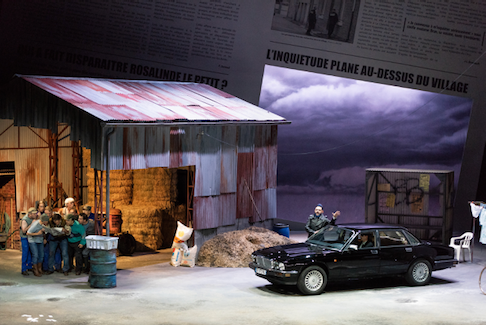 The Farm
The Farm
The time is now or maybe not-so-long-ago. We see a backdrop that is a latest edition newspaper, two front page articles discuss the strange murders. There is a tractor and chicken sounds and some bales of straw to convince us that all this is somehow what real is. Then we see a huge shelf of weekly revues (magazines), those that thrive on news of lurid allure, maybe true and maybe not. It is a side wall of the grand salon in which such tales of the rich and powerful evidently take place.
All this operetta scenery did not add up to a convincing stage for Offenbach’s amusing serial murders, particularly when we saw the refrigerated lockers of a morgue where Bluebeard’s victims are stored. We do know that "bluebearding" women (serial murder of women) is a real, recognized syndrome, but Mr. Pelly and his long-time designer Chantal Thomas only confused us about what may be real and what may not be.
From copious accounts we know that Offenbach’s muse during his very productive years at the Théâtre des Variétés was mezzo-soprano Hortense Schneider. We read of the very great charm of her performances but, alas, we have no digital records of them. Plus what was charming in the Parisian 1860’s may not charm us these days.
It is however the charm, whatever it may be, of an Offenbach heroine that wins our attention and ushers us into his music. The Lyon Boulotte (the Hortense Schneider role) was bravely undertaken by Héloise Mas who can indeed boast Boulotte’s “Rubenesque” body. Mlle. Mas was directed to be a bratty, tomboy rustic — maybe Mr. Pelly’s idea of real — forgetting that first of all Offenbach’s Boulotte must be a comic diva.
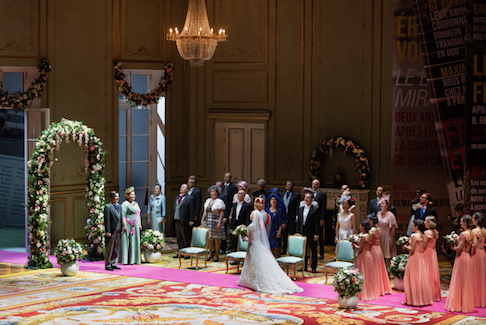 The Palace
The Palace
Bluebeard himself, played by tenor Yann Beuron, was directed to be oily, dangerous and thoroughly unsavory. Though not the usual mild-mannered, reclusive murderer we read about in actual newspaper accounts of such murders, perhaps Mr. Beuron’s Bluebeard fulfilled Mr. Pelly’s idea of a real murderer.
If the two protagonists of the Lyon Barbe-Bleue were meant to be real, the balance of the cast was rendered quite irreale. Prince Saphir played by Carl Ghazarossian and Popolani played by Christophe Gay were physically willowy, and both had an annoying lock of hair that fell across their faces. Count Oscar was willowy as well. The three men exuded a similar maximal energy in executing their roles while avoiding any distinguishing personality or character.
Fleurette, played by soprano Jennifer Courcier, King Bobeche played by Christophe Mortagne and Queen Clementine, played by Aline Martin were stock operetta characters. The thirty-six choristers were directed as if they were collectively one character — they made unison, abstractly choreographed movements.
Maybe a less slick reading of the score by conductor Michele Spotti and a less slick performance by the Opera de Lyon orchestra might have allowed a bit of Barbe-Bleue’s innate charm to slip through.
Michael Milenski
Cast and production information:
Barbe-Bleue: Yann Beuron; Le Prince Saphir: Carl Ghazarossian; Fleurette: Jennifer Courcier; Boulotte: Héloïse Mas; Popolani: Christophe Gay; Le roi Bobeche: Christophe Mortagne; Le Comte Oscar: Thibault de Damas; La reine Clémentine: Aline Martin. Orchestre et Chœurs de l'Opéra de Lyon. Conductor: Michele Spotti; Mise en scène et costumes: Laurent Pelly; Adaptation des dialogues: Agathe Mélinand; Décors: Chantal Thomas; Lumières: Joël Adam. Opéra Nouvel, Lyon, France, June 22, 2019
image=http://www.operatoday.com/Barbe-Bleue_Lyon1A.png
product=yes
product_title=Barbe-Bleue at the Opéra de Lyon
product_by=A review by Michael Milenski
product_id=Above: Christophe Gay as Popolani, Héloïse Mas as Boulotte [All photos copyright Stofleth, courtesy of the Opéra de Lyon]
June 29, 2019
Mieczysław Weinberg: Symphony no. 21 (“Kaddish”)
This recording of Weinberg’s masterpiece, conducted by Mirga Gražinytė-Tyla, with the City of Birmingham Symphony Orchestra, Gidon Kremer and the Kremerata Baltica, comes from the acclaimed live performance, part of the in-depth CBSO Weinberg series in November 2018. Though the symphony does get performed and has been recorded once before, this performance is exceptionally idiomatic as it is made by the finest specialists in the field, Gidon Kremer and Kremerata Baltica, supported by Gražinytė-Tyla and the City of Birmingham Symphony Orchestra, in top form. With these impeccable forces, it is unlikely that this performance will be surpassed for some time. This belongs in every collection, Weinberg-focused or not.
The combination of chamber orchestra, soloists and large orchestra is fundamental to structure and meaning. Embedding the ensemble and soloists within the orchestra shapes highlights individual voices against a wider background. In the apocalyptic tumult of the Holocaust, personal utterances must not be overlooked. This also extends the forces Weinberg can bring to bear in this panoramic landscape. “It is hard to string this bow”, said Gražinytė-Tyla of the interaction between ensemble and orchestra. “The reason is that long passages are dominated entirely by a solo voice and various chamber ensembles while the gigantic orchestral apparatus of almost 100 musicians sits on the stage” resurfacing at different points.
The Largo opens with the plaintive sound of Kremer’s violin, singing, poignantly, alone. Weinberg could be referencing many sources – the role of violinists in Eastern European culture, community fiddlers as well as trained virtuosi. On an autograph manuscript, Weinberg quoted the title of Mahler’s song Das irdische leben where a child cries out for bread, but is ignored, and dies. There are also quotes from Chopin’s Ballade no. 1 in G minor (Op. 23), further anchoring the Polish context in which Weinberg grew up. With muffled timpani, darker forces enter. There are moments when Kremer deliberately hardens the tone. But the violin soars upward, supported by the strings in the orchestra, before being silenced by a single, harsh drumstroke. The violin resumes reaching a very high tessitura above the steady pulse in the orchestra, before quietly subsiding as the orchestra shapes transparent, ethereal textures. The Allegro molto shatters any illusion of peace. This is graphic music. Ferocious chords and turbulent crosscurrents, interrupted by “gunfire” (percussion) and sudden, sharp outbursts of violence. The Largo is built around a chorale-like anthem. Tense, quiet passages alternate with more expansive motifs. Kremer’s violin re-emerges, bold, klezmer-like figures taunting strident, low-voiced brass. The Presto is manic, screaming alarums and madcap grotesquerie. Yet Kremer’s violin will not be stilled, its melody restrained but uncowed. As it fades, the Andantino rises, single notes plucked on violin, answered by the orchestra. This section is exquisite, executed with great poise, a reminder of civilized values.
In the Lento, the panoramic landscape of the Largo is redrawn. The violin is plucked, quietly, against a wash of high-pitched winds – winds suggesting movement and n the Lento, the panoramic landscape of the Largo is redrawn. The violin is plucked, quietly, against a wash of high-pitched winds – winds suggesting movement and change – bells ringing against ostinato discord, and a soprano voice is heard, singing a wordless plaint. The soprano is Gražinytė-Tyla herself, who trained as a singer and came from a music background. She knows how to carry a line, and the purity of her tone fits perfectly with what the voice might signify. The part is substantial and quotes passages that Kremer and the other soloists had played before. At moments her voice deepens richly before soaring upwards before the piano (Georgijs Osokins), clarinet (Oliver Janes), violin (Kremer) and double bass (Iurii Gavryliuk) return, the ensemble raised from the dead, so to speak, reunited with Gražinytė-Tyla’s song, growing with even greater affirmation than before. The symphony ends with a mysterious glow in this extraordinarily sensitive performance. This is a symphony of such multi-layered depth and subtlety that it rewards attentive listening.
Weinberg’s Symphony no. 2 (Op. 30) may have been written closer to the time the events described in Symphony no. 21, but traumas like that need time to process. In any case, Weinberg had to contend with Stalin and the Soviet authorities. Written for string orchestra, the textures are lighter, Gražinytė-Tyla conducting the Kremerata Baltica so the lines flow gracefully. The part for solo violin dominates, leading the ensemble forth. In the Adagio the violin takes flight. The higher strings follow but are met by a hushed section for lower strings. The Allegretto is lively: brightly poised and nicely defined.
Anne Ozorio
image=http://www.operatoday.com/Weinberg_Kaddish.png image_description=Deutsche Grammophon 483 6566 product=yes product_title=Mieczysław Weinberg: Symphony no. 21 (“Kaddish”); Symphony no. 2 product_by=Mirga Gražinytė-Tyla, The City of Birmingham Symphony Orchestra, Gidon Kremer and the Kremerata Baltica product_id=Deutsche Grammophon 483 6566 [2CDs] price=$15.99 product_url=https://amzn.to/2FGIegRThe Princeton Festival Presents Nixon in China
When it premiered at the Houston Grand Opera in 1987, just a decade and a half after the epochal events it portrays, Nixon in China received accolades. Since then, it has secured a modest spot in opera world, with two or three productions a year worldwide – but this understates its musical significance. Over the past three decades, other composers have adopted many of Adams’ innovative techniques, such as basing plots on current events, using romantic harmonies and melodies, quoting popular music, including surrealistic political satire, and amplifying singers.
Poet Alice Goodman did not write the libretto around a conventional plot. Instead, she recounts the ceremonial highlights of President Nixon’s famous visit – his arrival at Beijing Airport, meetings with the Chinese leaders, Pat Nixon’s experiences among the people, a state banquet, and a revolutionary ballet – as a basis for a surreal reflection on the tension between public duty and private life.
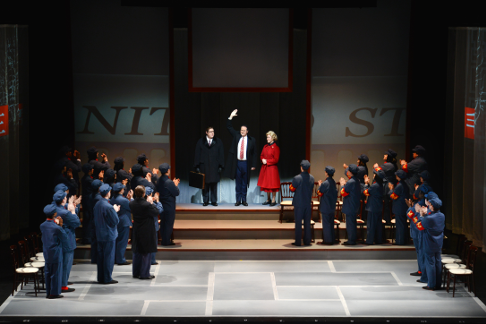 The Nixons and ensemble
The Nixons and ensemble
The libretto’s strength lies in a series of introspective monologues in which each character recounts important memories that shape their attitude toward politics. Goodman’s underlying point seems to be that most politicians are childishly self-important. So Madame Mao is a revolutionary fanatic who treats the creation of a perfect society as an aesthetic project. Kissinger is a doddering old fool who responds to Chou En-Lai’s desire for dialogue by asking to go to the toilet. President Nixon is an American provincial who obsesses on World War II. Mao is a cryptic old man muttering platitudes about his boyhood revolutionary achievements. All have lost touch with everyday virtues of family, community and humanity.
The remaining two characters offer a more sympathetic and humanistic alternative. Chou En-Lai’s elegance and sense of the historical moment fuel two memorable arias, one each at the end of the first and third acts. Pat Nixon expresses stereotypical virtues of “home and hearth” through her simple love of children, animals, community and other simple things.
Adams sets this libretto with a distinctive style of orchestral writing. Drawing on the minimalist tradition of Philip Glass and others, the score of Nixon in China rests on hypnotically oscillating block chords and arpeggios punctuated by syncopated notes. The challenge for minimalist music is that it lacks a clear architectural principle that allows music to develop harmonically and melodically over longer timespans. Climaxes are achieved almost entirely by increasing volume or speed. Minimalist music shimmers and even changes, but it does not evolve – in contrast to the music of Schubert, Wagner, Bruckner and other traditional composers who sometimes employed repetitive forms.
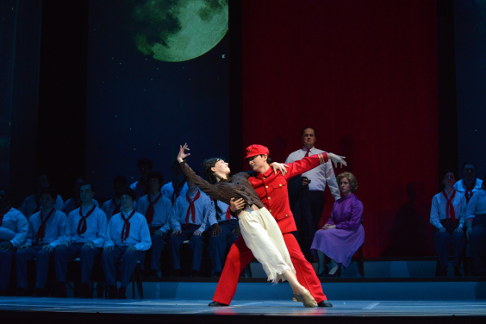 Ballet sequence
Ballet sequence
For Adams, the overall result is atmospheric but static music, more akin to a film score than a classic opera. In most scenes of Nixon in China, that mood is one of slightly mysterious introspection, as if one is seeking to remember something distant and ineffable – a suitable style for moments when characters reminisce. The result can be quite beautiful, as in Pat Nixon’s scena “This is Prophetic,” with its hypnotically undulating alternating between E major and E minor. It can also be exciting for short periods, as in Madame Mao’s robotic revolutionary rhetoric. Yet it rarely sweeps the listener up.
In contrast to previous minimalists, Adams seeks to offset the orchestral stasis by introducing traditional melody in the vocal parts – which he does by adopting a surprising number of traditional bel canto conventions. Act I ends with an ensemble, Act II with a coloratura showpiece, and Act III with a reverie – and the opera even contains a ballet, albeit a surrealistic one reminiscent of a 1950s movie dream sequence. Each major character receives at least one big scena. President Nixon’s opening aria (“News”) follows the fragmented style of the orchestra, but in the second and third acts, the vocal lines become longer and more romantic – and are then often picked up by the orchestra in a manner intermittently reminiscent of Wagner or Puccini. Later in the opera, pop rhythms and ballet music appear.
This distinctive structure means that a successful performance of Nixon in China requires great singing actors. The justly celebrated premiere production, directed by Peter Sellars and featuring Boston-area stalwarts Janes Maddalena as President Nixon and Sanford Sylvan as Premier Chou En-lai, was exemplary. It also included a superb portrayal of Pat Nixon by the extraordinarily versatile crossover artist Carolann Page – who teaches today at Westminster College, less than a mile from where Princeton Festival performs.
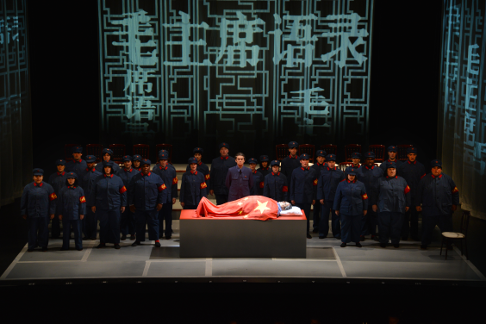 Death of Mao
Death of Mao
The Princeton cast was comprised of younger American singers with a solid track record in regional houses and on the competition circuit. Almost all excelled in what was the first time performing this difficult score. Baritone Sean Anderson, who has performed here several times before, blustered self-importantly as Nixon. Lighter baritone John Viscardi remained dignified and smooth in the lighter role of Chou En-lai. Coloratura Soprano Rainelle Krause reined in a few blaring high notes to offer a subtly characterized renditions of Pat Nixon’s big monologue. Soprano Teresa Castillo brought down the house with Madame Mao’s big rant, even if she lacks some of the icy precision and focus the score suggests. Tenor Cameron Schutza deployed a ringing Heldentenor to portray Chairman Mao. Baritone Joseph Barron was gruffly sonorous as Henry Kissinger. Each singer was precise and passionate and acted well.
A great performance of this difficult opera, however, requires more. Maximum impact requires singers able to deliver lines with the subtlety, exceptionally clear diction and clear and beautiful tone of a Lieder singer – something made easier by the use of microphones authorized by the composer. In general, the Princeton performance was more conventionally “operatic” that it might have been, and not all singers consistently attended to stylistic nuances.
One example must suffice. Unlike many modern composers, Adams writes with exceptional attention to poetic cadence. The note values in his vocal lines subtly mirror different patterns of long and short syllables. In particular, the ends of many lines are syncopated (most often LONG-short-LONG, or LONG-short-short). (An example is President Nixon’s first sung line: “News has a kind of MY-ster-Y”.) This distinctive three-syllable rhythmic snap drives the music forward – much as does the rap cadence in a more recent work like Hamilton.
Such details intermittently went missing, as one might expect in a short run. Achieving such stylistic unity requires, in addition to precise coaching, a conductor who keeps the orchestra moving swiftly and is willing to hold down the volume and weight of the instrumental playing. Festival Director Richard Tang Yuk directed with his customary care and precision, and the orchestra and chorus delivered a polished performance of this difficult work – even if cautious tempos, a thick sound, and intermittent lack of rhythmic nuance tended, in the end, to drag the performance down somewhat. The staging showed that much how much innovative lighting and color can achieve at a relatively low cost. The opening and closing scene, in which Chou stands before the casket of Mao, was particularly effective. The ballet dancers were engaging.
Overall, this production reinforces the Princeton Festival’s reputation as a site for innovative and sophisticated summer opera.
Andrew Moravcsik
image=http://www.operatoday.com/NiC003.png image_description=The Nixons and Kissinger [Photo courtesy of The Princeton Festival] product=yes product_title=The Princeton Festival Presents Nixon in China product_by=A review by Andrew Moravcsik product_id=Above: The Nixons and KissingerPhotos courtesy of The Princeton Festival
June 28, 2019
Humperdinck's Hansel and Gretel at Grange Park Opera
But from our contemporary perspective it is difficult to make such a setting seem anything but picturesque, so opera directors have mined the psychological elements underlying the story. Two iconic 20th century productions, that of David Pountney for English National Opera and by Richard Jones for Welsh National Opera set the piece in urban 1950s with the wood and the witch representing a psychological nightmare based on reality.
Stephen Medcalf's production of Englebert Humperdinck's Hansel and Gretel was shared between the Royal Northern College of Music (where it debuted last year) and Grange Park Opera, where we saw the second performance on Thursday 27 June 2019. Caitlin Hulcup was Hansel and Soraya Mafi was Gretel with Susan Bullock as Mother and the Witch, William Dazeley as Father, Lizzie Holmes as the Dew Fairy and Eleanor Sanderson-Nash as the Sandman. George Jackson conducted the orchestra of English National Opera.
Medcalf and his designer Yannis Thavoris set the piece in the 1890s with the family as urban poor, whilst the 'forest' is simply the outside city (Thavoris provided a striking forest of street lights) and foraging for the children consists of scrounging and stealing Oliver Twist-style. The witch's house is in fact a magic sweet shop, but its interior is a magically larger version of the children's home. All this would seem to provide some interesting psychological layers to explore, particularly as the production had Susan Bullock doubling as the Mother and the Witch.
In fact the urban forest entirely lacked a sense of danger and, populated during the Witches ride by a cast of Dickensian-type characters, seemed simply picturesque with the children remarkably in charge of their own destiny. Whilst the third act's setting in a version of the children's home had interesting resonances, none of this was explored as Susan Bullock's Witch was a magnificently comic creation which had little link, physical or metaphorical, to her performance in Act One as Mother.
The intention, as with the Royal Opera's disappointing recent new production of the opera seemed to be to provide an evening of unthreatening entertainment, and within these constraints Medcalf's production was surprisingly imaginative, and coupled to one of the finest musical performances of the opera that I have heard in a long time.
The musical delights started with the first notes of the overture as the horn melody rose out of the pit, rich in texture and beautifully shaped. George Jackson and the orchestra brought out the well-made counterpoint which underlies Humperdinck's score. Yes, the glorious melodies were there, finely phrased and, well, glorious. But weaving them together was a sense of this beautifully made German counterpoint, which showed the work's complex history. The orchestra of English National Opera seemed to be demonstrating what we were missing by not using a full orchestra for ENO's recent production of Hansel and Gretel at Regent's Park Open Air Theatre. And George Jackson, a young conductor to watch, was clearly alive to the various resonances in Humperdinck's score. Yes it is Wagnerian, but I also heard pre-echoes of Mahler in the Act Two folk-sequences. Throughout the amount of detail was wondrous, yet woven into an enchanting construction which mixed humour with the magical. The angel pantomime at the end of Act Two provided the element of transformative radiance, which was entirely lacking in Medcalf's lamp-lighter's ballet. Whatever other musical delights the production offered, and there were plenty, I kept coming back to Jackson and the orchestra.
Soraya Mafi and Caitlin Hulcup made a delightful pairing as Gretel and Hansel, for all the picturesque charm of the characters' depiction there was a fundamental seriousness to their performance which emphasised the music's quality. Mafi was a poised Gretel, shaping the lovely melodies carefully and expressively, and she was matched by Hulcup's wonderfully boyish Hansel (one of the best 'boys' I have seen in this opera for a long time), with the two voices blending and contrasting. They kept the action moving so that the scenes between them in the first two acts, which can sometimes drag somewhat, flew by.
There was a fundamental realism to Susan Bullock and William Dazeley's performances as Mother and Father which anchored Act One in the real world rather than magic or fairy-tale, and this vastly benefitted the performance. Both were well sung, providing rounded depictions rather than just sketched in 'characters'. Bullock was transformed in Act Three and her Witch was a gloriously comic creation, vocally commanding and delightfully outrageous.
Eleanor Sanderson-Nash's Sandman was a louche opium addict, a picturesque and nicely bohemian touch, whilst Lizzie Holme's charming Dew Fairy was in fact the milk-man. Both women looked unrecognisable in the male personae. The women from this year's ensemble at Grange Park Opera provided the children's chorus at the end, appearing from the oven as a fleet of refugees from Oliver Twist.
For some reason this was sung in German, when the accessibility of the production would have suggested using an English translation. But the cast's diction was excellent and all made Humperdinck's setting of the German tell.
George Jackson, the orchestra and the cast made this performance a musical delight which meant that the music transcended the rather picture-book nature of the production, giving us a highly musically literate and satisfying evening.
Robert Hugill
Hansel: Caitlin Hulcup, Gretel: Soraya Mafi, Witch / Mother: Susan Bullock, Father: William Dazeley, Dew Fairy: Lizzie Holmes, Sandman: Eleanor Sanderson-Nash; Director: Stephen Medcalf, Conductor: George Jackson, Designer: Yannis Thavoris, Lighting design: Jason Taylor.
Grange Park Opera, West Horsley Place, Surrey; 27th June 2019.
image=http://www.operatoday.com/Soraya%20Mafi%20%28Gretel%29%20and%20Caitlin%20Hulcup%20%28Hansel%29%20RHS.jpg
image_description=
product=yes
product_title=Hansel and Gretel: Grange Park Opera 2019
product_by=A review by Robert Hugill
product_id=Above: Soraya Mafi (Gretel) and Caitlin Hulcup (Hansel)
Photo credit: Richard Hubert Smith
Handel’s Belshazzar at The Grange Festival
This is, of course, The Grange Festival’s production of Handel’s rarely staged oratorio Belshazzar. Kitted out variously in the guise of Babylonians, Jews and Persians and enhanced by The Grange Festival Chorus, The Sixteen along with their director Harry Christophers have been celebrating their 40th anniversary.
At a time of political uncertainty in Britain (alongside claims of anti-Semitism) and continuing unrest in the Middle East this production could not be more timely. The work’s opening soliloquy makes clear the transient nature of empire, comparing its deadly power to a monster that “robs, ravages and wastes the frighted world”. Sounds familiar? Oblique references to the current political climate this may be, but Handel’s dramatic oratorio may also have had striking contemporary resonances for the British people serving under a German monarch, George II, when it was first performed at the King’s Theatre, Haymarket, London in 1745.
In this performance in leafy Hampshire, a revolving model Tower of Babel and an intimidating defensive wall around the Babylonian city (just two of designer Robert Innes Hopkins’s imaginative creations) invoked notions of Trump Tower and controversial US border issues, yet these were more oblique references than heavy handed finger wagging. Handel’s setting of Charles Jennens’s libretto (he of Saul and Messiah) recounts the fall of Babylon and the liberation of the Jews by the conquering Persians whose diversion of the Euphrates (seen by Cyrus in a dream) allows them to access the city on a night of sacrilegious revelry. Pleas for Belshazzar not to violate the Israelite’s God go unheeded and a ghostly text predicts his downfall. Thanks to The Grange Festival’s artistic director Michael Chance this performance (not originally conceived for the stage) enabled an excellent team of soloists, the chorus and orchestra of the Sixteen to remind us of Handel’s wealth of theatrical instincts.
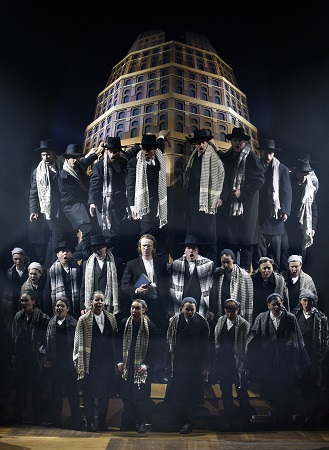 James Laing (Daniel) with the Sixteen and the Grange Festival Choruses. Photo credit: Simon Annand.
James Laing (Daniel) with the Sixteen and the Grange Festival Choruses. Photo credit: Simon Annand.
Under Daniel Slater’s imaginative direction this fully-fledged operatic conception included, in addition to the Brueghel-inspired Tower, three eye-popping acrobats whose perilous movements brought visual spectacle to Belshazzar’s lavish quarters and suggested that they, like the king and his sybaritic entourage, might be on the brink of disaster. Sharply delineated costumes neatly outlined national identities; brightly garbed party-set Babylonians, darkly clad Jews with traditional prayer shawls and, for the Persian army, military tunics straight out of Star Wars. Getting in and out of this attire was something of an achievement during one chorus where, in just a few bars, the marauding Persians morph into body-writhing Babylonians. That said, the Sixteen readily embrace these roles, entering into the spirit with undisguised relish and acting their parts as if born to them.
No less involved is Robert Murray’s impressively sung Belshazzar whose gilt-edged tenor dispatches demanding arias with ease and portrays a character whose excesses alarm and revolt. Clearly beyond the control of his long-suffering Nitocris, he is unrepentant after the Jewish prophet Daniel interprets the writing on the wall - a captivating scene bringing emotional trauma to both. Claire Booth is a richly characterised Nitocris, who brings clear cut credulity to a grieving and finally humiliated mother, her compassion and anxieties for her son movingly expressed in ‘Alternate hopes and fears distract my mind’. Only her romantic attachment to Daniel seems to a strike false note - one that reduces the honour of both parties and unnecessarily creates a degree of exaggerated melodrama. James Laing fashions a scholarly-looking Daniel and sings with reassuring eloquence, while Christopher Ainslie as a benevolent Cyrus dazzles more for his bravura rendition of ‘Destructive war, thy limits know’ while clinging onto the side of the ziggurat than his valour as a heroic champion of the Persians. By contrast, Henry Waddington’s son fixated Gobrias was sung with spirited vengeance.
What consistently claims attention is the discipline and vigour of the augmented chorus. The Sixteen bring emotional substance to their distinct roles (whether mocking, imploring or warmongering) and textural clarity to their contrapuntal lines. The score is driven along with a sureness of touch from the podium - Christophers drawing incisive, well-balanced orchestral playing, completely at home in this gem-filled score.
David Truslove
Belshazzar - Robert Murray, Nitocris - Claire Booth, Cyrus - Christopher Ainslie, Daniel -James Laing, Gobrias - Henry Waddington, Acrobats (Haylee Ann, Craig Dagostino and Felipe Reyes); Director - Daniel Slater, Conductor - Harry Christophers, Designer - Robert Innes Hopkins, Movement Director - Tim Claydon, Lighting Designer - Peter Mumford, The Grange Festival Chorus & The Sixteen.
The Grange Festival, Hampshire; Saturday 22nd June 2019.
Photo credit: Simon Annand
June 26, 2019
Kenshiro Sakairi and the Tokyo Juventus Philharmonic in Mahler’s Eighth
Famously, the Fourth, if not premiered first, was given the earliest recording by the New Symphony Orchestra of Tokyo under Hildemaro Konoye in May 1930; the Eighth was performed in Japan in December 1949, conducted by Kazuo Yamada, almost certainly the first time it was ever heard in the Far East.
There is a perfectly logical reason why Japan seems to have been so slow in embracing western classical music. In part, it is simply a factor of Japanese society which largely rejected outside cultural influences, especially before the Meiji Restoration of 1868. But what Japan lacked, which was not the case in either the United States or Europe, were music schools and decent orchestras to teach and play this music. Luther Whiting Mason, director of the Boston Music School, and the Munich-born Klaus Pringsheim, would both have a profound impact on the expansion of western music in Japan and its lineage through the twentieth century and onwards stretches from notable Mahler conductors beginning with Wakasugi, Kazuo Yamada, Akiyama and Ozawa through to Kobayashi and Inoue and a younger generation which includes Kazuki Yamada, Kentaro Kawase and Kenshiro Sakairi.
As an introduction to this new recording of Mahler’s Eighth, this diversion into the (briefest) of backgrounds is not strictly irrelevant because what we have here are the fruits of those earliest musical schools. The Tokyo Juventus Philharmonic doesn’t exactly think in terms of repertoire that is scaled down; in fact, all of its previous CDs have been of some of the most difficult and unforgiving works which would test many professional symphony orchestras. But then, this is not an ordinary youth orchestra, and Kenshiro Sakairi is a distinctly unusual conductor.
The Tokyo Juventus Philharmonic was founded in 2008 - originally under the name of the Keio University Youth Orchestra - and its first musicians were mainly high school students and members from the university. Today it has as many as 150 musicians. Like many western youth orchestras its repertoire is limited to a few concerts a year but what is particularly distinctive about the TJP is that it shares many of the characteristics of professional Japanese orchestras. That blended brass tone, the rich string sound, the distinctive woodwind phrasing and the precision of the playing are of an extremely high standard.
If there is a common thread which links youth orchestras it is often that the body of players is much larger than one would experience in most symphony orchestras we hear today in concert halls. Eight double-basses are the norm - not the thirteen we get in this Mahler Eighth. Arguably, the heft and weight, especially in the strings, probably doesn’t make this strictly necessary - listen to either recording of Sakairi’s Bruckner Eighth or Ninth and the richness of the cellos and basses, and even the violins, sometimes a weakness in many Japanese orchestras, makes for a thrilling sound, and would likely be so without the added strings. Sakairi is himself a patient conductor, one who takes his time over the music - it’s highly organic and is nurtured as such. The pauses and spaces he inserts between notes, the acknowledgement of bar rests, are more than a nod to a conductor like Celibidache, or even late Asahina.
It's certainly clear this is a musical partnership which is getting better - their Mahler Third, recorded in 2017, perhaps got lost in some parts, where a focus on orchestral beauty became a template for a loss of perspective elsewhere (though Sakairi is by no means the first conductor to be trapped by this symphony’s problems). On the other hand, an unreleased Mahler Second from a year earlier is tremendously powerful for quite the opposite reason - it sacrifices some orchestral beauty for an unswerving relentlessness and swagger. A Bruckner Ninth, from January 2018, is a colossal performance - it’s visionary, prepared with meticulous attention to detail, and yet so extraordinarily intense and fresh. This most recent recording of Mahler’s Eighth is at least as striking.
Although CD issues of Mahler Eighth have become more frequent - and in Japan there had been eleven prior to this recording - by a strange quirk, and less than a week after this Sakairi performance, another was given, by Kazuhiro Koizumi and The Kyushu Symphony Orchestra, and that, too, has just been released on Fontec. Can you have too much of a good thing? Well, yes and no. For many years, Takashi Asahina’s Osaka Philharmonic recording, performed in 1972, was the first and only one available - and it remains to this day one of the best from Japan. One could question the idiomatic accuracy of the singing - but what Asahina does with the symphony is often compelling. Yamada’s 1979 recording with the Tokyo Metropolitan Symphony Orchestra was done thirty years after his Japanese premiere of the work - and is the most detailed, perhaps most convincing performance to date. Others, like Wakasugi (who recorded the first complete Mahler cycle in Japan), Inoue and Kobayashi seem both overwhelmed and lost in the scale of this symphony. Of the two western conductors to have recorded with Japanese orchestras, Bertini has a narrow edge over Inbal.
Kenshiro Sakairi’s recording is incredibly detailed; in fact, it’s meticulously so in a way almost very few Mahler Eighth’s are. This orchestra and conductor’s precision - in the sense that every note is in place, the feeling that every facet of the score has been followed - works for and against them. When I first listened to this CD I was so blown away by the orchestra, their tone, the finesse and articulation of the woodwind, and the sheer opulence of the sound generated that the measure of the symphony’s scale rather eluded me. It’s only on a second listening I became fully aware of the electrifying performance that Sakairi gives. Quite how this would have worked in the concert from which this performance is taken is a question I have yet to definitively answer for myself.
As is common with most of the TJP/Sakairi recordings - most notably the superlative Bruckner Ninth - it is the singularity of the symphonic line, the ability to take this music in an arc which is so hugely impressive. I don’t think Sakairi takes his cue from many of the Japanese performances he probably grew up with - rather, the influence that seems most striking is that of Bernstein. He is only marginally slower than Bernstein’s LSO recording, though timings are deceptive. The pace Sakairi sets - and generally holds - is swift but the structure, whether in Part I or Part II, retains a formidable flow and smoothness, and I don’t mean smoothness in an ineffectual or unimposing way. The clarity of the variations in Part II, where many conductors sectionalise this symphony, isn’t patched together - it has a very fluid narrative. And if this is an orchestra with a powerful sound, the whole of the opening of Part II, that wonderfully mysterious orchestral prelude, is actually magical and haunting. There is much in this performance which suggests collision - but there is much which swings the opposite way towards heavenly enlightenment.
How far the pathos, or spirit of redemption, or even the profoundly complex journey into Faust’s soul, which is a powerful force in this symphony could, or might, confound a young orchestra or conductor, throws up some interesting contrasts with other recordings. Sakairi is barely over thirty; Asahina and Yamada were well into their sixties when their recordings were made. Few might expect a younger man to empathise so directly with the concept of mystery - yet, it’s here. It was there in his Bruckner Ninth. Yamada’s recording might be convincing in many respects, but it’s arguable thirty years after his premiere his vision of this symphony had changed. As was common with many Yamada performances in his later years, tempo could be wildly disjointed, and that is the case here. He speeds up, and slows down, with disturbing frequency. Asahina is perhaps more stable. But what disfigures both performances is the quality of the playing, which is erratic at best, and simply inferior at worst. Asahina is prone to take his time; Yamada tends to navigate a more ill-disciplined route.
Sakairi and the TJP play with quite sublime brilliance, and the recording exposes them to quite a high degree of scrutiny. As is common with many Altus CDs, the engineering is first rate - though perhaps some might find the choral forces a little recessed. The focus here can sometimes be very much on the orchestra and the soloists. That ‘exposure’ works in many ways: the orchestra can sound unusually dark (though I personally like their sound), the tendency to spotlight instrumental solos is often ravishing. The opening to the ‘Chorus Mysticus’ is astounding, mystical, hushed and deeply moving. How the chorus just floats above the orchestra and the soprano gently rises through them both is beautifully captured by the microphones. But to be able to not overblow the climax as well says much for both the careful attention to dynamics from Sakairi and the outstanding engineering.
What of the singing itself? It’s undoubtedly the case that in the past Japanese choirs and soloists have found German a problem; that is less true today. Most, if not all, of the singing on this Mahler Eighth is comfortably pronounced, and more so given the heady tempo which Sakairi sets for them. Is there enough contrast in the soloists? Yes, I think there is, especially in the trio of sopranos who sing with gorgeous precision and colour. Shimizu Nayutu, as Pater Profundis, is superb - a deep, rich bass, sounding suitably tortured. Likewise, Miyazato Naoki manages the high tessitura of Doctor Marianus with flawless technique. Both the NHK Children’s Choir and the Tokyo Juventus Philharmonic Choir are superb.
This is unquestionably the finest Mahler Eighth yet to emerge from Japan. However, I’d go a bit further than this - it leaves a lot of Mahler Eighths recorded in the United States and Europe rather in the shade as well. There is a blend of the orchestral and the vocal here, the redemptive and the dramatic, which is enormously compelling. It helps it has been captured in beautiful sound, but the performance is entirely gripping. Much of it is simply electrifying - many Mahler Eighths, rather elusively, aren’t. All in all, a magnificent disc.
Marc Bridle
Soprano 1 (Moritani Mari), Soprano 2 (Nakae Saki), Soprano 3 (Nakayama Miki), Alto 1 (Akira Taniji Akiko), Alto 2 (Nakajima Keiko), Tenor (Miyazato Naoki), Baritone (Imai Shunsuke), Bass (Shimizu Nayuta), NHK Tokyo Children's Choir (Choral Conductor: Kanada Noriko), Tokyo Juventus Philharmonic Choir (Choral Conductor: Tanimoto Yoshi Motohiro, Yoshida Hiroshi)
image=http://www.operatoday.com/Mahler%208%20%281%29.jpg image_description= product=yes product_title= Gustav Mahler: Symphony No.8; Tokyo Juventus Philharmonic/Kenshiro Sakairi; ALTUS 012/3; recorded live 16th September 2018, Muza Kawasaki Symphony Hall, Japan; available from HMV Japan. product_by=A review by Marc Bridle product_id=June 25, 2019
Don Giovanni in Paris
Et voilà, one of the great evenings in the theater. And yes, it was not subtle.
Conductor Jordan immediately pounced on the musical tensions that structure late eighteenth century music and did not let go. The ensuing, unrelenting drama from the pit creating the antagonism between Giovanni and Leporello, with Leporello cruelly rubbing in Giovanni’s sexual exploits to Elvira, Masetto angrily snapping at Zerlina, Giovanni coldly setting up the ambush of Leporello.
Don Ottavio took resolute charge of the vengeance to come, Giovanni brutally beat-up Masetto. Donna Anna, horrified at her aggressor, selfishly cruel to Don Ottavio. Elvira doggedly chased Giovanni, Giovanni focused full determination to seduce the perfect woman. Leporello, finally losing all patience with Giovanni, picked up the Commendatore’s dinner table and threw it across the room.
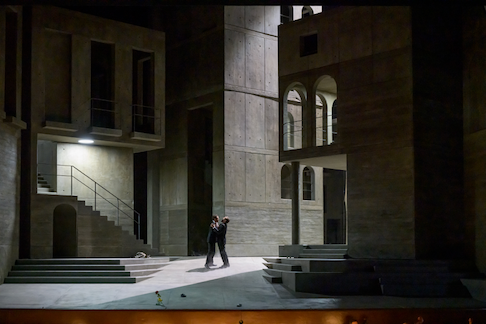 Don Giovanni and Leporello
Don Giovanni and Leporello
Giovanni went straight into the seething hell that had been leaking steam through the stage floor from the downbeat of the overture.
And, by the way, Mozart wanted three orchestras on the stage for the Act I finale. There they were, no room for much else, the country dance and the waltz chiming in with the minuet to create a quite Classical idea of cacophony to match the mess on stage.
This Don Giovanni is a gloves off release for all your pent up Don Giovanni hostilities. No wimpy Don Ottavio, no Freudian Donna Anna. No bumbling Masetto or cute Zerlina, no heroic or lonely or debauched Giovanni.
It was pure Mozart, and it was pure Don Giovanni, no questions asked.
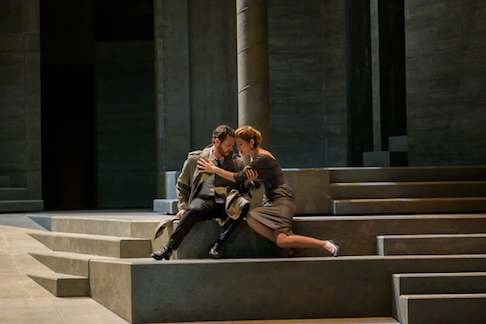 Philippe Sly as Leporello impersonating Don Giovanni, Nicole Car as Donna Elvira
Philippe Sly as Leporello impersonating Don Giovanni, Nicole Car as Donna Elvira
To accomplish this musical and dramatic feat the Opéra de Paris assembled a very handsome cast indeed of fine, beautifully voiced young singers who confronted one another face to face when not nose to nose. Giovanni tall, slim and bearded, Leporello tall, slim and bearded (no Act II suspension of disbelief necessary), Donna Anna obviously very worthy prey, Masetto wiry, sharp witted and energetic, the Commendatore towering in presence and in voice.
Thus it is no understatement to say the the evening was an orgy of Mozartian phrasing, maestro Jordan’s orchestra sharply defining the musical parameters, carving out strategic dramatic plains against which the vocal lines etched themselves.
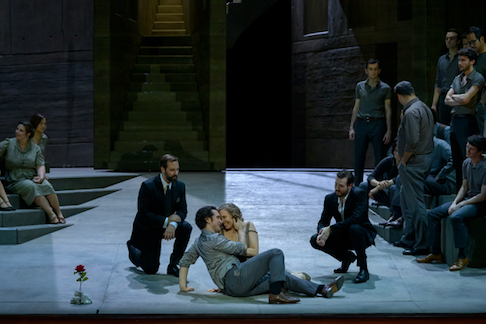 Étienne Dupuis as Don Giovanni, Mikhail Timoshenko as Masetto, Elsa Dreisig as Zerlina, Philippe Sly as Leporello
Étienne Dupuis as Don Giovanni, Mikhail Timoshenko as Masetto, Elsa Dreisig as Zerlina, Philippe Sly as Leporello
The unique colors of each of the voices defined its character — the suavity of the Don’s Act II serenade, the sophistication of Leporello’s “Madamina,” the narcissism of Donna Anna’s “Non mi dir,” the voluptuous of Donna Elvira’s “Mi tradi,” the confidence of Don Ottavio’s “Il mio tesoro” (though sung partly in fetal position), the free and easy sexuality of Zerlina’s “Vedrai carino.”
With a virtuosity and sense of phrasing surely equal to the voices designer Jan Versweyveld lighted his concrete walls, pulling out components of its geometric shapes in light and dark grey based colors, save the saturated gold that flooded the stage for the masked trio “Protegga, il giusto cielo.” Designer Versweyveld served as well as the dramaturg of the production.
Stage director Ivo van Hove and conductor Philippe Jordan created a production that took Mozart’s masterpiece to its bare bones with a myriad of hidden sophistications. This Don Giovanni is a daring creation of great wit and profound sensitivity to Mozart’s masterpiece.
French bass-baritone Etienne Dupuis was Don Giovanni, Canadian bass-baritone Philippe Sly was Leporello. American soprano Jacuelyn Wagner was Donna Anna, Australian soprano Nicole Car was Elvira. French tenor Stanilas de Barbeyrac sang Don Ottavio. Russian Mikhail Timoshenko and Franco-Danish Elsa Dreisig were the Masetto and Zerlina. Estonian bass Ain Anger sang the Commendatore.
Opera and theater director Ivo van Hove directs Kurt Weill’s The Rise and Fall of the City of Mahagonny at the Aix Fesitival next month (July). Note that this Don Giovanni travels to the Metropolitan Opera next year. Conductor Philippe Jordan this summer again conducts the deconstructed Die Meistersinger at the Bayreuth Festival.
The understated, simple costuming for this production was created by An D’Huys, the impressive hell video was created by Christopher Ash.
I saw the fourth (June 21, 2019) of eleven performances.
Michael Milenski
image=http://www.operatoday.com/Giovanni_Paris1.png
product=yes
product_title=Don Giovanni at Palais Garnier
product_by=A review by Michael Milenski
product_id=Above: Jacuelyn Wagner as Donna Anna, Etienne Dupuis as Don Giovanni, Anger as Don Pedro (Donna Anna's father)[all photos copyright Charles Duprat, courtesy of the Opéra de Paris]
June 24, 2019
Lyric Opera of Chicago’s 2020 Ring Cycle
By the start of next spring’s cycles, the team of singers, musicians, and production staff will have worked together for an extensive period of four seasons, sufficient time to yield a collaborative effort of exciting potential. The Lyric Opera Orchestra will be led throughout by Its music director, Sir Andrew Davis, whose commitment to the works of Wagner has contributed markedly to the reception of the first three operas to date.
While the individual operas of the cycle have generated enthusiasm based on their specific artistic merits in Lyric Opera of Chicago’s recent productions, the opportunity to experience the totality of the Ring as a unified, continuous series will offer a rare event of collaborative forces. In Das Rheingold, the first opera or essentially the prologue to the following three operas, both devices and personalities forge a path into the forthcoming stories of love, power, and loyalties. The structural use of elevation, both mobile and stationary, has a binding effect that distinguishes specific scenes yet prompts the viewer to appreciate thematic and musical ties existing with the following operas. The Rhinemaidens hover aloft on mechanical lifts raised and lowered or propelled by supernumeraries as the maidens sing of the sun and gold. Their gracefully produced music undulates with the mechanized flow of the crane-like lifts. In subsequent scenes the giants emit their menacing bluster from atop moving towers. such a placement effectively emphasizing their power and size. Comparable yet stationary towering structures flank the stage in the following opera, Die Walküre, here used to indicate an oppositional relationship between the warriors Siegmund and Hunding. Once the identity of Siegmund becomes apparent in the first act, each warrior appears seated at the base of one of the opposing towers, each of these figures staring forward grimly in anticipation of future conflict. This battle takes place at the conclusion of the following act with either warrior positioned midway upon the respective, elevated structure, the gods and their kin intervening in the remaining space. In Siegfried the locale of the smithy in the forest is fashioned appropriately with flat lines, yet the development of the protagonist must transcend the realm of Mime and Alberich. In response to the elevated, coaxing calls of the Forest Bird, sung in last season’s new production with thrush-like intonations by Diana Newman, Siegfried, as performed by the impressive Burkhard Fritz, indeed follows an upward path until he reaches the sleeping Brunnhilde. Their joyous scene of burgeoning emotions is then celebrated on this raised portion of the stage. It will be exciting to trace further structural parallels in next season’s new production of Götterdämmerung and to anticipate comparable insights in the complete Ring cycles beginning in April 2020.
Lyric Opera of Chicago has assembled a superlative cast for this project, a team of singing performers associated both nationally and internationally with their respective roles. Perhaps most striking thus far has been the depth of character that the singers bring to their roles. Christine Goerke’s definitive Brunnhilde captures the excited involvement of a battle-maiden when assisting Siegmund, the wounded penitence of a disobedient daughter in her in her extended dialogues with Wotan, and the boundless promise of romantic love when awakened by the hero Siegfried. Likewise, the Wotan of Eric Owens moves from his adventurous complicity in Das Rheingold to the part of defensive mate and angry parent in Die Walküre, before taking an integral hand in Siegfried’s development in the following opera. Also returning in the complete cycle is the incomparable Stefan Margita, whose Loge in Das Rheingold propels the action and prepares the stage for subsequent confrontations in the following operas of the cycle. Tanya Ariane Baumgartner reprises her imperious Fricka in an elegantly idiomatic interpretation. Elisabeth Strid and Brandon Jovanovich create an unforgettably lyrical pair of siblings. Mathias Klink makes a tour de force of acting and singing as Mime, and Ronita Miller will perform her deeply felt and pivotal depiction of Erda.
Performances of the complete Ring cycle will take place in successive weeks with following schedule:
Cycle 1
Das Rheingold, Monday 4/13/20, 7:30 p.m.
Die Walküre, Tuesday, 4/14/20, 6:00 p.m.
Siegfried, Thursday, 4/16/20, 6:00 p.m.
Götterdämmerung, Saturday, 4/18/20, 5:30 p.m.
Cycle 2
Das Rheingold, Monday 4/20/20, 7:30 p.m.
Die Walküre, Tuesday, 4/21/20, 6:00 p.m.
Siegfried, Thursday, 4/23/20, 6:00 p.m.
Götterdämmerung, Saturday, 4/25/20, 5:30 p.m.
Cycle 3
Das Rheingold, Monday 4/27/20, 2:00 p.m.
Die Walküre, Wednesday, 4/29/20, 2:00 p.m.
Siegfried, Friday, 5/1/20, 2:00 p.m.
Götterdämmerung, Sunday, 5/3/20, 2:30 p.m.
Click here for additional information.
Click here for the text of Richard Wagner’s The Nibelungen-Myth. As Sketch for a Drama.
Salvatore Calomino
image=http://www.operatoday.com/Chicago_Ring.png image_description=Image by Lyric Opera of Chicago product=yes product_title=Lyric Opera of Chicago’s 2020 Ring Cycle product_by=By Salvatore Calomino product_id=Above image courtesy of Lyric Opera of ChicagoIrish mezzo-soprano Paula Murrihy on Salzburg, Sellars and Singing
Sellars will return to the Salzburg Festival this summer to present a new production of Idomeneo. It reunites him with conductor Teodor Currentzis, following their acclaimed 2017 interpretation of Mozart’s La clemenza di Tito, which highlighted the opera’s vision of a path to democracy through restorative justice and reconciliation, and also with musicAeterna Choir of Perm Opera and tenor Russell Thomas as the eponymous king. Among the cast will be Irish mezzo-soprano Paula Murrihy who performed with Thomas when Sellars’ La clemenza was staged at Dutch National Opera in May 2018, and who will take the role of Idamante. I spoke to Paula on the eve of her departure for Salzburg to begin rehearsals.
Preparing for my conversation with Paula, I noted with surprise that it is ten years since I heard her sing - at the Wexford Festival in 2009 , where I enjoyed her performances as Cherubino in John Corigliano’sThe Ghosts of Versailles, Hélène in Chabrier’s Une education manqué (alongside Kishani Jayasinghe’s Gontran) and in recital with Irish baritone Owen Gilhooly, when songs by Brahms and Duparc were partnered by some Irish folk-songs and audience participation.
Such eclecticism has been characteristic of her career. And if her repertoire has been varied then so have the venues in which she has created these diverse roles. While she has performed in the UK - with English National Opera and at Covent Garden in 2014 for example - it’s on the international stage that she has largely forged her path - with Opéra de Nice, Santa Fe Opera, Opera Theatre Saint Louis, Los Angeles Opera, Oper Frankfurt, Opernhaus Zürich, Dutch National Opera, Oper Stuttgart, Chicago Opera Theater, and Boston Lyric Opera, to name just a few.
Paula’s travels began after her initial studies in Dublin, when she travelled to North America, for further study at the New England Conservatory. Subsequently, Paula participated in the Britten-Pears Young Artist Programme, San Francisco Opera’s Merola Program and was an apprentice at Santa Fe Opera. Paula explains to me that, having been ‘spotted’ when taking part in a competition in Germany in 2007, she joined Frankfurt Studio Opera in 2008 and a year later became a member of the Ensemble at Frankfurt Opera, where she remained until deciding to become a freelance singer two years ago.
Her time in Frankfurt gave her the opportunity to sing many roles at the right time for her voice. It also meant that she didn’t get ‘pigeon-holed’ in a particular genre and was able to explore a wide-ranging repertoire. She recalls one three-day period when she sang Medoro in Vivaldi’s Orlando Furioso on Friday, transformed herself into Mozart’s Dorabella (Così) the following evening, and then took a role in Parsifal (Flower Maiden) on Sunday! Alongside ‘central’ repertory such as Der Rosenkavalier, Hänsel und Gretel and Carmen, she had the opportunity to explore the operatic fringes, taking the roles of Lazuli in Chabrier’s L’étoile and Kreusa in Aribert Reimann’s Medea.
Being an Ensemble member brings security, of course, but as Paula points out companies are themselves protean entities, and two years ago the time seemed right for some changes, professionally and personally, as she wanted to spend more time at home in Ireland. 2017 saw her make her debut at the Metropolitan Opera in New York, as Stéphano in Roméo et Juliette, and return to Santa Fe Opera as Ruggiero in Alcina and as Die Fledermaus’s Orlofsky. And, in April 2018 she appeared at the Teatro Real Madrid for the first time - as Frances, Countess of Essex in David McVicar’s production of Gloriana.
Recently, UK audiences have had the opportunity to enjoy Paula’s performances. In January this year she sang Mahler’s Lieder eines fahrenden Gesellen with the Britten Sinfonia and Sir Mark Elder, and recently appeared in recital at Wigmore Hall with Malcolm Martineau. Performing on the recital platform is clearly something that Paula is keen to do more regularly. She studied lieder and French song during her time as a Britten-Pears Young Artist, with Martineau, Ann Murray and Robert Tear, and tells me that she loves these “miniatures”: “There are so many eras, so many worlds, so many voices … it’s an enormous amount of work learning a recital programme, but immensely rewarding. Together with the pianist the singer has to create an entire world: it’s a collaborative journey during which this world has to be imagined - there’s a lot of thinking! - then brought into being, then let settle. And, in performance there’s always an intimacy between singer and audience, even if the concert hall is large; the audience have to come to the singer and take in the different worlds created.”
But, first comes Idomeneo in Salzburg. Sellars’ has spoken about his new production : “One passage in the libretto reads: ‘Saved from the sea, I have a raging sea, more fearsome than before, within my bosom. And Neptune does not cease his threats even in this.’ That is what Mozart’s music is about.” Remarking that the Greeks’ pride in winning the Trojan War was self-deceiving and foolish - “on the way home, the ocean said: No, you didn’t win. Everybody lost. And the ocean started breaking their ships apart” - Sellars imagines Idomeneo as “the opera that describes the angry oceans, what it means to negotiate with the oceans for the future of the next generation.”: “where we are with global warming is exactly where Mozart was with this opera: an older generation still not getting it, and a younger generation already on the case in very exciting ways.”
While Paula is still to learn of the details of Sellars’ conception, she knows that the director sees a ‘radicalism’ in the work and the elements of youth and sacrifice will be highlighted. She’s certainly “open to any ideas”. One element that does strike me as interesting and potentially controversial is Sellars’ decision to excise much of the recitative, something that he also did in La clemenza di Tito into which he interwove other music by Mozart, such as the Mass in C minor and the Masonic Funeral Music. In Sellars’ words, “the music is orchestral from beginning to end. Which means that the usual quality of these Enlightenment operas - the fact that everybody explains what they’re about to do before they do it - is gone. The audience has no idea why people are doing anything. So, it becomes much more like a movie: you’re plunged into the situation. It creates suspense.”
Having sung the role of Sesto when Sellars’ production of La clemenza was seen at Dutch National Opera, Paula is familiar with this practice. Interestingly, just a few months before, in October 2017, she had sung the role with the Orchestra of the Eighteenth Century and Cappella Amsterdam at the Concertgebouw, in a semi-staged performance. One could “hear every word of the recitative,” she explains, which, through text and gesture, created a “beautiful intimacy between Sesto and Tito”. The Sellars/Currentzis production, during which Paula was on stage for almost the entire performance, was a very different experience but one which she “adored”, valuing Sellars’ belief and integrity. And, she appreciates what Sellars was trying to achieve. She explains that in Idomeneo the omission of the opening recitative means that Idamante’s first line is ‘It’s not my fault’: “There’s a big backstory to create, and a narrative of love”. In any case, she laughs, apparently Mozart wasn’t that keen on recitative either and wanted to cut back!
It’s not Paula’s first appearance at the Salzburg Festival. She performed the Second Lady in Mozart’s Die Zauberflöte in July 2018, alongside Matthias Goerne, Mauro Peter, Christiane Karg and Albina Shagimuratova, in a staging by American director Lydia Steier and with Constantinos Carydis conducting the Vienna Philharmonic. It’s a role which she has sung many times before, and it was her first role at Frankfurt. Paula reflects that while it’s nice to repeat a role, she also loves learning new parts - she is soon to sing her first Donna Elvira with Orchestra of the Eighteenth Century, for example. I ask her if she has any particularly strong ‘musical leanings’, and she replies that she has an affinity for the Baroque, which has always seemed to her to share certain elements with Irish folk music. An improvisational quality, I wonder, or the primary of the voice? Paula suggests that the colours and clarity of the two genres seems in accord, and that there is a certain “vulnerability” which is present in both Baroque opera and Irish folk song.
She also especially likes singing in French, both in recital and in opera, as she feels that the language particularly suits her voice. At the end of the year she will sing Faure’s Pénélope for the first time, in Frankfurt, and looking ahead she would love to have the opportunity to sing Charlotte (in Massenet’s Werther) or Marguerite (in Berlioz’ La damnation de Faust). Opera casting agents, take note!
But, to return to the present, it’s the end of a long day, during which the next day’s travel plans seem to have unravelled! Despite this, Paula is generous, warm and self-effacing during our conversation. And, she’s obviously keen to begin rehearsals for Idomeneo. Reading about Sellars’ and designer George Tsypin’s plans to project images onto the rock walls of the Felsenreitschule throughout the opera, “floating up, floating down across this entire surface”, and at the end to “flood” the entire stage - “incredible footage of the plastic that is destroying the ocean right now and is in every one of our bloodstreams at this moment … will be projected onto the stone [here] - which is transformed into an underwater ruin” - one imagines that it’s going to be an exciting and thought-provoking experience.
Peter Sellars’ new production of Mozart’s Idomeneo opens the Salzburg Festival on 27th July.
Claire Seymour
image=http://www.operatoday.com/Paula%20Murrihy%20Barbara%20Aum%C3%BCller.jpg image_description= product=yes product_title=Paula Murrihy sings Idamante in Peter Sellars’ new production of Idomeneo in Salzburg product_by=An interview by Claire Seymour product_id=Above: Paula MurrihyPhoto credit: Barbara Aumüller
A riveting Rake’s Progress from Snape Maltings at the Aldeburgh Festival
On the way he discards the ever faithful and appropriately named Anne Trulove and succumbs to the temptations of Nick Shadow in the guise of the devil whose news of a windfall inheritance catapults Tom to a dissolute life in London where he marries the bearded Baba-the-Turk, plunges into a financially ruining bread-making scheme and, after defeating his alter ego at cards, dies grieving for his beloved Anne in an asylum.
Grim stuff, but it’s an opera suited to the talents of young singers who in this case were hand-picked musicians belonging to Barbara Hannigan’s Equilibrium Young Artists - a mentoring initiative for young professional musicians created in 2017 and here at Snape making their UK debut. This Rake’s Progress was the grand finale of a series of European performances which had been launched in Sweden at the end of last year. The production has been a semi-staged affair from the start and any potential issues over balance and space that might have been perceived in advance at Snape (where all the players and singers occupy a single performance area) were immediately dispelled. That said, Linus Fellbom’s directorial note in the programme book indicating the use of a performing ‘box’ (used in earlier outings) had to be ignored; this production left the performers free rein to use the stage directly in front of the orchestra. Of course, much was left to the imagination so that Mother Goose’s brothel and Sellem’s junk-filled auction were left to the mind’s eye. But with acting and singing as distinguished as this, there was little needed in the way of visual signposting to hold the ear and eye. Without pauses for scene changes the action rattled along with obliging swiftness.
That’s all credit to Hannigan (whose opera conducting debut this is) and Fellbom who, in the absence of any set and props (not forgetting much atmospheric lighting) provided sharply defined characters helped by some thoughtfully conceived costumes - Tom ironically dressed in ‘pure’ white and everyone else, including the innocent Anne, chorus and on-stage orchestra, clad in funereal black with gender fluid overtones for Shadow, whose culotte-like trousers might as well have been a skirt.
The cast was led by the young Welsh tenor Elgan Llŷr Thomas as the feckless Tom, whose brightly lit tone swept through the score from the opening duet through to “death’s approaching wing”. Able to command facial expression with ease, whether shame, frustration or child-like naivety when incarcerated in Bedlam, Thomas gave a truly persuasive portrait and his attempt to define love was particularly touching. There was no lack of chemistry between him and Greek soprano Aphrodite Patoulidou as a pure-toned Anne Trulove. Notwithstanding a slightly pressured Act 1 ‘Quietly night’ (here just slightly too fast to be as poignant as it can be), her Cabaletta had just the right steely determination and her closing lullaby, ‘And no word from Tom’, wonderfully tender, its heartbreak delivered the evening’s emotional climax.
Guadalupen-born Yannis Francois gripped throughout as the flamboyant Nick Shadow, a gentlemen’s gentleman whose ample baritone and insidious presence peaked in a compellingly wrought card game. Of the remaining cast, Fleur Barron was a generously hirsute and idiosyncratic Baba the Turk, James Way a confident man-about-town Sellem and Antoin Herrera-Lopez Kessel doubled as a timid but sympathetic Father Trulove and androgynous Mother Goose. A meticulously prepared chorus excelled as whores and roaring boys, auction bidders and madmen, and strikingly taut instrumental support came from the Ludwig Orchestra whose players (including Edo Frenkel on the harpsichord) brought much luminous detail to Stravinsky’s chugging rhythms and spiky outlines - the whole dispatched with Mozartian clarity. Praise too must be heaped on Hannigan whose incisive direction and unflagging pace electrified from the start, her minimal gestures sparking life into those opening fanfares and her keenly sensitive ear securing an ideal balance between her vocal and instrumental forces. In short, Hannigan and Fellbom nailed this unstaged Rake to release its emotional energy with dramatic power. Among the outstanding singers of Equilibrium are stars in the making.
David Truslove
Tom Rakewell - Elgan Llŷr Thomas, Anne Trulove - Aphrodite Patoulidou, Nick Shadow - Yannis Francois, Baba the Turk - Fleur Barron, Sellem - James Way, Father Trulove / Keeper of the Madhouse/Moose Goose - Antoin Herrera-Lopez Kessel, Director/Design/Lighting - Linus Fellbom, Conductor - Barbara Hannigan, Ludwig Orchestra & Chorus of Opera Holland Park.
Snape Maltings Concert Hall; Thursday 20th June 2019.
image=http://www.operatoday.com/BH%20Musacchio%20Ianniello.jpg image_description= product=yes product_title=The Rake’s Progress: Snape Maltings Concert Hall, Aldeburgh Festival 2019 product_by=A review by David Truslove product_id=Above: Barbara HanniganPhoto credit: Musacchio Ianniello
June 21, 2019
The Gardeners: a new opera by Robert Hugill
‘A Soldier’s Cemetery’, bridging past and present and future, as imagined by Sergeant John William Streets, who was killed and missing in action on 1 st July 1916, aged 31.
The lands where the ‘fallen’ rest summon strong emotions: sorrow, shock, nostalgia, disbelief, anger. From the fields of Flanders where, in the words of John McCrae, ‘the poppies blow/Between the crosses, row on row’, to Owen Sheers’ Mametz Wood, where ‘For years afterwards the farmers found them -/ the wasted young turning up under their plough blades … A chit of bone, the china plate of a shoulder blade,/ the relic of a finger, the blown/ and broken bird’s egg of a skull’, the landscapes which are ‘home’ to those who gave their lives in war seem to resonate with the words of the dead as they try to speak, through the earth, to the living. Having visited the British War Cemetery at Bayeux, Charles Causley wrote:
I walked where in their talking graves
And shirts of earth five thousand lay,
When history with ten feasts of fire
Had eaten the red air away.
If such places are redolent with elegy and emptiness, rage and nostalgia, it is almost painful - in these troubling political times, at home and abroad - to remind ourselves that much of British history is built upon conflicts waged overseas. But, the gardeners who tend the cemeteries maintained by the Commonwealth War Graves Commission honour the fallen as a labour of duty and love, ensuring that the 1.7 million people who died in the 20th century’s two World Wars are remembered. The Commission maintains cemeteries and memorials at 23,000 locations in 153 different countries.
It was an article in the Daily Telegraph in May 2017 about three generations of a family who tend the graves at one such cemetery in Palestine, chanced upon by Robert Hugill, that sowed the seeds of the composer’s ten-scene opera The Gardeners, which, lasting a little over an hour, was premiered at Conway Hall earlier this week. It’s an opera in which The Dead (there are Joycean undertones here) trouble, console and nurture the living.
Reading Joanna Wyld’s prose libretto - which fluently incorporates selected phrases adapted from A.E. Housman and Rabindranath Tagore - I was reminded again of the poets’ voices which urge and enable the departed to carry their messages from the past to the present:
From McCrae’s Flanders’ fallen, so keen to urge us, ‘We are the Dead. […] Take up our quarrel with the foe:/ To you from failing hands we throw/ The torch; be yours to hold it high.’; to Kipling’s ‘The King’s Pilgrimage’ (an account of King George V's 1992 Visit to War Cemeteries in France (Kipling whose only son John was killed in action at the Battle of Loos in 1915, joined the newly founded Imperial (now Commonwealth) War Graves Commission in 1917, and was the first Literary Advisor to the Commission); to Sheers’ ‘twenty men buried in one long grave’: ‘As if the notes they had sung/ have only now, with this unearthing, slipped from their absent tongues.’
Wyld’s libretto charts the generational conflicts and conversations, cyclical returns and resolutions of three men - a grandfather, a father and a son - whose sense of duty and affinity is diluted as the years pass. While the Old Gardener is in daily communion with The Dead, The Young Gardener (his grandson, an Angry Young Man) resents the presence on and in his soil of an ‘invading’ force. Two female members of this generational palimpsest seek to urge unity and understanding. Emotional crises are followed by epiphanies.
Peter Brathwaite’s Old Gardener was a wonderfully compelling figure even within the concert-staged format; his terrific diction, emotive delivery, focused tone and nuanced phrasing really shook one from one’s complacency. As his son, bass-baritone Julian Debreuil had real presence, using his vocal strength and vivid colour to convey absorbing immediacy. Hugill was well-served by both of these singers who know how to make something of a musical phrase.
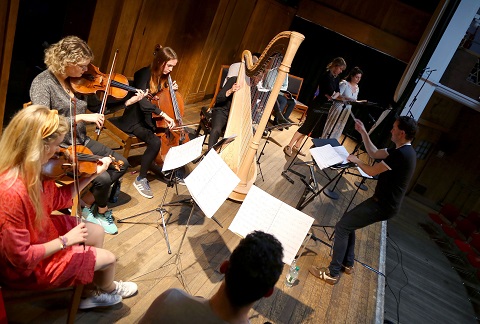 William Vann conducts The Gardeners
William Vann conducts The Gardeners
As the Young Gardener, countertenor Magid El-Bushra didn’t initially make his presence felt; he lacked projection, nuance of phrasing and variety of colour - though to say that his singing was ‘just’ beautiful is hardly a criticism! It was not until the collapse of his grandfather, though, that the Angry Young Man was dramatically and vocally ‘transfigured’; and in repeating his grandfather’s words at the close, the Young Man’s reverence, commitment and belief were made entirely credible. Now we had some sense of character; and, tension and a dynamic relationship with the instrumental lines: ‘We should take up arms/And fight! Show the oppressors/ Who they’re dealing with.’
Flora McIntosh’s Grandmother made a strong mark and used her lower range very emotively and dramatically; her conflict with her grandson was one of the performance’s most dramatically compelling moments. Similarly, the duet for the Grandmother and Georgia Mae Bishop’s Mother made one reflect that perhaps Hugill might have fruitfully included more dramatic ensembles.
The Dead were represented by a male vocal group, singing, with a fitting balance of unrest and assurance, from a gallery in the Conway Hall. The instrumental accompaniment - a five-piece ensemble comprising violin, viola, cello, clarinet and harp - was sensitively played, directed by William Vann with scrupulous attention to detail and appreciation of the pace of the musico-dramatic unfolding. Oliver Wass’s harp had a primary role and he made sure that the motivic repetitions made their mark. But, I did feel that, even with the small forces at his disposal, Hugill might have reached for greater timbral variety; in particular, I missed a strong bass line, as well as diversity of tempo.
That said, Hugill’s music has a moving serenity and stillness; perhaps more variety of pace and colour would be needed to sustain engagement in the theatre, but on this occasion the spiritual focus of the music seemed assured.
I’m not sure that Wyld’s libretto, for all its sensitivity of utterance, aids vocal diversity and characterisation. Its rhythms dictate a declamatory arioso. At times when this declamation is foregrounded the effect is strong; as when, to harp accompaniment, the Old Gardener tries to explain to the misunderstood Dead - ‘People hear that they wish to hear. Believe what they wish to believe. This is how it is. Nobody agrees.’ Similarly, when the Old Gardener and his son call upon The Dead to speak to their troubled young descendant - ‘You burdened our hands that we might lighten them./ You left us in the dust to create your heaven’ - the harp’s striking support of their lines makes a strong impact.
There are variations of tone in the text: the exchanges between the Grandmother and Mother are both more intimate and relaxed, and humorously prickly. This was not perhaps always evident in the musical setting.
Many times during this performance I was reminded of the five Canticles of Benjamin Britten. I wonder if Hugill’s The Gardeners is less opera and more cantata? There are instrumental interludes between the scenes, and they often provide change of pulse and temperament, but I found it quite hard to imagine how these might be ‘dramatised’, and there seems to be no particular need for a change of location or scenery that the interludes might facilitate. But, it would be interesting to see the work staged to see what the composer envisages.
Overall, there is a formality, of a ritual and spiritual kind, that this opera observes consistently and with considerable impact. The Angry Young Man’s final words are of reassurance and hope - ‘I will tell them, brothers. They will listen.’
Claire Seymour
The Old Gardener - Peter Brathwaite, The Gardener - Julian Debreuil, The Angry Young Man - Magid El Bushra, The Mother - Georgia Mae Bishop, The Grandmother - Flora McIntosh, The Dead [Andrew Henley, William Davies, Chris Lombard, Angus McPhee, Jake Muffett]; William Vann - conductor, Oliver Wass (harp), Charlotte Amherst (violin), Joanna Patrick (viola), Sophie Haynes (cello), Anthony Friend (clarinet).
Conway Hall, London, Tuesday 18th June 2019.
image=http://www.operatoday.com/Peter%20Brathwaite%20%28The%20Old%20Gardener%29.jpg image_description= product=yes product_title=The Gardeners: a new opera by Robert Hugill, at Conway Hall product_by=A review by Claire Seymour product_id=Above: Peter Brathwaite (The Old Gardener)June 20, 2019
Richard Jones's Boris Godunov returns to Covent Garden
The fact that this production - and its set - is so interior-focused strips away every notion of grandeur and epic scale in this Boris Godunov . This can, in all fairness, be liberating. After all, the opera is set during ‘The Time of Troubles’, a period during the reign of Tsar Boris of austerity and starvation. One only has to look at the ragged ends of Boris’s own imperial robe to notice he doesn’t seem immune to the deprivation that affects those he rules over.
If Jones doesn’t much care about what Russia looks like outside the walls of the set, he most obviously does care about the psychodrama of Boris Godunov. This is a portrait - and for the much of the opera portraits are liberally hung to reflect this - into the deeper recesses of a mind collapsing into madness. The more you watch Jones’s Boris, the less it owes to Pushkin and more to Shakespearian tragedy. The repeated throat-slashing of the murdered child heir, Dmitry, (cleverly masked - kabuki-style - to add authenticity to the usurper’s claims), clearly alludes to Richard III and his murder of the princes in the Tower. But this Boris is King Lear with all the same problems and deficits: a ruler over an unstable kingdom, obsessiveness over an heir, a tragic relationship with a daughter, a mind descending into hallucination and insanity. It shouldn’t go unnoticed, either, that Boris and the Holy Fool provide a similar dramatic function to that of Lear and his Fool - even to the extent that the nobility or wisdom of the latter, whether in the opera or the play, is always greater than that of the ruler.
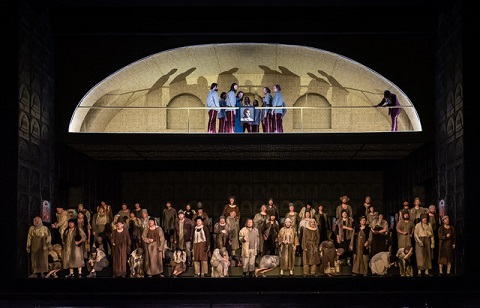 ROH’s Boris Godunov, Company. Photo credit: Clive Barda.
ROH’s Boris Godunov, Company. Photo credit: Clive Barda.
There is probably never any doubt as to Boris’s guilt, or complicity, in murder in this production. Jones certainly has the most gifted actor-singer of all in Bryn Terfel whose Boris has the most staggering stage presence. Terfel’s eyes - and what he does with them is simply unmatched. For any actor to command a stage with his eyes alone - as Terfel does - is quite remarkable and it begins here even before the Coronation Scene. The gaze, the stare, the madness, the sheer darkness was riveting. It’s worth the price of a ticket alone just to see Terfel look at you - it’s in turn terrifying, and completely compelling. Pimen’s ‘Chronicle of Russian History’, which we see as a series of large portraits, clearly paints a similar picture of Boris. The eyes glower, the face is unbearably ugly in its tortured expressions - a sharp contrast to the angelic, deified Feodor beside him. Even in the crowd scene outside the Kremlin Boris is simply scripted as a ruler who is indifferent, or at best incapable of empathy. Historically, these might not be entirely accurate depictions of Boris, but Jones turns him in to someone - as Pimen suggests - as a Tsar worse than Ivan.
Covent Garden have chosen to use Mussorgsky’s 1869 version (in the Michael Rot revised edition) which has both advantages and drawbacks. There is certainly greater fidelity to Pushkin’s text, and ending with Boris’s death - especially, when in this performance, it was so powerful and so tragic - seems more satisfactory. But it takes a better production than Richard Jones’s to stem the impression we are watching a series of tableaux rather than a single, immutable opera. It is obviously not Jones’s fault that Mussorgsky writes for such large choral forces - but it is a problem when those choruses struggle in such a compressed space. Mimi Jordan Sherin’s lighting - a vast sheet of white light which stretches entirely across the stage - flattens the height, whilst Miriam Beuther’s black set (even if it does have a raised upper platform) stifles everything lower down. There is something Romanov (later, rather than earlier) about Nicky Gillibrand’s costumes; and the tattered rags of the hungry and dispossessed owe much to David Lean’s vision of Dickens’s Oliver Twist.
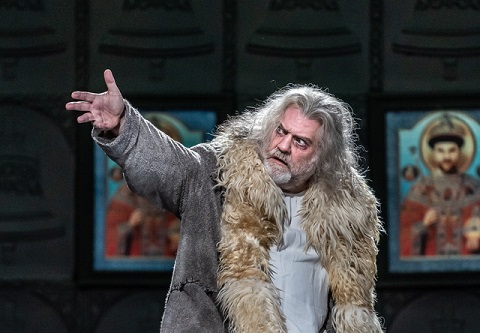 Bryn Terfel (Boris Godunov). Photo credit: Clive Barda.
Bryn Terfel (Boris Godunov). Photo credit: Clive Barda.
The 1869 version is also much more heavily cast for male soloists, perhaps less operatic than the 1872 version, more recitative in style and a little more kuchkist. I think there will always be those who question whether Terfel has the power - or depth of sound - to sing the role of Boris. One will always probably prefer the authenticity of a Russian bass in this part, but what Terfel does bring to Boris is such insight and tragedy to him. The acting is such an extension of what he does with his voice you wonder what comes first. He is that very rare thing, the complete singer-actor. It is certainly the case that he felt underpowered when he sang beside Matthew Rose’s superlative Pimen in the final scene; on the other hand, any one who heard Terfel’s simply stunning death scene will not forget it for a very long time. Where he probably has an advantage over a bass here is that the voice can do so much more at a higher register without straining and his ability to scale down the voice was heart-rending.
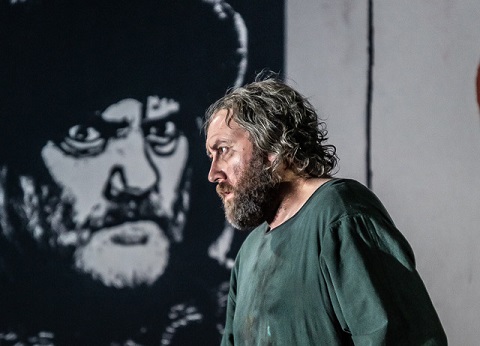 Matthew Rose (Pimen). Photo credit: Clive Barda.
Matthew Rose (Pimen). Photo credit: Clive Barda.
Terfel does madness very well. One is reminded in a Terfel performance of a conductor like Karajan in Berg - everything is geared towards total physical and mental exhaustion. Matthew Rose’s Pimen was no less commanding, though less intense in characterisation. The vocal lines are long and steady, his bass rich and deep - in a sense a deeply ‘monkish’ performance, perhaps the closest and most authentically Russian sung from this largely British cast. John Tomlinson, reprising the role of Varlaam, was hugely impressive, giving a most virile and spirited performance of the drunken monk. David Butt Philip’s Grigory was a little understated as the back-pack, knife-wielding usurper for my taste. The smaller roles - one of the notable features of Boris Godunov is that it is dominated by so few singers - were all finely sung, notably Roger Honeywell’s Prince Shuisky and, a particular standout, Sam Furness’s tin-headed Holy Fool.
The chorus of the Royal Opera House had a rather busy night, though one might argue Ben Wright, the movement director, had his work cut out by the lack of space they had to move in. The singing was first rate, as was the playing of the orchestra under the rather swift baton of Marc Albrecht. This was a performance which ran for a more than comfortable two hours.
There is, I think, a good reason why Boris Godunov remains difficult to stage well: it’s just written that way. Richard Jones doesn’t really succeed in doing so, though if we want a study in the madness of Tsar Boris, he has designed one for Bryn Terfel that succeeds on almost every level. Terfel carries this production by his sheer presence alone. I think the question is, would this production remotely work with any other singer in the role? I suspect the answer is a resounding no.
Marc Bridle
Modest Mussorgsky: Boris Godunov
Bryn Terfel (Boris Godunov), Roger Honeywell (Prince Shuisky), Matthew Rose (Pimen), David Butt Philip (Grigory), Boris Pinkhasovich (Schelkalov), John Tomlinson (Varlaam), Harry Nicholl (Missail), Haegee Lee (Xenia), Anne Marie Gibbons (Hostess of Inn), Sam Furness (Holy Fool), Jeremy White (Nikitch), Adrian Clarke (Mityukha), Alan Ewing (Frontier Guard), Christopher Lemming (Boyar); Richard Jones (Director), Marc Albrecht (Conductor), Miriam Buether (Set designer), Nicky Gillibrand (Costume designer), Mimi Jordan Sherin (Lighting designer), Ben Wright (Movement designer), Chorus and Orchestra of the Royal Opera House.
Royal Opera House, Covent Garden, London; Wednesday 19th June 2019.
image= http://www.operatoday.com/Bryn%20Terfel%20as%20Boris%20Godunov.jpg image_description= product=yes product_title=Boris Godunov: Royal Opera House, Covent Garden product_by=A review by Marc Bridle product_id=Above: Bryn Terfel as Boris GodunovPhoto credit: Clive Barda
June 19, 2019
An enchanting Hansel and Gretel at Regent's Park Theatre
And, its grungy recruits - chain-smoking, scowling witches-in-waiting - are already masters of the arts of evil enchantment, luring the innocent with striped bags of humbugs, Catherine-wheel lollipops and twinkling twigs towards the Head of the Coven’s oven. They prowl menacingly during the overture to this new production of Hansel and Gretel, as a bright-eyed bunch of children are sent off into the woods. Their lumberjack shirts may keep them warm, but Mother’s words of warning will be quickly forgotten: the sweet treats strewn along the woodland path are all too tempting.
Renewing their partnership with ENO (after last year’s The Turn of the Screw ), Regent’s Park Theatre now present Humperdinck’s take on the Grimm Brothers’ rite-of-passage tale of children abandoned, endangered and ultimately saved by their own ingenuity, and Sheader keeps homeliness and horror in good balance.
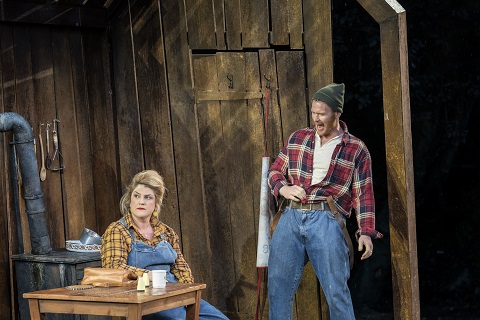 Rosie Aldridge (Mother) and Duncan Rock (Father). Photo credit: Johan Persson.
Rosie Aldridge (Mother) and Duncan Rock (Father). Photo credit: Johan Persson.
McKintosh’s set blends fidelity and fantasy with a sure touch. The stained sink, wonky table and bare shelves in the family cottage reek of real poverty, while the leaning walls have a fairy-tale tilt. During the children’s journey through the bristly thicket, the cottage is transformed before our eyes, deconstructed by the hovering hags until it’s just a skeleton that merges with the spindly trunks. Their path lit by fairy-lights blinking in the broom-branches, the children follow the lollipop stepping-stones that lead to the Witch’s house: a monstrous Battenberg cake, adorned with a swizzel-stick chimney and glace cherries glowing like warning lights. The sight of this sugary edifice sends the starving siblings into a frenzy of feasting, and they don’t notice the gingerbread men fence-cum-gravestones, with their eerily glowing eyes, which guard the mouth-watering mansion. Once inside, though, the outsize oven quickly pushes pretence aside.
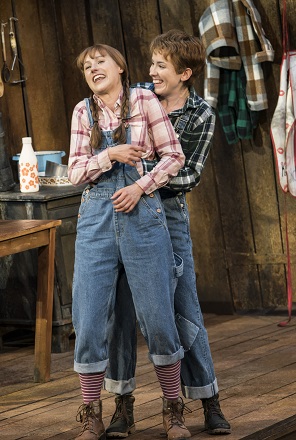 Susanna Hurrell (Gretel) and Rachel Kelly (Hansel). Photo credit: Johan Persson.
Susanna Hurrell (Gretel) and Rachel Kelly (Hansel). Photo credit: Johan Persson.
There are always going to be some compromises to be made in this venue but in this production they seem a virtue. Some discrete amplification is employed but it’s, for once, skilfully and consistently managed, and every word of the text is clearly heard. Derek J Clark’s orchestral reduction of Humperdinck’s opulent score is masterly: led by Janice Graham the twenty-strong ensemble, seated behind a screen at the rear, play with sparkle and punch, the seven string players forming a surprisingly sumptuous blend and the woodwind and brass players doubling instruments, enabling Clark to retain Humperdinck’s variegated palette. Ben Glassberg conducts a slick performance in which ‘stage’ and ‘pit’ are in consistent alignment: all the more remarkable given that, although there are numerous monitors to guide the cast, the choreography is busy and at time stakes them to the further reaches of the tiered auditorium.
Indeed, Lizzi Gee’s movement direction is superb. The children’s rough-and-tumble antics; the dream sequence, in which the children really do ‘take flight’ into fantasy; the delicate dancing of the en pointe duplicates of the dazzling Dew Fairy (He Wu), with their ‘milk-bottles’ of dew droplets; the reawakening of the lost children and the final chorus in celebration of this miracle: all are brilliantly conceived and executed. And, the choreography provides the production with a judicious moment of tongue-in-cheek kitsch. Reunited with his toy aeroplane by the sympathetic Sandman (Gillian Keith), the sleeping Hansel’s imagination powers a ‘lift-off’ to paradise. A bleached-blond flight crew arrive, smiles beaming and uniforms spic-and-span, and semaphore their pre-flight briefing before the excited children soar into the air on the surging wave of Humperdinck’s score, to be greeted by their parents bearing the balloons that will float them to wonderland. It’s terrifically well done.
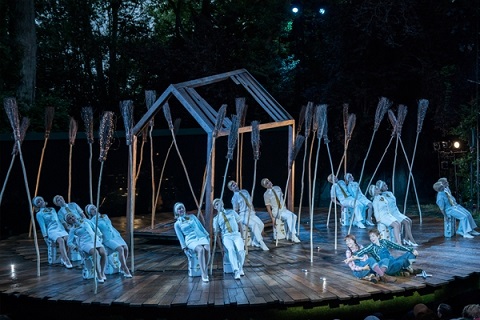 Hansel and Gretel Company. Photo credit: Johan Persson.
Hansel and Gretel Company. Photo credit: Johan Persson.
The main roles are double-cast, and on this occasion Rachel Kelly (Hansel) and Susanna Hurrell (Gretel) formed an absolutely credible pair of mischievous children, singing and acting with freshness and genuineness, and evincing tremendous rapport. There is a lovely moment of sibling warmth when, settling down to sleep, Hansel insists that his sister lie top-to-toe alongside him, only - when the chill of the night air punctures his façade of courage - to change his mind and welcome her to share his ‘pillow’. With a simple set, and much to distract an audience in the open-air arena (helicopters, blackbirds …), the pair worked with unwavering, tireless attention to detail in order to compel our attention. Kelly’s gamine Hansel was less prone to a temper tantrum than is sometimes the case with the boisterous lad, but his geniality was deepened by the mezzo’s dark shine, while Hurrell’s soprano brightened beautifully as it rose, adding feminine sparkle.
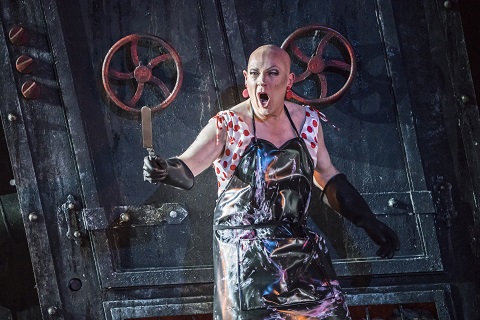 Alasdair Elliott (Witch). Photo credit: Johan Persson.
Alasdair Elliott (Witch). Photo credit: Johan Persson.
Rosie Aldridge sang commandingly as the put-upon Mother who hopes that the National Lottery will answer her prayers, while Duncan Rock gave a performance of vigour and heartiness as the lusty Father whose obvious love for his children is worn on his chequered sleeve. Alasdair Elliott was a particularly nasty Witch, wasting no time in whipping off ‘her’ wig, swapping scarlet stilettos for scruffy slippers, and flinging aside his drag-queen cleavage pads in disgust. Any delusions that the children had were brusquely despatched and in no time Hansel found himself caged under a table being force-fed via a funnel and tube while Gretel gasped in horror and fear. However, for all this Witch’s violence and vulgarity - ‘she’ used a can of aerosol cream as make-do foam, when shaving her legs - Elliott shaped the lines with refinement and his tenor had an air of dignity. The juxtaposition of nastiness and nobleness was striking.
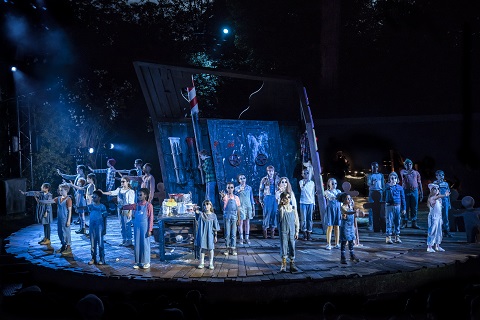 Hansel and Gretel Company. Photo credit: Johan Persson.
Hansel and Gretel Company. Photo credit: Johan Persson.
Children from the Pimlico Music Foundation formed a captivating chorus at the close. Taking off their John Lennon sunglasses, touched by human hands that restored them from darkness to light, they sang with warmth and joy - an utterly charming end to an enchanted evening.
Claire Seymour
Hansel - Rachel Kelly, Gretel - Susanna Hurrell, Mother - Rosie Aldridge, Father - Duncan Rock, Witch - Alasdair Elliott, Sandman - Gillian Keith, Dew Fairy - He Wu, Dance & Ensemble Captain - Billy Warren; Director - Timothy Sheader, Conductor - Ben Glassberg, Designer - Peter McKintosh, Movement Director - Lizzi Gee, Lighting Designer - Oliver Fenwick, Sound Designer - Nick Lidster for Autograph, Singers/Dancers from Arts Education Schools London and Bird College Conservatoire for Dance and Musical Theatre.
Regent’s Park Theatre, London; Monday 17th November 2019.
image=http://www.operatoday.com/Susanna%20Hurrell%2C%20Alasdair%20Elliott%20and%20Rachel%20Kelly%20Johan%20Persson.jpg image_description= product=yes product_title=Hansel and Gretel: Regent’s Park Theatre product_by=A review by Claire Seymour product_id=Above: Susanna Hurrell (Gretel), Alasdair Elliott (Witch) and Rachel Kelly (Hansel)Photo credit: Johan Persson
June 18, 2019
First staged production of Offenbach's Fantasio at Garsington
Opera Rara's recording of the work was released in in 2014 [see my review ], and there was an associated concert performance. At the time, I wondered quite how this transitional piece would work on the stage, and now Garsington Opera has given us the opportunity to find out.
Staged at Garsington by Martin Duncan (seen Sunday 16 June 2019), Offenbach's Fantasio featured Hanna Hipp as Fantasio, Jennifer France as Princess Elsbeth, Timothy Robinson as Marinoni, Huw Montague Rendall as the Prince of Mantua, Graeme Broadbent as the King of Bavaria and Bianca Andrew was Flamel. Justin Doyle conducted the Garsington Opera Orchestra and Garsington Opera Chorus. The work was performed in a new English translation by Jeremy Sams .
Fantasio was written for the Opera Comique in Paris in 1870, but the premiere was delayed owing to the Franco-Prussian war. It debuted in 1872 with Celestine Galli-Marie (the first Carmen) in the title role. Based on a relatively unsuccessful play by Alfred de Musset, Fantasio was a somewhat daring choice and the piece failed, much to Offenbach's distress. There may be an element of identification, many commentators see Offenbach himself in the role of the melancholy clown Fantasio.
A poor student, Fantasio (Hanna Hipp) takes advantage of the death of the King's jester to take up that role and in this position gets close to the Princess Elsbeth (Jennifer France), whom he has serenaded unseen. Elsbeth is due to be married to the Prince of Mantua (Huw Montague-Rendall) but wants to marry for love. The prince is keen to be loved for himself and swaps clothes with his aide-de-camp, Marinoni (Timothy Robinson). Fantasio gets close to the Princess, and disrupts the wedding plans by revealing the Prince's disguise. Thrown into prison, he reveals his true self to the Princess who helps him escape, and he persuades the Prince to sign a peace treaty. The marriage however, is off, and the work ends with the Princess letting Fantasio keep the key to her 'secret garden'.
And whilst there is a vein of lyric melancholy, there are mad-cap elements too, both the Prince and Marinoni are closer to stock characters as are the students, Facio (Joel Williams), Harmann (Joseph Padfield) and Sparck (Benjamin Lewis) who pop up as a commentary complementary to the townsfolk (the chorus). But the core of the work is the pair of scenes for Fantasio and the Princess, one in her garden (in Act Two) and one in prison (Act Three), and you wish that this relationship had been developed more. Act One is rather slow, taking its time to establish characters and the piece spends rather too long with the Prince, Marinoni and their 'cunning plan' (Jeremy Sams' singing translation seemed to enjoy the hints of Blackadder).
The overall tone is slightly uncertain, is this a comic operetta or is it a romantic opera and this mixed tone made me think of Gilbert and Sullivan's The Yeomen of the Guard (1888) where they produced an operetta with a far more serious vein than their earlier work. Martin Duncan and his designer Francis O'Connor had the added complication of having to stage Act One (which is set at dusk and in the twilight) in a theatre flooded with light. Their solution was to create a surreal world with a set inspired by De Chirico and costumes which evoked the 18th century ommedia dell'arte but were securely modern. The result highlighted the more comic elements of the plot, but I rather missed a vein of lyric romance in the staging.
Luckily this was supplied by Hanna Hipp and Jennifer France. Hipp made an engaging and intriguing Fantasio, a melancholy dreamer with a strong personality. Hipp's song to the moon in Act One (sung in broad daylight) was entrancing and set the scene, whilst France wonderfully combined the Princess' pin-sharp coloratura with a vein of melancholy at her impending marriage. Hipp and France really made a connection in their wonderfully romantic scene in Act Two, disguise and darkness meaning that each reveals something of their private self to the other. The prison scene was similarly touching, and the unresolved resolution at the end of the opera made you long to know what happened to these characters.
Huw Montague Rendall managed to be delightfully engaging as the Prince of Mantua, rather more 'Tim nice but dim' than Blackadder and revealed a supple lyric baritone which deserves a more serious vehicle. Timothy Robinson was alarmingly foppish as Marinoni, entering with a will into the charades yet, when he stops pretending to be 'The Prince' reveals his own vein of melancholy too.
Graeme Broadbent did his best with the King of Bavaria, who is very much a cipher, whilst Bianca Andrew flexibly slipped in and out of the action as the Princess' page. The three students, Joel Williams, Joseph Padfield and Benjamin Lewis made the best of their scenes but you felt that Offenbach's heart wasn't quite in it and he had done this sort of thing better earlier in his career.
The chorus entered into the piece with a will, and with no separate dance troupe, they entertained us royally with Ewan Jones' elaborately choreographed choruses, bringing the work to life.
The work was sung of Jeremy Sams' English version and the cast's diction was excellent, so we barely needed the surtitles. Whilst I can understand the reasoning behind doing it in English, I did miss the sound of the sung French language and feel that this would have brought an added layer to the piece. Sams did not entirely avoid that major pitfall of translating Offenbach into English, the proximity of G&S, and there were numbers which would almost have fitted into a Savoy Opera. That some of Offenbach's melodies could be described as Sullivanesque indicates quite how much influence Offenbach had on his younger English contemporary.
In the pit, Justin Doyle and the orchestra successfully created a sense of Offenbach's journey from Orpheus to Hoffmann.
This was a performance which both intrigued and engaged, making us realise the complexity of Offenbach's later works. The fine performances from the central two characters ensured that the lyric melancholy of the piece was finely served, surrounded by the more classic Offenbach operetta of the lesser characters.
Robert Hugill
Offenbach: Fantasio
Fantasio - Hanna Hipp, Princess Elsbeth - Jennifer France, Prince of Mantua - Huw Montague Rendall, Marinoni - Timothy Robinson, King of Bavaria - Graeme Broadbent, Flamel - Bianca Andrea, Sparck - Benjamin Lewis, Hartmann - Joseph Padfield, Facio - Joel Williams; Director - Martin Duncan, Conductor - Justin Doyle, Designer - Francis O’Connor, Lighting Designer - Howard Hudson, Movement Director - Ewan Jones, Garsington Opera Orchestra & Chorus.
Garsington Opera, Wormsley; Sunday 16th June 2019.
image=http://www.operatoday.com/Fantasio%20title%20image.jpg image_description= product=yes product_title= Fantasio: Garsington Opera, Martin Duncan (director), Justin Doyle (conductor) product_by=A review by Robert Hugill product_id=Above:Fantasio at Garsington OperaPhoto credit: Clive Barda
June 16, 2019
Rusalka in San Francisco
But it does have several hours of quite beautiful music to be sung and danced, and that has happened just now in San Francisco. Soprano Rachel Willis-Sorensen made her role debut as the “rusalka” or water sprite who has fallen in love with a hunter who is, incidentally, a prince. The role is a tour de force.
Seated in a moonlit tree Mme. Willis-Sorensen (35 years old) captured all of the naive magic of Dvorak’s famous Song to the Moon. Her considerable vocal resources are now fully realized (she was an ingenue Eva in SFO’s 2015 Meistersinger) and in this Rusalka fully utilized — even though she is voiceless for the entire second act when she must confront her competitor, the Foreign Princess. Rejected she returns to the forest to confront her destiny — that she kill the hunter she loves or forever lure men to their death with her kiss.
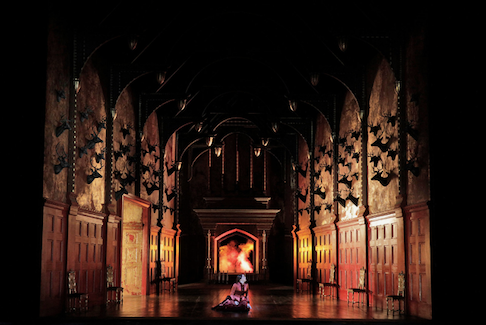 Act II Hunting Lodge
Act II Hunting Lodge
This occasioned quite a lot of singing. Mme Willis-Sorensen acquitted herself magnificently, the beauty of her silvery colored voice raging and caressing with unfaltering strength the conflicting emotions of her lost innocence. The hunter prince returns to her only to be pulled into the depths of the earth by her kiss. But not before joining Rusalka in one of opera’s most thrilling duets, it’s emotive extensions dissolving into an ultimate resignation to loss.
Tenor Brandon Jovanovich, a veteran hunter prince (he has recorded the opera with Anna Maria Martínez)) again brought beautiful, secure singing and ardent acting to this role. Mr. Jovanovich naturally brings the genuine innocence required by most tenor roles, plus he retains the requisite physicality. He is a unique artist.
The David McVicar production from Lyric Opera of Chicago gently embraces a lament of the effects of human intrusion into the natural world. The concept engenders a mysteriously lovely, animated forest marred by a concrete sewage dam, and a gigantic, trophy laden hunter’s lodge with carcass laden kitchen. Huge subtle atmospheres were thereby created that provided requisite presence for the unexpected monumentality of Dvorak’s score.
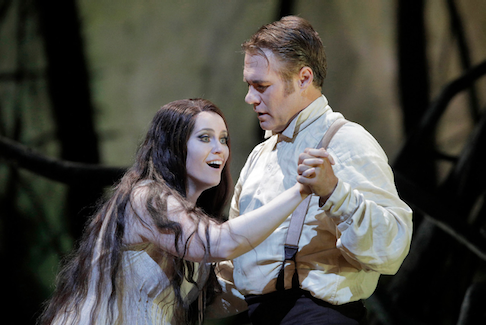 Rachel Willis-Sorensen as Rusalka, Brandon Javonovich as the Prince
Rachel Willis-Sorensen as Rusalka, Brandon Javonovich as the Prince
Houston opera principal guest conductor Eun Sun Kim drove the emotional flow, pulling the vibrant Dvorak colors from the triple winds of the opera orchestra, urging full-throated force from its strings. Unlike the subtlety of the McVicar production Ma. Kim strove for immediate effect. It was thrilling when it was not overpowering. This talented conductress did find balance in the final moments of the duet. Its hopelessness seemed genuinely felt.
The three Wood Nymphs were appropriately embodied by three delightful Adler Fellows who frolicked together with the Opera’s corps de ballet in motions of rustic grotesquerie. British operatic choreographer Andrew George as well created the extensive balletic dance caricatures in the second act hunting lodge. The witch Jezibaba who transforms Rusalka into human form was sung by mezzo Jamie Barton with exaggerated grotesque sophistication.
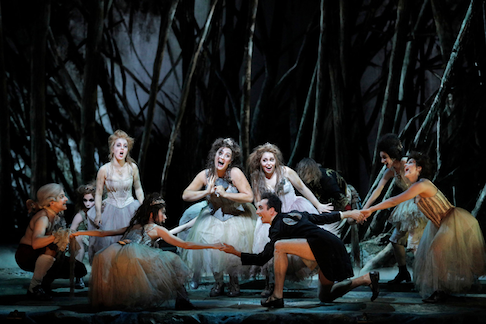 The Wood Nymphs and the corps de ballet
The Wood Nymphs and the corps de ballet
The high level casting was completed with Icelandic bass Kristen Sigmundsson singing Rusalka’s father Vodnik and bass baritone Philip Horst as first the lusty then the frightened Gamekeeper. Both artists were appropriately cast in these character roles that were very well sung. The Kitchen Boy who becomes Rusalka’s first victim was beautifully portrayed by former Adler Fellow Laura Krumm.
Soprano Sarah Cambridge, a recent Adler Fellow, was a perfunctory, steely toned Foreign Princess. An additional hunter was rendered by former Adler Fellow baritone Andrew Manea.
Michael Milenski
Cast and production information:
Rusalka: Rachel Willis‐Sørensen; The Prince: Brandon Jovanovich; Vodník: Kristinn Sigmundsson; Ježibaba: Jamie Barton; Foreign Princess: Sarah Cambidge; First Wood Nymph: Natalie Image; Second Wood Nymph: Simone McIntosh; Third Wood Nymph: Ashley Dixon; Forester: Philip Horst; Kitchen Boy: Laura Krumm; Hunter: Andrew Manea.
The San Francisco Opera Chorus and Orchestra. Conductor: Eun Sun Kim; Production: David McVicar; Revival Stage Director: Leah Hausman; Set Designer: John Macfarlane;
Costume Designer: Moritz Junge; Lighting Designer: David Finn; Choreographer: Andrew George. War Memorial Opera House, San Francisco, June 16, 2019.
image=http://www.operatoday.com/Rusalka_SF1.png
product=yes
product_title=Rusalka at San Francisco Opera
product_by=A review by Michael Milenski
product_id=Above: Rachel Willis-Sorensen as Rusalka [All photos copyright Cory Weaver, courtesy of San Francisco Opera]
Orlando in San Francisco
Forget the brutal conflict between love and duty suffered by Lodovico Ariosto’s great chivalric hero Orlando. General director Matthew Shilvock made a curtain announcement that mezzo soprano Sasha Cooke, the Orlando, was indisposed, but would sing the famed Italian castrato Senescino’s role anyway. Thus the performance was compromised, Mme. Cooke’s Orlando pallid indeed.
Further compromise — Orlando’s arch rival in love was sung by Adler Fellow counter tenor Aryeh Nussbaum Cohen. He replaced David Daniels, the “me-too” disgraced counter tenor who brought virile flash to Xerxes’ Arsamenes a few years back and surely would have cut-the-figure to woo Ariosto’s femme fatale Angelica away from Orlando. Mr. Cohen has a lovely, smooth mezzo voice of feminine grace. Costumed as a middle aged business man Mr. Cohen did not make the cut vocally or figuratively.
The production came from Scottish Opera. Its conceit is that Edward VIII who abdicated the British throne (and the implied responsibility to battle Nazi Germany) for his love of American socialite Wallis Simpson serves as an admonition to Orlando (Italian for the famed knight Roland) that he forget love for a while and get on with saving Europe from the invading Saracens.
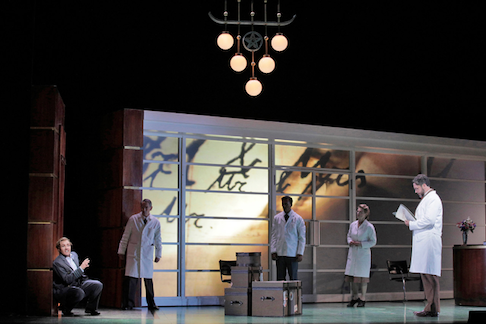 Orlando (far left), Zoroastro as psychiatrist (far right), supernumerary nurses
Orlando (far left), Zoroastro as psychiatrist (far right), supernumerary nurses
And so the action was in some sort of WWII hospital, Orlando a shot down pilot or something, with clothing of that period. It is a post-modern fashion look well known here in hip San Francisco where the Edward VIII abdication is a minor, if salacious though quaint footnote to ever more distant history. This 2011 production perhaps found greater resonance in the United Kingdom.
Essentially Orlando who has saved Isabella loves Angelica who has saved Medoro and is in love with him but has to deal with Orlando who goes crazy. Dorinda is crazy in love with Medoro who has to deal with her. The magician Zoroastro oversees it all. The language is purely pastoral.
Handel deals with all of this love and madness in the flow of his magnificent arias, plus a sublime trio at the conclusion of act I. Handel scored his 1733 opera for a very large orchestra, thus the resonant strings of the San Francisco Opera Orchestra were quite appropriate. Add two recorders, two blasting horns, two plaintive oboes, a splendid vibrato-less cello duet and two fine sopranos and Handel’s opera took flight. In fact under English early music conductor Christopher Moulds Handel’s music soared.
Only to be grounded in a small, low one wall set that turned around from time to time to accommodate British provincial stage director Harry Fehr’s stolid concept where everything is squarely explained as in a play. Handel and Ariosto’s imaginative, magically musical and pastoral impulses were forsaken to a purely earthbound narrative. It was hard to stay interested, thus there was significant audience defection after the second act.
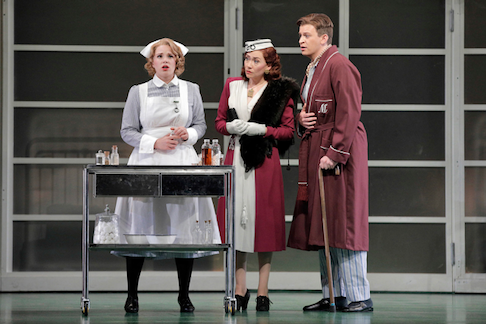 Dorinda, Angelica, Medoro
Dorinda, Angelica, Medoro
The greatest vocal pleasure emanated from young Austrian soprano Christina Gansch who found the poetic naïveté of the nymph (nurse) Dorinda in very communicative singing. Once again soprano Heidi Stober as Angelica proved she can do anything (everything from Magnolia Hawks in Showboat to Marguerite in Faust). Within the limitations of the concept she even found some of Ariosto’s magic and a great deal of Handel’s genius. San Francisco Opera’s catch-all bass Christian Van Horn did a workmanlike job of delivering Zoroastro.
Stage director Fehr inserted recorded bombardment explosions to confuse and disturb Orlando’s musical madness, and a sterile box to stifle Orlando’s florid delusions. So much for Orlando furioso.
Handel however happily survived it all.
Michael Milenski
Cast and production information:
Orlando: Sasha Cooke; Angelica: Heidi Stober; Dorinda: Christina Gansch; Medoro: Aryeh Nussbaum Cohen. San Francisco Opéra Orchestra. Conductor: Christopher Moulds; Director: Harry Fehr; Production Designer: Yannis Thavoris; Revival Lighting Designer: Tim van’t Hof; Projection Designer: Andrzej Goulding. War Memorial Opera House, San Francisco, June 15, 2019.
image=http://www.operatoday.com/Orlando_SF1.png
product=yes
product_title=Orlando at San Francisco Opera
product_by=A review by Michael Milenski
product_id=Above: Sasha Cooke as Orlando [All photos copyright Cory Weaver, courtesy of San Francisco Opera]
June 13, 2019
London Bel Canto Festival 2019: an interview with Ken Querns-Langley
A specialist bel canto tenor, teacher, managing director of the London Bel Canto Festival Academy and the Festival’s Artistic Director , Ken evidently has an enormous passion for the bel canto repertoire, style and traditions - and a commitment to upholding and developing such traditions, particularly among young singers either studying at or recently graduated from music conservatoires in London and beyond.
He ‘defines’ bel canto in an embracing and inclusive manner. A glance at Grove reminds me that while the term is sometimes applied exclusively to Italian opera of the time of Rossini, Bellini and Donizetti, it remains ambiguous: ‘German musicology in the early 20th century devised its own historical application for “bel canto”, using the term to refer to the simple lyricism that came to the fore in Venetian opera and the Roman cantata during the 1630s and 40s (the era of Cesti, Carissimi and Luigi Rossi) as a reaction against the earlier, text-dominated stilo rappresentativo’. Bel canto is often used nostalgically to denote a lost tradition, particularly in the context of the ‘battle’ between the speech-inflected, ‘weighty’ style associated with late-19th century German opera, and Wagner in particular, and the earlier Italian art of ‘beautiful singing’. Rossini, in 1858, is reported to have lamented the decline of this art, in 1858 - ‘Alas for us, we have lost our bel canto’ - and it’s been a battle-cry in the vocabulary of Italian singing teachers such as Luigi Ricci (1893-1981).
While, as Ken clarifies, we associate the bel canto style with long melodic lines sung in an even tone, with expressive nuance, a lightening of the voice in the higher registers, and flexible ornamentation, such features should not be seen as relevant to only a ‘narrow’ repertoire of early-19th century Italian compositions, although this period might be seen as a ‘high’ bel canto epoch. He sees the development of vocal style during the years up until the 1850s as being more seamless and organic - interestingly, Grove notes that the term did not acquire a specialised meaning until the mid-19 th century - and bel canto technique as being as applicable to the works of Mozart as to Bellini et al. Indeed, while Wagner might have decried Italian singing for its preoccupation with ‘whether that G or A♭ will come out roundly’, proposing instead a German school which would draw ‘the spiritually energetic and profoundly passionate into the orbit of its matchless Expression’, in his early writings he had urged German composers to look towards Italian models, writing in an 1837 article entitled, simply, ‘Bellini’, that the vocal melodies of this ‘gentle Sicilian’, had ‘of late excited so much attention, and kindled so much enthusiasm, even in Germany, the land of the learned … Melody is in short the language in which a man should impart his musical thoughts to others.’
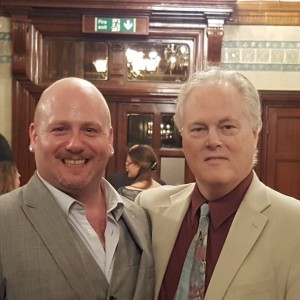 Ken Querns-Langley and Bruce Ford at the 2017 London Bel Canto Festival.
Ken Querns-Langley and Bruce Ford at the 2017 London Bel Canto Festival.
That said, Ken describes to me research by one of his fellow scholars at the Royal College of Music, Barbara Gentili, which focuses on the impact of verismo on the late-19th century Italian vocal tradition. Gentili identifies a ‘shift’ in the later years of that century which Ken summarises, drawing parallels with visual art, as the difference between ‘representation’ and ‘realism’: bel canto singing is the embodiment of an emotion, verismo singing is that emotion. Naturally, further ‘shifts’ have occurred during the 20 th and 21st centuries, and it’s necessary and advantageous to go back to the past and to understand and reconnect with former styles and techniques.
So, perhaps for Ken bel canto is essentially an aesthetic which comprises repertoire, voice production, technique, style and vocal identity? Ken agrees, commenting on the training that young singers receive in today’s academies and colleges, where the emphasis has shifted from a focus on purely technical studies to the need to develop knowledge of repertoire and to perform regularly on the stage, with the result that young singers often have a notion of how their voice ‘should’ sound without really understanding or appreciating how it ‘does’ or ‘could’ sound. He recounts an experience teaching a talented young singer who had previously developed a vocal cord cyst, and who believed that she would need a procedure which Ken recognises as a normally recommended course of action. After a several lessons developing features of bel canto technique the singer had added a fourth to the top of her range, from C’’ to F’’, and found that she was able to sing with a light and even pianissimo. Doctors subsequently examining her vocal cords found that the cyst had diminished and that surgical treatment was no longer considered necessary and refused to perform: indeed, it would probably do more damage than good. The singer had discovered that the sound that she had believed she ‘should’ make, was not in fact her true vocal ‘identity’; and, Ken explains that a young singer’s misunderstanding of their own vocal identity can lead to both psychological and physiological pressure and distress.
He describes to me his own vocal studies with lyrico spinto dramatico soprano, Georgyn Geetlein, from the Metropolitan Opera, who extended his upper range and taught him how to bridge his passagio; and, subsequently, during a two-year sojourn in Italy, with Sherman Lowe, a much sought-out vocal teacher based in Venice, now living in Trieste. Such studies supplemented an instinctive love for bel canto repertoire with a sense of a responsibility to uphold and develop its traditions.
But, why establish a bel canto vocal school and festival in London? Ken’s residency in London originated in a serendipitous visit to the capital in the late 1980s, en route for Paris where he intended to study: arriving at Paddington station and venturing out in search of a taxi, he suddenly felt, for the first time, a sense of being ‘at home’. Though further studies, travel and work in Italy, Spain and elsewhere followed, the hankering to return to London did not lessen. Postgraduate studies at King’s College London enabled him to move to the capital, and he continued his voice lessons, training with teachers and coaches from Covent Garden, the National Opera Studio and English National Opera. Now, London really is ‘home’, though he also teaches in Copenhagen, and internationally via Skype.
The third Bel Canto Festival will enable almost twenty young singers to spend two or three weeks following opera performance and vocal development programmes comprising daily private lessons and coaching, performance-focused language repertoire coaching, performance workshops, and masterclasses with Bruce Ford , Nelly Miricioiu , Ken himself and others. There are public masterclasses and concert performances , but singers are encouraged to focus on the development of their technique and vocal identity, and to avoid becoming too concerned with the actual performance of particular arias being studied for that purpose.
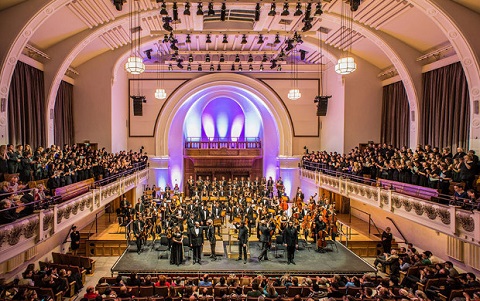 2018 London Bel Canto Festival Gala Concert at Cadogan Hall © Harbor Hill.
2018 London Bel Canto Festival Gala Concert at Cadogan Hall © Harbor Hill.
In addition, the 2018 Festival saw the establishment of a ‘composer-in-residence’ for the first time, in order to develop new works which enable singers ‘to express the fullest of bel canto vocal principles in modern settings’ and which, as Ken explains have been developed with a view to enabling singers to explore their own vocal ‘sound’ and expression rather than their voice simply serving as a vehicle for a composer’s personal expression. The Festival will conclude with two performances of Bellini’s little-known opera, Beatrice di Tenda , in St George’s Church, Hanover Square, staged in concert with a chamber orchestra, on 22nd and 24th August. It’s hoped, too, that collaborations with other institutions such as Opera Rara will be developed in future years.
Ken is equally interested in bel canto practice and scholarship, and is currently completing doctoral research on the voce faringea - the high tenor voice and roles which are normally beyond the vocal compass of modern tenors, one of the best-known examples of which is Arturo’s arioso ‘Credeasi misera’ from Bellini’s I Puritani which reaches up to F5 - at the Royal College of Music London . His study of countless historical treatises and documents relating to performance reception, alongside quantitative analysis of particular arias with respect to the frequency of particular pitches, dynamics and other features in arias which we know were composed for specific singers, has resulted in findings which, while inevitably cannot propose ‘absolutes’ about the nature of the high tenor sound, have uncovered mis-translations and mis-interpretations in extant scholarship - in particular with respect to the similarity or otherwise between the high tenor sound and those associated with falsetto, the countertenor and the female voice - that have made it possible for Ken to consider how we might ‘re-construct’ this sound, and to create a teaching manual in order to do so.
During our meeting the conversation ranges far and wide, from psycho-acoustics to the ‘science’ of vowel production at different pitches; from pedagogy to performance psychology, to the history of the King’s Theatre Haymarket. Ken concludes by reminding me that Britain, and specifically London, is in many ways at the heart of the bel canto tradition. Many esteemed singers and teachers of yesteryear passed through or spent considerable time in the capital: for almost 50 years, for example, Manuel Garcia - the brother (and singing teacher) of Maria Malibran - taught at the Royal Academy of Music in Marylebone, and of his greatest students Mathilde Marchesi also lived and taught here in London.
It’s probably one step too far to suggest that ‘bel canto is coming home’! But, it will certainly be thriving and developing in London this summer.
The London Bel Canto Festival runs from 5th to 24th August.
Claire Seymour
Anthony Negus conducts Das Rheingold at Longborough
This is Longborough Festival Opera’s Das Rheingold and the first instalment of the complete Ring-cycle up until 2022. It's also Polly Graham’s second season as Artistic Director of the festival established by her parents in 1991 - a founding year that was to bring an operatic dream of a British Bayreuth to reality. A first Cotswold Rheingold in 1998 heralded a Wagnerian Eden. It’s not been a smooth ride - early on a critic considered ‘Mr Graham will give more pleasure by being less ambitious’ - but history has proved otherwise and the intimate space of Longborough’s 500-seat theatre (salvaged from Covent Garden) is no barrier to artistic enterprise or a composer’s gargantuan vision. If anything, Longborough’s limited dimensions admirably suits Rheingold’s text-laden outlines where its creative energies (unfettered by the absence of technical wizardry) can be distilled through depth of characterisation and powerful musicianship.
These qualities were abundantly present in this performance under director Amy Lane, and central to its success was the Wagner specialist Anthony Negus whose immersion in the composer’s operas and nearly two decades of conducting them at Longborough have provided one of Britain’s most authoritative and respected exponents. There was a real grasp of musical architecture when I caught up with Rheingold on its third night and the music’s ebb and flow took hold from the start. Longborough Festival Orchestra built through the opening Prelude with accumulating grandeur and arrived at the work’s final climatic bars unscathed and uninterrupted 150 minutes later. There was barely a fluffed horn and the whole was scrupulously well-balanced and vividly coloured.
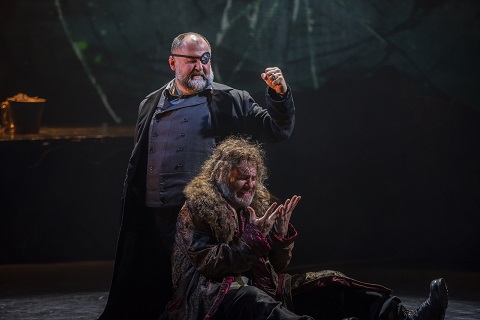 Darren Jeffrey (Wotan), Mark Stone (Alberich). Photo credit: Matthew Williams-Ellis.
Darren Jeffrey (Wotan), Mark Stone (Alberich). Photo credit: Matthew Williams-Ellis.
With designs from Rhiannon Newman Brown, the set was periodically colourful too, and behind the stage’s rising mountain paths with low central summit were Tim Baxter’s effective video projections, both naturalistic (a swollen river Rhine) and abstract (swirling patterns). Set and screen together evoked the murky depths of Nibelheim and the Rhine, while emerging from towering clouds was a rather impressionistic Valhalla, suggestive more of a limp sandcastle than an intimidating fortress. By contrast, the smelting furnace down in the bowels of the earth was intensely conjured and brought to mind The Great Day of his Wrath by the English Romantic painter John Martin - an apocalyptic vision of destruction from the early 1850s - coinciding roughly with the period of Emma Ryott’s sombre costumes and the composition of Das Rheingold.
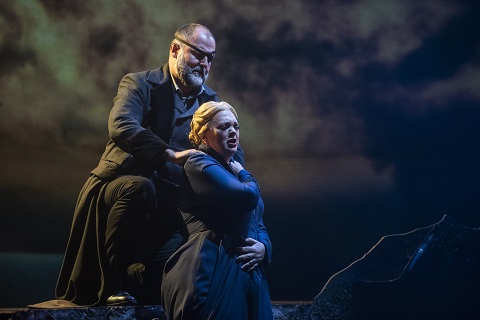 Darren Jeffrey (Wotan), Madeleine Shaw (Fricka). Photo credit: Matthew Williams-Ellis.
Darren Jeffrey (Wotan), Madeleine Shaw (Fricka). Photo credit: Matthew Williams-Ellis.
Designs and costumes aside, what really lifted this Rheingold into something almost revelatory was the standard of acting and singing - albeit not uniformly excellent, but with enough definition to repeatedly draw the ear and eye towards several outstanding performances. Chief amongst these was Mark Le Brocq’s dodgy dealer Loge, whose crimson frockcoat and twirling cane brought a whiff of a Victorian music hall MC. His ease of movement and vocal projection were outstanding, his perfectly caught ambivalence tailor-made for this role. His pirouetting laid bare Darren Jeffrey’s stolid and authoritatively sung Wotan whose lumbering gait worked against his impressive build, otherwise ideal as a ruler of the gods. More convincing was the nimble and dishevelled Mark Stone as Alberich, utterly persuasive in voice and single-minded ambition. His brother, Mime, was sung by a clarion-voiced Adrian Dwyer who brought considerable energy to his ensemble scenes.
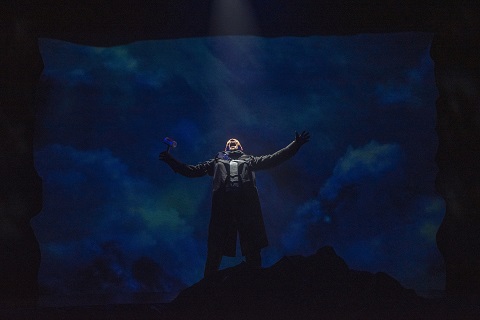 Photo credit: Matthew Williams-Ellis.
Photo credit: Matthew Williams-Ellis.
Arriving comically on decorators’ stairs the two giants Simon Wilding and Pauls Putnins were sharply delineated as Fafner and Fasholt, and Wyn Pencarreg and Elliot Goldie made a well- cast partnership as Donner and Froh. Amongst the women Marie Arnet was a full-toned but anxious-looking Freia, while Madeleine Shaw was an imperturbable and loving Fricka, grandly elegant in looks and tone. So too were the three winsome Rhinemaidens - Marie Wyn Williams, Rebecca Afonwy-Jones and Katie Stevenson - whose singing stood out from their schoolgirl cavorting. But it was the gold-plated voice of Mae Heydorn as the imploring Erda that left one of the strongest impressions of the evening.
If this performance is anything to go by, the next three years will bring queues to Longborough and when the entire cycle is mounted in 2023 this rural idyll will be a Wagnerian heaven.
David Truslove
Wagner: Das Rheingold
Wotan - Darren Jeffery, Fricka - Madeleine Shaw, Loge - Mark Le Brocq, Donner - Wyn Pencarreg, Froh - Elliot Goldie, Freia - Marie Arnet, Erda - Mae Heydorn, Fasolt - Pauls Putnins, Fafner - Simon Wilding, Alberich - Mark Stone, Mime - Adrian Dwyer, Woglinde - Mari Wynn Williams, Wellgunde - Rebecca Afonwy-Jones, Flosshilde - Katie Stevenson, Director - Amy Lane, Conductor - Anthony Negus, Designer - Rhiannon Newman Brown, Costumes - Emma Ryott, Lighting - Charlie Morgan Jones, Video - Tim Baxter, Longborough Festival Orchestra.
Longborough Festival, Gloucestershire; Sunday 9thJune.
image=http://www.operatoday.com/Mark%20Le%20Brocq%20%28Loge%29%20Matthew%20Williams-Ellis.jpg image_description= product=yes product_title=Das Rheingold: Longborough Festival Opera product_by=A review by David Truslove product_id=Above: Mark Le Brocq (Loge)Photo credit: Matthew Williams-Ellis
June 12, 2019
Carmen in San Francisco
Unabashedly not a contestant in the Carmen wars (who can fit Merimee’s bloody tale most uncomfortably into a relevant contemporary context) Mme. Zambello sets her Carmen in a music hall somewhere. We see it as a sort of music hall revue of the numbers we know and love complete with lively production dance numbers. Like music theater there is spoken dialogue (a bit more than usual), the simple story is clearly told with no troubling nuances and there is not a drop of blood. On second thought this is about as far-out as a Carmen production could get.
But wait. There were more troubling aspects to the performance — Bizet’s Carmen was in fact further deconstructed. It happened in the pit. Former San Francisco Symphony associate conductor James Gaffigan, now a rising star on the world’s major stages, offered a bright, lilting overture, the always admirable San Francisco Opera Orchestra in resplendent tone. The rose red show curtain rose, Jose alone, desolate in a pool of light (he had already murdered Carmen, the story to be told in flashback) while Carmen’s famed fate motive flowed forth oh-so-sweetly at a mere orchestral forte (Mo. Gaffigan eschewed all sense of fortissimo throughout the ordeal).
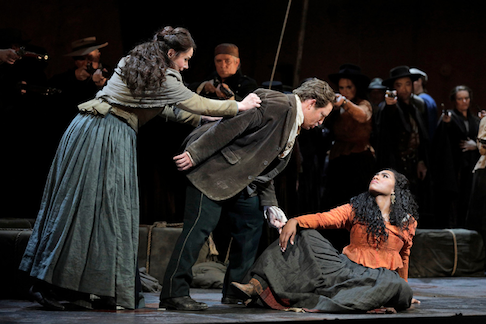 Anita Hartig as Micaëla, Matthew Polenzani as Jose, J'Nai Bridges as Carmen
Anita Hartig as Micaëla, Matthew Polenzani as Jose, J'Nai Bridges as Carmen
Further Carmen shock and awe (and there was a lot of it) happened in Jose’s Flower Song, Carmen (the very beautiful J’Nai Bridges) reclined down stage right in a pool of light — a perfect rose — while Jose (Matthew Polenzani in fine voice) tenderly related to the rose he held, the maestro enveloping Bizet's brief postlude in the sweetest and loveliest possible colors, our two lovers in perfect, innocent and quite uncomplicated harmony. It was not ironic. This was a perfect love that simply got derailed.
One can only fear for the blood and guts of Verdi’s Ernani that this talented maestro will conduct in San Francisco Opera’s 2020 spring season.
Carmen dead on the stage, there was a final burst of glitz as Micaela, overlooking the tragedy from atop an orangey brown abstract structure meant to represent the exterior of the bull ring, threw blood red (finally some blood!) streamers along with clouds of confetti onto the estranged lovers.
With the stage director and the conductor in collusion the cast, clearly capable of far greater emotional range, diligently and effectively brought this strange Carmen to life. Mezzo-soprano J’Nai Bridges is young, sexy, vibrant, and dangerous, attributes that were as apparent in her voice as in her figure. She is a Carmen of exceptional musical finish. Her Habañera and Seguidilla were spellbinding, the maestro clearly under the artist’s thrall, the orchestral accompaniment a mere hint of the beat, like the finest Rossini conducting.
Tenor Matthew Polenzani portrayed a simple, smitten-with-pure-love soldier. His light lyric voice easily avoided the treacheries of the role for heavier voices, voices that have easier potential to personify the more usual sexually charged love Jose has for Carmen. As it was it seemed that this Jose’s love for Carmen was as pure as his love for his dying mother. On the other hand tenor Polenzani was a resolutely virile, recent San Francisco Opera Hoffmann.
Romanian soprano Anita Hartig as Micaëla fulfilled SFO’s claim to being an international house. This gifted artist of great presence brought a pure, silvery vocal sound to Micaëla in exceedingly careful phrasing, attributes that created a character of utter innocence. This Micaëla was never a foil to Carmen so much as she was the angel that oversaw the naive soul of a simple Spanish soldier. Hers was a performance indeed befitting a major stage.
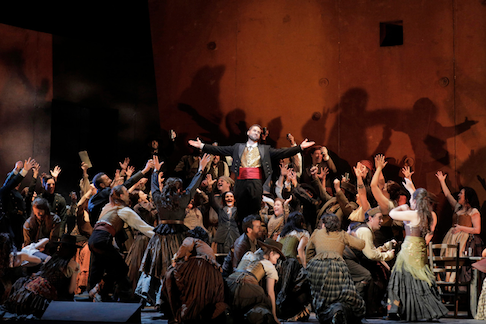 Kyle Ketelsen as Escamillo
Kyle Ketelsen as Escamillo
Though not a flashy Spaniard, bass-baritone Kyle Ketelsen does cut a fine figure as the toreador Escamillo. He reads as physically strong and boasts an agility that easily could avoid a charging bull. The same could be said of his powerful voice and supple singing that he uses to actually create a character of depth, rare for this role usually played as a pure sex symbol. His third act fight with Jose was unsettling when all this magnificent virile physicality fell to Jose’s clumsy thrust.
The principal singers and the conducting were the elegance of the production. The actual staging and the lesser roles were clumsily rendered. Adler Fellows or equivalents were called upon to approximate as best they could the complex characters that complete Bizet’s drama, characters than can add intense emotional atmospheres to Carmen, but here did not. Unfortunately Natalie Image’s Frasquita was sometimes under pitch in the climaxes of the opera’s huge ensembles.
Mme. Zambello’s Carmen is music theater where action is controlled choreography and not spontaneous realism. There was incessant, staged movement, moreover in the complex fights movement was less than precise and usually ill timed, at odds with the rhythmic elegance emanating from the pit. The chicken and the mule of the original Covent Garden production have fallen by the wayside, leaving only the horse on which Escamillo arrives in Act II. One might envision a beautiful black stallion with an elegantly curved neck to second the imagined sleek figure of Escamillo. The War Memorial horse had none of these attributes, and should have been rejected by this toreador as an unsuitable nag.
The demagoguery (catering to common taste) of the production was blatant. Surely the San Francisco opera audience would prefer to be challenged with productions that stimulate the imagination and illuminate the human condition.
Michael Milenski
Cast and production information:
Carmen: J’Nai Bridges; Micaëla: Anita Hartig; Don Jose: Matthew Polenzani; Escamillo: Kyle Ketelsen; Frasquita: Natalie Image; Mercédès: Ashley Dixon; Zuniga: David Leigh; Morales: Seok Jong Baek; Remendado: Zhengyi Bai; Dancairo: Christopher Oglesby. San Francisco Chorus and Orchestra. Conductor: James Gaffigan; Production: Francesca Zambello; Associate Director & Movement Director: Denni Sayers; Production Designer: Tanya McCallin; Original Lighting Designer: Paule Constable; Revival Lighting Designer: Justin a. Partier. War Memorial Opera House, San Francisco, June 11, 2019.
image=http://www.operatoday.com/Carmen19_SF1.png
product=yes
product_title=Carmen at San Francisco Opera
product_by=A review by Michael Milenski
product_id=Above: Matthew Polenzani as Jose, J'Nai Bridges as Carmen [All photos copyright Cory Weaver, courtesy of San Francisco Opera]
Weimar Berlin - Bittersweet Metropolis: Esa-Pekka Salonen conducts the Philharmonia Orchestra
The Weimar Berlin: Bittersweet Metropolis programme notes gives us a wider timeline - beginning with the Wilhelmshaven sailor’s mutiny (which was to pre-empt the 1918-1919 German Revolution) and ends with the German invasion of Poland on 1st September 1939. These broader dates certainly sit more easily with some of the works included in future concerts in this series such as excerpts from Busoni’s Doktor Faust (at the very earliest end), presumably some cabaret songs, but most notably Alban Berg’s 1935 Violin Concerto.
What is unquestionably the case is that the thirteen years up to the Enabling Act embrace one of the most radical, creative and influential periods of art, philosophy and science in European culture; likewise, the almost equal number of years which followed it, is a period of one of the most savage attempts to unwind, repress or eradicate it entirely - not just from a single country, but from much of a continent, whilst also eliminating a whole race who had contributed so much to it during the Weimar years.
It is perhaps German Expressionism which most epitomises the Weimar Republic, even though some artists and musicians would later oppose its influences. Robert Wiene, F.W.Murnau and Fritz Lang would in cinema explore the disintegration, warped destruction, social fragmentation and chaos of a Berlin in flux - though a decade later Joseph von Sternberg would repudiate this vision in films like The Blue Angel which came as close as any to visualising its decadence through the world of cabaret. Georg Wilhelm Pabst and William Dieterle did as much as any to make films about the prostitution and homosexuality which were openly part of late 1920s German society. If after 1933 Hitler would come to describe these kinds of art as degenerate it was because they often stood for forms of propaganda - and inherently Marxist ones as well.
That the music which Esa-Pekka Salonen has chosen for this series - especially in his first concert - should mirror a wider cultural exploration of Berlin during this period is no surprise, and nor is it one that it should be taken from cities like Vienna (the birthplace of Alban Berg). Beginning with Three Pieces (or, Fragments) from Wozzeck, we’re already tracing the influences of early German cinema with its brutalist, uncompromising sadism - though what film could convey in oblique lines and disorienting angles against menacing shadows, Berg can do with music that amplifies itself through atonalism, varying pitches and drama of searing intensity.
Certainly not the easiest music with which to open a concert - you’d rather expect an orchestra to build up to the kind of impact Berg demands - the performance was extremely compelling. In one sense, Wozzeck is an opera which looks forward, with some prescience, to the horrors of the Third Reich rather than to those of the Weimar Republic - though Berg was using a libretto based on the reactionary horrors from a century before. Its themes of militarism, characters who becomes victims of a society they neither understand nor can escape, sadistic brutality and violence against each other and medical experimentation are indictments of social injustice and, as it happens, rather more relevant than to any single time in history.
The Three Fragments compress much into twenty minutes of music, though it requires a soprano with a gift for narrative and the ability to immerse herself very quickly into the character of Marie to bring it off. Angela Denoke was largely a superb advocate for these pieces, even down to her impressive stage presence which was racked with intensity: the quivering body, the deeply reflective eyes, the moulded hand gestures. Her ability to bring sectional contrast to the first fragment was exceptionally convincing. Denoke could be searing in her lamentation of infatuation for her Drum Major and the guilt of the child born out of wedlock; but in singing a lullaby to the child she became unbearably touching. She was equally telling in the second fragment. Reading from the Bible of Jesus’s meeting with an adulterous woman, Denoke became not just aware of the uncertainty of her own future but of the eventual downfall she was to meet. The violent outburst of ‘Herr Gott! Sieh’ mich nicht an!’ was crushing and seemed to come from nowhere - a searing reminder of the music that dominates the final fragment. But this second piece is entirely written to shore up the contradictions between hope and despair and Denoke was more than equal to doing this.
The final fragment is Berg at his most Mahlerian, though perhaps the climax of this music owes as much to Wagner as it does to Mahler. Perhaps divided violins might have helped a touch here (something Salonen has never much been in favour of) but no matter - the playing of the Philharmonia was scorching, especially in the shattering climax of the lament.
Hindemith’s Concerto for Orchestra, which followed the Berg, felt distinctly anachronistic beside the Wozzeck fragments. More than some of the composers included in this series, Hindemith is a composer who embraced expressionism and then later turned against it - something which was to cause him to have a complex relationship with the Third Reich during the 1930s (though he emigrated before the outbreak of war). This 1925 work looks as far back as the Baroque for its inspiration. The Concerto clearly treats particular sets of instruments in the orchestra as separate voices - in the first movement this is a solo bassoon, oboe and violin; in the second brass and percussion; in the fourth it’s given over to basses. The performance was dazzling.
As compelling as the Berg had been in the first half of the concert, it was Kurt Weill’s Suite from The Threepenny Opera which left a simply unforgettable impression. I suppose one might have regretted the lack of any vocal music here, but Max Schönherr’s 1956 Suite (which drops three items from the original arrangement but adds an additional one) was Weimar from beginning to end. It’s been said of this work that it is “the weightiest lowbrow opera for highbrows and the most full-blooded highbrow musical for lowbrows” (Hans Keller) and Salonen and the Philharmonia Orchestra rather took this to heart. Big band jazz, played by great orchestras, can sometimes be a fascinating experience (even experiment) but the sheer opulence and ravishing sound we got here was breath-taking. The idea that any of this music, that its Hogarthian depiction of a city, should sound quite this lush is probably slightly repellent but despite the rich strings it felt slightly neutered by Salonen’s nod to Weill’s original orchestration. There was no denying the superb playing on muted brass, the jazzy clarinets and piercing flutes. ‘Mack the Knife’ crooned wonderfully (if over-emphatically); it all felt very stylish, if hardly particularly socialist.
The final work, Shostakovich’s Revolutionary finale from The Golden Age presented a slightly darker side of Weimar Germany. It captures the composer’s fascination with football on the one hand, but scores political goals through its narrative of match rigging, police harassment, imprisonment and the Marxist class struggle. The scoring for this work is like a ballet for soccer players: raucous percussion, blazing brass, strings battling through this maelstrom of sound. Salonen and the Philharmonia whipped up a frenzy of playing which was barely unrestrained in its riotous violence. Shostakovich may well have this ballet end with the solidarity of workers and his football team overthrowing their capitalist oppressors, but the irony of the oppression which was soon to come didn’t quite go unnoticed in this riveting performance.
Weimar Berlin: Bittersweet Metropolis continues on 23rd September 2019.
Marc Bridle
Berg - Three Pieces from Wozzeck, Hindemith - Concerto for Orchestra, Weill - The Threepenny Opera: Suite (arr. Schönherr), Shostakovich - The Golden Age: Revolutionary Finale
Angla Denoke (soprano), Esa-Pekka Salonen (conductor), Philharmonia Orchestra
Royal Festival Hall, London; Sunday 9th June 2019.
image=http://www.operatoday.com/Esa%20Pekka%20Salonen%20Minna%20Hatinen.jpg image_description= product=yes product_title=Weimar Berlin - Bittersweet Metropolis: Philharmonia Ochestra product_by=A review by Marc Bridle product_id=Above: Esa Pekka SalonenPhoto credit: Minna Hatinen
June 11, 2019
A superb Un ballo in maschera at Investec Opera Holland Park
The latter’s set designs emphasise intrigue and betrayal. Dark panelled walls loom high, imposing bulwarks which shield in secrecy assassins and illicit lovers alike, then swivel exposing treacheries, or open up crevasses through which the guilty can slip away. In Act 1 Scene 2, Simon Corder turns the timber transparent, and through the eerie blue mists we watch a menacing dumb-show of murder.
There’s no specificity of ‘place’: the panels are not particularly ‘Swedish’ or ‘American’, but they blend effectively into the Jacobean Holland House beside which the Opera Holland Park theatre-tent nestles. The ‘tone’ is not especially regal either.
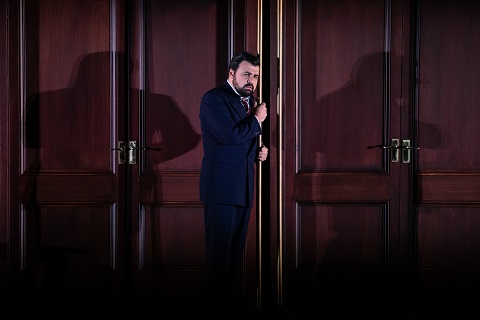 Matteo Lippi (Gustavo). Photo credit: Ali Wright.
This Gustavo is not an autocratic,
profligate monarch who abolishes the privileges of the nobility and is
challenged by a mutinous aristocracy. The motives driving Ribbing’s and
Horn’s assassination plot are personal not political: a beloved stolen, a
brother scorned. Gaitanou elects to set the tragic love triangle of
Gustavo-Amelia-Anckarström in the early 1950s. The men are dressed in
trench coats and trilbies; the women wear frocks and felt hats.
Matteo Lippi (Gustavo). Photo credit: Ali Wright.
This Gustavo is not an autocratic,
profligate monarch who abolishes the privileges of the nobility and is
challenged by a mutinous aristocracy. The motives driving Ribbing’s and
Horn’s assassination plot are personal not political: a beloved stolen, a
brother scorned. Gaitanou elects to set the tragic love triangle of
Gustavo-Amelia-Anckarström in the early 1950s. The men are dressed in
trench coats and trilbies; the women wear frocks and felt hats.
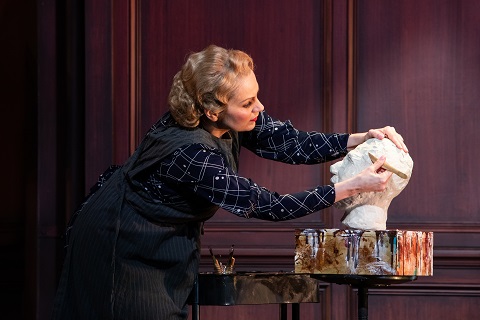 Anne Sophie Duprels (Amelia). Photo credit: Ali Wright.
Anne Sophie Duprels (Amelia). Photo credit: Ali Wright.
Not all of Gaitanou’s ideas ‘makes sense’, alone or in combination. Why are Gustavo and his peers practising their lunges, parries and ripostes during the overture? The fencing masks may foreshadow the carnivalesque masques of the final scene, and the cuts and thrusts are rhythmically in tune with the vigour and tautness of Verdi’s score, but the épées and sabres don’t make any further appearances. Why is Amelia a sculptress? We see her, beside her easel in her studio, working on a clay bust: is she sublimating her erotic desires into art? When her deceived husband later dashes the sculpted head to the floor, is this a symbol of the violence he will do to the real-life Gustavo? And, when sent to the gallows to find the herb that will cure her of her forbidden desires, why does Amelia head to hospital and check into a clinic? When the lovers are interrupted by Anckarström, she’s forced to don a nurse’s uniform and hide behind a perilously flimsy surgery screen.
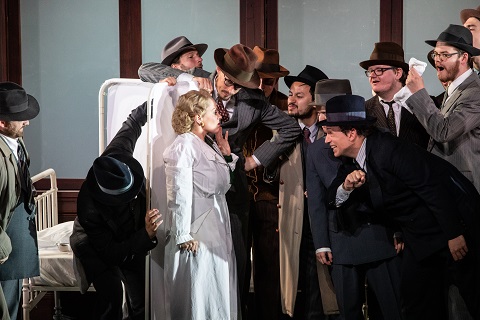 Anne Sophie Duprels (Amelia) and Opera Holland Park Chorus. Photo credit: Ali Wright.
Anne Sophie Duprels (Amelia) and Opera Holland Park Chorus. Photo credit: Ali Wright.
None of this matters, though. The singing is so uniformly strong and persuasive that we’re swept along on the increasingly tragic trajectory. Similarly, conductor Matthew Kofi Waldren - who impressed so much in La traviata last year - exercises acute control over the pacing and ensures that we’re enthralled. The musical temperature of each moment is brilliantly judged, and varied; and the passion is as much driven by rhythm as it is by melody or colour.
Matteo Lippi’s firm, appealing tenor generates warm sympathy for Gustavo, and his effortless production of sound and fine phrasing is suavely aristocratic. Lippi and Anne Sophie Duprels - a favourite at Opera Holland Park following her fine recent performances in Isabeau and Zazà - made for an impressive central pair of doomed lovers. Duprels employed a dynamic and expressive range of colour in ‘Ma dall’arido stelo divulsa’, when riven with conflicting desires - to submit to or to silence her love for Gustavo - and sang with truly affecting power in ‘Morrò, ma prima in grazia’, when pleading with her murderous husband to be able to see her son for one last time (though the baby boy is bound up in such a bumper bundle of swaddling that he looks as if he must be at least five years old!).
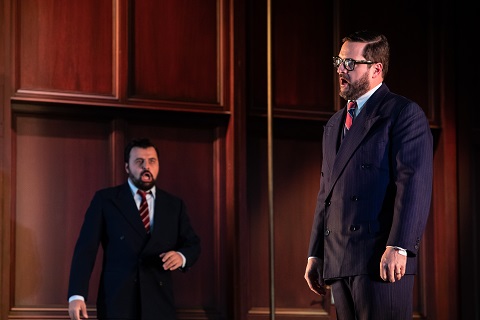 Matteo Lippi (Gustavo) and George von Bergen (Anckarström). Photo credit: Ali Wright.
Matteo Lippi (Gustavo) and George von Bergen (Anckarström). Photo credit: Ali Wright.
George van Bergen’s imposing Anckarström burned with feeling from his first to last utterance, his baritone bristling with emotion when he warned Gustavo of the imminent danger to his life and blackened by anger and pain when he vowed to gain vengeance for his former friends’ betrayal. Alison Langer , who took the title role in last year’s OHP Young Artists performance of La traviata, is a lively Oscar, as agile vocally as she is light on her feet. This was a vivacious and good-natured Oscar, whose genuine fondness for Gustavo was worn proudly on his white shirtsleeve. Langer’s soprano shone strongly and vibrantly, and her tall figure and graceful movement ensured that Oscar was both more engaging and a stronger presence in ensembles than is sometimes the case.
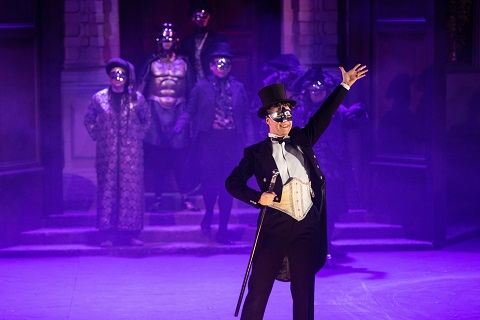 Alison Langer (Oscar). Photo credit: Ali Wright.
Alison Langer (Oscar). Photo credit: Ali Wright.
As Madame Arvidson, brandishing an elongated cigarette holder and sporting an astonishing geometrical fascinator, Rosalind Plowright looks like a cross between Marlene Dietrich and the Queen of the Night and she relished the medium’s outlandishness. John Savourin (Horn) and Benjamin Bevan (Ribbing) were convincingly nasty conspirators, while Ross Ramgobin was a lively Cristiano, the sailor whose fortune is foretold by Madame Arvidson.
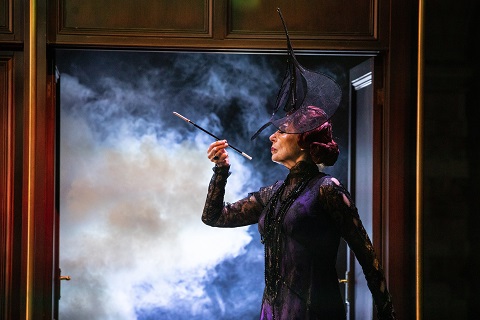 Rosalind Plowright (Madame Arvidson). Photo credit: Ali Wright.
Rosalind Plowright (Madame Arvidson). Photo credit: Ali Wright.
The eponymous revelry is a riot of costumed drama: I think I spotted Napoleon, Charles II, Anne Boleyn, a Japanese geisha, a Roman centurion, a musketeer and a highwayman amid the sparkling black and gold crowd. It was a pity, perhaps, that Gaitanou did not swing back the panels at this point - one thing the wide stage at Opera Holland Park is surely good for is a grand ball? But, pushing the cast forward to a narrow strip at the forefront of the stage, Gaitanou both sustained the sense of intrigue, the panels concealing treacheries just as the masks obscured identities, and ensured that our focus at the close was on the dead Gustavo, draped across a white stone ‘altar’, his desolate Oscar at his feet.
Claire Seymour
Verdi: Un ballo in maschera
Amelia - Anne Sophie Duprels, Gustavo - Matteo Lippi, Anckarström - George van Bergen, Oscar - Alison Langer, Madame Arvidson - Rosalind Plowright, Ribbing - Benjamin Bevan, Horn - John Savournin, Cristiano - Ross Ramgobin, Servant - Mike Bradley, Un Giudice - Ian Massa-Harris; Director - Rodula Gaitanou, Conductor - Matthew Kofi Waldren, Designer - takis, Lighting Designer - Simon Corder, Movement Director - Steve Elias, Fight Director - Bret Yount, Sculptor - Benedict Romain, Opera Holland Park Chorus, City of London Sinfonia.
Opera Holland Park, London; Saturday 8 th June 2019.
image=http://www.operatoday.com/Masked%20Ball.jpg image_description= product=yes product_title=Un ballo in maschera: Investec Opera Holland Park product_by=A review by Claire Seymour product_id=Above: The masked ball (Act 3)Photo credit: Ali Wright
A Classy Figaro at The Grange Festival
His critique of prevailing social values is treated by Mozart with lacerating humour. No surprise that Beaumarchais’s original play La Folle Journée ou Le marriage de Figaro was banned by King Louis XVI in 1784, or that Nicholas Till in his Festival programme article ‘The Quintessential Revolutionary Artist’ suggests Napoleon Bonaparte considered the play to have been “the first step towards the French Revolution”.
Mozart and Beaumarchais are uproariously subversive, yet this new production from Martin Lloyd-Evans manages to amplify both social power struggles and adulterous intrigues with great wit (not least in its Shakespearean cross-dressing and lecherous scheming) and pointedly highlight issues lurking beneath a seemingly respectable surface. There’s an undeniable sense of unease looming over this comic farce, less associated with the abuse of privilege - the Count’s claim to feudal rights over newlyweds is bad enough - more the dark underbelly of domestic strife exemplified by suggestions of alcohol addiction, self-harm and wife-beating. It’s not exactly black comedy but shades of charcoal repeatedly make a lightning strike just as you’ve been laughing at Cherubino hiding in a closet or Antonio believing he/she has suddenly grown taller as Figaro claims to have leapt from a bedroom window.
Despite the elegant period costumes and conventional designs mostly of flats and screens (respectively Kate Lyon and Tim Reed), contemporary resonances abound, aided and abetted by some well-defined performances of which some are outstanding. Chief amongst these is Toby Girling’s brutish Count Almaviva whose pugnacious, Putin-like features add much to his power-obsessed portrayal which detonates with explosive force in his Act 3 rage aria - a defining moment where his lust for vengeance is truly psychotic. Allied to a strong stage presence is a robust, well-projected baritone, flexible enough to furnish menace and warmth but his insidious bullying leaves you in little doubt of a disturbing nature.
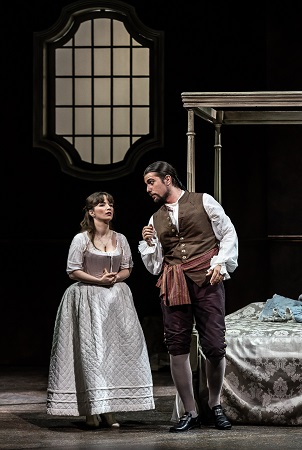 Simona Mihai (Countess Almaviva) and Roberto Lorenzi (Figaro). Photo credit: Clive Barda.
Simona Mihai (Countess Almaviva) and Roberto Lorenzi (Figaro). Photo credit: Clive Barda.
The Count’s adversary, Figaro, sung by Roberto Lorenzi is no less convincing vocally (with an emphatically delivered ‘Se vuol ballare’) yet a little old-fashioned in expression and gesture. His performance underlines the ease with which Ellie Laugharne creates a vibrant Susanna, impressing as a feisty no-nonsense wife-to-be in the opening duet, and thereafter determined to thwart the Count’s libidinous schemes, while also making sure her beloved toes the line. It’s a full flesh-on-the-bones characterisation that contrasts sharply with Simona Mihai as the neglected and emotionally crushed Countess. (Full marks for the sense of resignation achieved here but are we to believe an 18th-century Countess would not turn a blind eye to a husband’s philandering?) Her ‘Dove sono’ was beautifully sung but I was unmoved.
Of the smaller roles Rowan Pierce is an enchanting Barbarina who commands the stage with her winning glances and in just a handful of lines sings with effortless assurance to deliver a memorable cameo. Wallis Giunta as the handsome gender bending Cherubino also holds the ear and eye and superbly imitates a hip-swinging gait when dressed as a woman while supposedly being a boy - it’s all brilliant buffoonery. Her two arias are nicely turned out too, with lots of adolescent frustration in 'Non so più’ and ardour in ‘Voi che sapete’ both crowned with rapt tone.
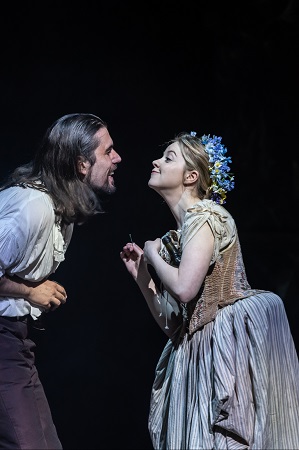 Roberto Lorenzi (Figaro) and Rowan Pierce (Barbarina). Photo credit: Clive Barda.
Roberto Lorenzi (Figaro) and Rowan Pierce (Barbarina). Photo credit: Clive Barda.
There are some distinguished moments too from Louise Winter as the manipulative then motherly Marcellina who comes into her own with her Act 4 aria. Just as compelling are Jonathan Best’s sturdy Dr Bartolo and Ben Johnson’s dapper Don Basilio who has much more than music-making on his mind every time he sees Cherubino. What a joy, too, to have that dramatic stalwart Richard Suart as the elderly but beady-eyed Antonio - a gardener very much the equal of his superiors.
Below stairs (as it were) the Academy of Ancient Music rose fitfully to the occasion. Notwithstanding an indifferent Overture, the orchestral playing under the helm of Richard Egarr steadily improved and eventually blossomed with some Mozartian magic in the Act 3 wedding festivities. But it was above stage which drew the most consistent and classy music-making.
David Truslove
Mozart: Le nozze di Figaro
Count Almaviva - Toby Girling, Countess Almaviva - Simona Mihai, Susanna - Ellie Laugharne, Figaro - Roberto Lorenzi, Cherubino - Wallis Giunta, Marcellina - Louise Winter, Doctor Bartolo - Jonathan Best, Don Basilio - Ben Johnson, Barbarina - Rowan Pierce, Antonio - Richard Suart, Don Curzio - Kamil Bien; Director - Martin Lloyd-Evans, Conductor - Richard Egarr, Designer - Tim Reed, Costumes - Kate Lyons, Lighting Designer - Peter Mumford, Grange Festival Chorus, The Academy of Ancient Music.
The Grange Festival, Hampshire; Thursday 6th June 2019.
image=http://www.operatoday.com/Grange%20Figaro%20title%20image.jpg image_description= product=yes product_title=Le nozze di Figaro: The Grange Festival, Hampshire product_by=A review by David Truslove product_id=Above: Toby Girling (Count Almaviva), Wallis Giunta (Cherubino) and Ellie Laugharne (Susanna)Photo credit: Clive Barda
June 10, 2019
A satisfying Don Carlo opens Grange Park Opera 2019
This revival featured two original cast members returning to their roles, Clive Bayley's Filippo and Ruxandra Donose's Eboli, with Leonardo Capalbo as Don Carlo, Marina Costa-Jackson as Elisabetta, Brett Polegato as Rodrigo, Branislav Jatic as the Grand Inquisitor, David Shipley as the Monk / Charles V and Jessica Leary as Tebaldo. Gianluca Marciano conducted the orchestra of English National Opera.
Central to the production are Leslie Travers stylish and imaginative sets which provide a series of striking backdrops for the intimate scenes yet facilitate creating a remarkable amount of grandeur on a relatively small stage. The production remains one of the most satisfying recent incarnations of Verdi's grand opera that we have seen.
Without the Fontainebleau Act, we never see Don Carlo and Elisabetta in their moment of untroubled bliss and the four act version of the opera has inevitably to start in media res. Leonardo Capalbo ran on, vividly emoting and we were in no doubt as to this Don Carlo's youth, humanity and sheer personal intensity. It seemed to take Capalbo some time to get the measure of the auditorium, and initially his singing came over as over emphatic. But there was no doubting his commitment and the vibrancy of his performance as he obsessed over Elisabetta. Capalbo brought a nice intensity to his quiet singing, particularly in the tense Act Two scene with Elisabetta, and by Act Three he was a changed man. Central to Capalbo's performance was the journey that Don Carlo goes on, this strutting peacock of a man learns control and balance, so that his final scene with Elisabetta was moving indeed for the understated nature of their pair's emotions, their control and maturity. This was Capalbo's role debut and his interpretation will certainly grow but this was a striking assumption. (Leonardo Capalbo will be singing the role in French with Opera Vlaanderen in the Autumn).
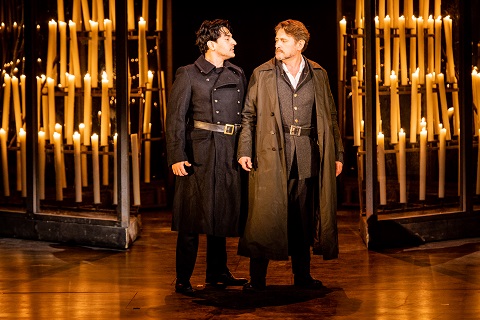 Leonard Capalbo (Don Carlos) and Brett Polegato (Rodrigo). Photo credit: Robert Workman.
Leonard Capalbo (Don Carlos) and Brett Polegato (Rodrigo). Photo credit: Robert Workman.
Marina Costa-Jackson was a name that was new to me. Born in the USA and raised in Italy, she is a relatively recent (2016) graduate from the Academy of Vocal Arts in Philadelphia. Her Elisabetta displayed great physical control, she was a woman who knew what was expected of her as a king's daughter and the wife of a king, which meant that the moments when she lost control, such as the scene with Don Carlo in Act Two and the thrilling moment with Clive Bayley's Philippo in Act Three when these two strong personalities square up to here, told indeed. Costa-Jackson's voice has a significant vibrato, which warmed the sound considerably but thankfully there was still a strong core to provide the sort of line that this role needs. Her final aria was indeed stupendous, made all the more moving for being restrained.
Clive Bayley reprised his strikingly controlled and controlling Filippo, making him not so much a martinet as a man expecting the highest standards in certain types of behaviour, and unable to understand others' failure. Central to Bayley's performance was the moment, at the opening of Act Three, when we see the private man rather than the public one and come to appreciate the depth of his lack of understanding of his fellow men. When Filippo laments that Elisabetta never loved him, the moment can be in danger of seeming a little risible, but never here Bayley really wrenched our guts.
Whilst her voice is not, strictly, Italianate Ruxandra Donose is one of the most fully-rounded performances of Eboli around. This Eboli was intimately woven into the drama of the whole opera, and you could see her delight in savouring intimate and forbidden knowledge. Donose's upper register is still beautifully flexible, thus making the Veil Song a delight, whilst still giving us a nice evenness throughout the range. She brought a real sense of drama to the whole role, so that the Act Three trio with Capalbo's Don Carlo and Brett Polegato's Rodrigo was thrillingly tense indeed.
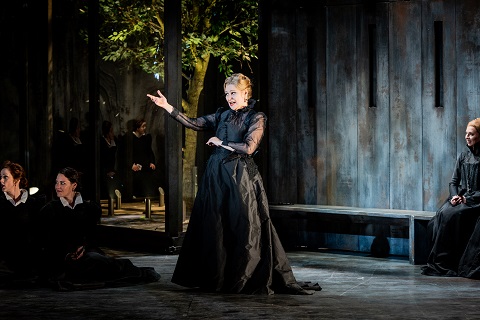 Ruxandra Donose (Princess Eboli). Photo credit: Robert Workman.
Ruxandra Donose (Princess Eboli). Photo credit: Robert Workman.
Brett Polegato's Rodrigo was very much the old soldier. His performance robust and vigorous, and in their Act One duet he and Capalbo seemed to almost be vying with each other for who could phrase the most robustly. Occasionally I missed a more suave approach to the music, but there is no doubting the vehemence and power of his Act One outburst to Filippo about the Low Countries. His relationship with Capalbo's Don Carlo was perhaps one of the least homo-erotic that I have seen in recent years, but his final death scene was moving indeed.
Serbian bass Branislav Jatic sang the Grand Inquisitor. Visuall, de created a vividly etched character, yet did not always manage to match his voice to the image, but the scene between him and Philippo remained one of the central points of the opera. Jessica Leary made a charming Tebaldo, bringing out the character's youth. David Shipley was aptly firm voiced and other-worldly as the Monk / Charles V. The smaller roles were all well taken, with Rosanna Harris as the heavenly voice, Lawrence Thackeray as the Count of Lerma and Roberto Abate as the Herald.
Jo Davies' production really facilitates the intimacy of the smaller scenes in this opera, and one of the virtues of the finely balance casting was that we had a series of very human dramas playing in front of us, all depicted in vivid detail. Yet the big moments, didn't lack grandeur and the stage rarely seemed over-crowded, with the multi-level set for the Auto-Da Fe scene facilitating a miraculous amount of compression.
Key to this was the hard-working chorus, splitting itself into a variety of group, yet always singing with focused virtuosity.
In the pit, Gianluca Marciano prized the impetus and impulse of this final version of the opera, and he and the orchestra kept the drama moving without ever making us feel rushed. The orchestra was on top form, thrilling in the big moments yet able to scale things back and the performance never threatened to overbalance what is essentially an intimate account of Verdi's grandest opera.
There is a case to be made for country house opera being a bit more imaginative in the way it distributes music and intervals, and I certainly wish that a bit of creative thinking could be used to present Verdi's Don Carlos in its five-act version. But until then, this production is one of the most satisfying accounts of Verdi's grand opera around, and here with finely balanced cast.
Robert Hugill
Verdi: Don Carlo
Don Carlo: Leonardo Capalbo, Elisabetta, Marina Costa-Jackson, Rodrigo: Brett Polegato, Filippo: Clive Bayley, Eboli: Ruxandra Donose, Grand Inquisitor: Branislav Jatic, Monk/Charles V: David Shipley; Director: Jo Davies; Conductor: Gianluca Marciano; English National Opera Orchestra.
Grange Park Opera, 6 June 2019
image=http://www.operatoday.com/Clive%20Bailey%2C%20King%20Phillip%20II%20of%20Spain%20and%20Leonardo%20Capalbo%2C%20Don%20Carlos.jpg
image_description=
product=yes
product_title=Don Carlo: Grange Park Opera
product_by=A review by Robert Hugill
product_id=Above: Clive Bailey (King Phillip II of Spain) and Leonardo Capalbo (Don Carlos)
Photo credit: Robert Workman
Ernst von Siemens Music Prize, 2019
From the first time I heard Rebecca Saunders’s music, in a 2012 Arditti Quartet concert at the Wigmore Hall , I have been intrigued, fascinated, and thrilled by it. At this ceremony and concert in Munich’s Prinzregententheater, we heard not only Saunders’s Skin ( given in London this January by the same soloist, Juliet Fraser, with the Ensemble Modern and Vimbayi Kaziboni), but also music by the three winners of Ernst von Siemens Music Foundation Composers’ Prizes: Annesley Black, Ann Cleare, and Mithatcan Öcal. When three out of four of the composers are women and the other a Turkish man, perhaps the tide is finally beginning to turn. In addition to prize money, the three recipients of composers’ prizes will also receive portrait CDs from the Kairos label, to be released at the end of this year - so helping others to discover their music for themselves.
First we heard excerpts from Black’s Tolerance Stacks, followed by a greeting from Peter Rusicka and a short film showing the composer at work. (Each composer received such a film, in other cases seen before her or his music was performed.) Fraser was the soprano soloist here too, excellent as ever. Piano, responded to by clarinet and percussion, in turn responded to by piano, set the scene, the pianist thereafter moving across to one of two electronic mixing desks in preparation for the vocal entry. Was it pain or pleasure being evoked? Why choose, amidst such a colourful, dramatic frenzy? Might one characterise what we heard as post-Stockhausen in a meaningful rather than merely chronological sense? I think so, but am not sure quite how much that would matter. The sense of electronic and vocal play was keen throughout. So too was an intriguing relationship - which I could not yet put my finger on to describe, let alone analyse, yet could certainly perceive - between sound and structure.
Cleare’s and Öcal’s works were both for ensemble without voice, all in the superlative care of Enno Poppe and Ensemble Musikfabrik, longstanding Saunders collaborators. Cleare’s on magnetic fields added to the ensemble what I presume was an instrument of her own, hybrid instrumental design being a particular musical interest of hers. (I do not even know what it was, or what it was called, but such is part of the fun!) At any rate, three chamber groups conversed, collaborated: made music, two violins from two separate groups coming across as first among equals in dialogue and competition. Sounds were often metallic, mechanical, industrial, creative, but they were no mere sounds: this was a true musical narrative, finely paced both in writing and performance. Likewise every note, attack, timbre, and duration seemed deeply considered and dramatically necessary.
Öcal’s ‘Birds without Beards’ was prefaced by a duly entertaining film, in which a member of his Istanbul Composer Collective remonstrated with him for having included a pitch, C-sharp, he had expressively ruled out, whether in itself or even as suggested by harmonic structure. Repeated pitches and their implications, perhaps rhythmic as well as harmonic, seemed to be one of the concerns from the outset here, wind notes jabbed and intoned, initially set against scurrying string figures. One was intended, I think, to notice just as keenly when those pitches were repeated and varied. Öcal offered on occasion an almost Mahlerian sense of echoed reminiscence of ‘found’ material, actually found or imagined. But those were just two aspects of an absorbing, colourful, witty showcase for the composer’s work, types of material coming into intriguing collaboration and conflict - just, perhaps, like the Collective itself.
‘It sounds how it’s played,’ as Robert Adlington once put it, cited in trumpeter Marco Blauuw’s oration for Rebecca Saunders, an oration as intelligent and insightful as it was heartfelt. ‘Stay stubborn, self-willed,’ Saunders advised her three predecessors on this evening, having dedicated receipt of her prize to her undoubtedly stubborn and self-willed predecessor as composer, Galina Ustolvskaya. Those and many other aperçus helped guide our appreciation of the performance of Skin; but mostly, like Samuel Beckett, another guiding spirit, this music spoke with a bleakness and humanity, the two quite indivisible, of its own. If the opening starkness, at least in the context of Saunders’s words, obliquely brought Ustolvskaya to mind, the poetry of music and silence, music as silence, distillation in instrumental combination, and that combination in distillation, bore Beckettian witness more strongly than ever. Breath and cries from voice and instruments alike, often in tandem, both formed and inhabited landscape and narrative. (Sometimes we need such metaphors to speak about music, but we should always be wary of ascribing them importance that is greater than whatever that music may be ‘itself’). As ever, properties of instruments, the voice included, indeed the voice foremost among them, were both respected and extended, testament to the composer’s searching, collaborative way with performing colleagues. No silence, though, was more pregnant, more magical than that following Fraser’s final, solo ‘skin’. It rightly proved a prelude resistant to, then part of, that warmest of applause that ensued.
Mark Berry
Annesley Black: excerpts from Tolerance Stacks (2016/19) ; Ann Cleare: on magnetic fields (2011/12); Mithatcan Öcal: Ein musikalischer Spaß (2017-19): ‘Birds with Beards’ (world premiere); Rebecca Saunders: Skin (2016). Juliet Fraser (soprano)/Ensemble Musikfabrik/Enno Poppe (conductor). Prinzregententheater, Munich, Friday 7 July 2019
image=http://www.operatoday.com/Rebecca%20Saunders.jpg image_description= product=yes product_title=Ernst von Siemens Music Prize, Munich product_by=A review by Mark Berry product_id=Above: Rebecca SaundersPhoto credit: Stefanie Loos
June 8, 2019
Josquin des Prez and His Legacy: Cinquecento at Wigmore Hall
We don’t know for certain if Richafort wrote his six-voice Missa pro defunctis as a memorial to Josquin, upon the latter’s death in 1521. But, it’s a tempting and not unlikely notion, given the Mass’s numerous allusions - explicit and assimilated - to compositions by Josquin. It had been thought that Richafort was one of Josquin’s pupils, though some scholars now argue that it would be more appropriate to consider them as belonging to the same artistic ‘school’.
Indeed, the programme was a palimpsest of cross-references and self-quotations. Richafort’s Mass quotes from the six-voice motet, ‘Nymphes, nappés’, which is itself based on the antiphon ‘Circumdederunt me gemitus mortis’ - the chant that Richafort introduces in canon form into each movement of the Mass. In addition, the Gradual and Offertory quote a melody setting the phrase, ‘C’est douleur non pareille’, also in two-voice canon, drawn from Josquin’s five-voice chanson ‘Faulte d’argent.
The five members of Cinquecento were joined by tenor Nicholas Todd for their performance of Richafort’s Mass, which was characterised by magnitude of expression and depth of feeling. In the Introitus, the lines extended seamlessly, seemingly sung in one unbroken breath. Individual voices were at times brought to the fore, to point a melodic elaboration or emphasise a dissonance arising, sometimes unexpectedly, from the collision of polyphonic lines. Often there was a sense of a gradual ‘freeing’ of the sound as movements progressed, the ensemble tone grounded by the tender bass of Austrian Ulfried Staber. Despite Wigmore Hall’s fine resonance, occasionally I longed for a cathedral acoustic which would lift, swell and swirl the sound in an embracing sweep. Cadences were finely graded, often ‘coming to rest’ with gentleness after the blossoming explorations, a soothing relaxation after the engendered tension. In the Graduale, there was a wonderfully reverential diminishment, ‘Non timebo mala, quoniam tu mecum es, Domine’ (I shall not fear evil, for you are with me, Lord); then, a flowering, the graceful unfolding of a bud’s petals, at the close of this movement: ‘Virga tua et baculus tuus, ipsa me consolata sung’ (Your rod and your staff, they comfort me). Throughout, Cinquecento demonstrated superb control and grading of dynamics.
Paradoxically, within the homogenous idiom in which all lines are bound to the cantus firmus which is deeply and almost inextricably embedded within the dense polyphony, there were striking contrasts. In the Offertorium, the quiet opening line of chant, ‘Domine Jesu Christe’, was followed by a blaze of rejoicing, ‘Rex gloriae’. Strange dissonances at the end of movement - ‘Fac eas, Domine, de morte transire ad vitam sanctam’ (allow them, Lord, to cross from death into holy life) -were eased and salved in the concluding phrase, ‘Quam olim Abrahae promisisti/Et semini eius’ (as long ago you promised Abraham and his seed). The ‘Sanctus’ was vigorous and purposeful, while in the Agnus Dei Cinquecento produced an elevated tone, sinking low and hushed as if in humility with the closing plea for eternal rest.
The two works by Josquin which are quoted by Richafort were interleaved between the movements of the Mass in the first part of the concert. ‘Nymphes, nappés’ was fittingly melancholy yet euphonious while harmonic, rhythmic and textural restlessness characterised ‘Faulte d’argent’. Flexibility and naturalness of utterance were also noteworthy in the Stabat mater for five voices which opened the second half of the concert: again, the expressiveness of the cadential dissonances was striking, as the flattening of the mode in the penultimate ‘Paradisi gloria’ evened into two repeated chords: ‘Amen’. Countertenor Terry Wey’s declarative ‘Inviolata’ at the opening of the eponymous five-voice motet, was followed by the flowing colour of the homage to Mary ‘whole and chaste’ (‘integra et casta’); such details offered the listener rich pathways to the deep sentiments of Josquin’s texts.
Alongside the works by Josquin and Richafort, we heard Benedictus Appenzeller’s interesting ‘Musae Jovis’ á 4, an elaborate unfolding of grief, always poised and controlled. After the pianissimo resignation, ‘Josquinus ille occidit’ (Josquin himself is dead), ‘harsh death’ (Severa mors] was assertively challenged, and there was bitterness in the final complaint against the unjust reaper who had carried off the good, sparing the evil. Interwoven through the programme were various Gregorian chants which were sung with clarity and dignity, sometimes moving from a solo voice to a persuasively blended unison. Belgian tenor Tore Tom Denys introduced ‘Absolve, Domine’, which subsequently warmed into a soothing blend of subtly nuanced lyricism.
The closing item saw Josquin himself looking back and lamenting the passing of an illustrious predecessor, Johannes Ockeghem. His ‘Déploration sur la mort d’Ockeghem’ draws on both Josquin’s own lamenting chanson, ‘Nymphes des bois’, and the Introitus Requiem aeternam of Ockeghem's Missa pro Defunctis. After the vigorous interplay of independent voices, the final line - ‘Requiescat in pace. Amen.’ - indeed brought peace, Cinquecento’s lovely sonority, here and throughout the performance, speaking of things both heavenly and human.
Claire Seymour
Josquin des Prez and his legacy
Cinquecento (Terry Whey, countertenor; Achim Schulz, tenor; Tore Tom Denys, tenor; Tim Scott Whiteley, baritone; Ulfried Staber, bass); Nicholas Todd, tenor.
Gregorian Chant - Circumdederunt me; Jean Richafort - Requiem a 6; Josquin des Prez - ‘Nymphes, nappés’ a 6; Gregorian Chant - De profundis; Josquin des Prez - ‘Faulte d’argent’; Gregorian Chant - ‘Absolve, Domine’; Benedictus Appenzeller - ‘Musae Iovis’ a 4; Josquin des Prez - Stabat mater, ‘Inviolata’ a 5; Gregorian Chant - Libera me; Josquin des Prez - ‘Nymphes des bois’ or (Déploration sur la mort d'Ockeghem).
Wigmore Hall, London; Friday 7th June 2019.
image=http://www.operatoday.com/Cinquecento-by-Theresa-Pewal-analog-22-3-1030x773.jpg image_description= product=yes product_title=Josquin des Prez and his legacy: Cinquecento at Wigmore Hall product_by=A review by Claire Seymour product_id=Above: CinquecentoPhoto credit: Theresa Pewal
June 7, 2019
Symphonie fantastique and Lélio United – F X Roth and Les Siècles, Paris
Opus 14 and 14b are meant to connect. Indeed, Lélio can be heard as an extension of the Symphonie fantastique, since together they reflect an intensely creative period in his development. The symphony, subtitled “Épisode de la vie d’un artiste ... en cinq parties” flows naturally into the Lélio, ou Le retour à la vie, mélologue en six parties. The first part addresses annihilation, the second part revival through creative art, and, heard together, they have symmetry.
When the symphony isn’t treated as a stand-alone, there is an impact on interpretation. Roth and Les Siècles use instruments of Berlioz’s period to better reflect the colours Berlioz would have used. This gives a more naturalistic, genuinely “Romantic”(big R) warmth to the performance. In “Rêveries”, diaphanous textures herald the idée fixe, which here flows with ardent purpose, establishing the . dichotomy between poetic ideals and obsession that gives this symphony such power. Four harps and shimmering strings introduce the waltz. This moment of serenity contrasted with darker timbres, might indicate that happiness may be elusive. The “Scène aux champs” is pastoral, but haunted by more poignant undercurrents. An exquisitely played cor anglais, echoed by unseen oboe: dichotomy again, suggesting that happiness might be beyond reach. Thus the “March au supplice” grows from what has gone before. The steady march is well defined, the Idée fixe leading waywardly forth. An atmospheric “Songe d’une nuit du sabbat”. Ophecliedes may reference funeral processions in Berlioz’s era, but the ominous grotesques, swirling strings and ringing bells also indicate supernatural malevolence. The demonic forces of Goethe’s Die erste Walpurgisnacht are not so very far away. Romanticism, with its instincts for what we’d now call the subconscious, marked a breaking away from the unquestioned order of the Ancien Regime.
Roth’s observant approach to structure pulls together the underlying architecture in the Symphonie fantastique, which is particularly relevant when the symphony is heard together with Lélio. Significantly, the narrator (Michel Fau) is alone as Lélio begins, the orchestra silent. This is an existential cry of anguish., delivered by Michel Fau with appropriate drama, even capturing the semi-musical cadences in the text. For Berlioz, the narration was fundamental to concept. Declamation would have come naturally to Berlioz and his contemporaries, who discovered Shakespeare, albeit in the theatrical adaptations that were then the norm, even in England. Moreover, a good narrator like Michel Fau captures the semi-musical cadences in the text, which further links words with music . Lélio is, significantly, a composer. While this is not Sprechstimme by any means, leaving out the narration, or using performances without the distinctive punch of proper French diction, diminishes the impact. “Dieu! je vis encore... Il est donc vrai, la vie comme un serpent s’est glissée dans mon cœur pour le déchirer de nouveau? “ This is an existential cry of anguish. Yet there are explicit references to the symphony. “Ce supplice, ces juges, ces bourreaux, ces soldats, les clameurs de cette populace, ces pas graves et cadencés tombant sur mon cœur comme des marteaux de Cyclopes..” In this dark night of the soul, Lélio speaks of the vision “avec son inexplicable sourire, conduisant la ronde infernale autour de mon tombeau!...”
The narration is so closely integrated into the structure that, in the “Ballad of the Fisherman” (based on Goethe’s adaptation of Hamlet), Lélio’s friend, Horatio (Micheal Spyres) sings a lilting song about a nymph while Lélio meditates on life and art. The serene song connects to evoke the waltz in the Symphonie fantastique. Again, the text references music : “Une instrumentation sourde... une harmonie large et sinistre... une lugubre mélodie... un chœur en unissons et octaves... semblable à une grande voix exhalant une plainte menaçante pendant la mystérieuse solennité de la nuit...” In the Chœur d’ombres, the choir (the National Youth Choir of Scotland, chorus master Christopher Bell) sings of death, punctuated by pounding drums - another funeral march, all the more poignant because the voices are fresh and youthful. Yet Lélio’s words are truculent. Calling on Shakespeare, he resolves to head to Naples and join brigands. In Romantic terms, the South represented freedom and wildness, the sun versus the moon, images Goethe employed so well. An artist cannot conform but must find himself through creativity. In the “Chanson de Brigands” the baritone (Florian Sempey) leads the chorus in raucous adventure. On the video transmission, the chorus members put their arms round each others shoulders and move, expressing the energy in the orchestra. Can Lélio dare hope ? “Je me vois dans l’avenir, couronné par l’amour”.
After a brief silence, the orchestra now comes into its own : beautifully limpid harps, seductive woodwinds. Now the tenor represents Lélio, singing the imaginary voice of the composer, off-stage. then even Lélio falls silent, as the orchestra creates the magic that is “Sounenirs- La harpe éolienne” where the orchestra extends the sound of the harp with winds and strings, evoking the sound of an aeolian harp, where Nature plays, vibrating through breezes. The pastoralism of “Scène aux champs” now idealized and perfect. Lélio resolves to find new life through art. “Allons! que les esprits chantent et folâtrent! que la tempête gronde, éclate et tonne!......SHAKESPEARE me protège!”. The “Fantaisie sur “ La tempête “ de Shakespeare” is Lélio’s redemption. The chorus sing”Miranda! Miranda”, and the orchestra creates the storm - both physical and supernatural - that drives her to the island where Caliban is marooned. The pounding rhythms of the idée fixe in the Symphonie fantastique return, transformed, flowing with even greater energy. Until this point, Berlioz employed the orchestra with restraint. Now, in this exhilarating climax, we hear why he needed a full ensemble supported by choir. Lélio listens, and cries “Encore! Encore, et pour toujours!...”.
Roth, Les Siècles and the voices give such an idiomatic, inspired performance that Lélio’s words seem addressed to them “votre exécution est remarquable par la précision, l’ensemble, la chaleur; vous avez même reproduit plusieurs nuances fort délicates. Vos progrès sont manifestes; je vois que vous pouvez aborder maintenant des compositions d’un ordre beaucoup plus élevé que cette faible esquisse”. The livestream, from the Philharmonie de Paris is available at this link.
Anne Ozorio
image=http://www.operatoday.com/Berlioz_Petit_BNF_Gallica.png image_description=Hector Berlioz by Pierre Petit [Source: Wikipedia] product=yes product_title=Hector Berlioz : Symphonie fantastique op 14, Lélio, ou la ou Le retour à la vie, op 14b. François-Xavier Roth, Les Siècles, Philharmonie de Paris (livestreamed). product_by=A review by Anne Ozorio product_id=Above: Hector Berlioz by Pierre Petit [Source: Wikipedia]June 6, 2019
Ivo van Hove's The Diary of One Who Disappeared at the Linbury Theatre
Though hard at work on his opera The Excursions of Mr. Broucek, which was first performed in 1920, when he returned to Brno Janáček immediately started sketching the first ten songs of what was to become a 22-song cycle for tenor, mezzo-soprano and piano, The Diary of One Who Disappeared. It set poems by Ozef Kalda that had been published in the Brno newspaper, Lidové noviny, on 14th and 21st May 1916, titled ‘From the pen of a self-made man’. The poems told the tale of a young Czech boy, Janíček, from ‘a good family’, who is seduced by ‘a dark Gypsy’, Zefka, and lured into the ‘free’ life of the traveller.
That Stösslová was the inspiration for The Diary is in no doubt: the composer wrote to her from Brno, on 10th August 1917: ‘Will you believe that I’ve not yet got out of the house? In the morning I potter around in the garden; regularly in the afternoon a few motifs occur to me for those beautiful little poems about that Gypsy love. Perhaps a nice little musical romance will come out of it - and a tiny bit of the Luhačovice mood would be in it.’ A year later, on 2nd September 1918, his mood was less optimistic: ‘It’s too bad my Gypsy girl can’t be called something like Kamilka. That’s why I also don’t want to go on with the piece. I can’t explain why you don’t write to me … I have nothing more than memories - when then, so I live in them.’
Janáček continued work on The Diary during the following two years, completing it in 1920. It was first heard at a private performance that year, and then premiered at the Reduta Theatre in Brno on 18 th April 1921. There is undoubtedly an ‘operatic’ dimension about the cycle, not least because, after the first eight songs in which the tenor recalls when he saw Zefka, songs nine to eleven act out that first meeting, as the composer turns indirect speech into direct interaction. Zefka enters at the end of song eight, and an offstage female chorus (like that which represents the soul of the Volga in Káťa Kabanová) sings the narrative of a seduction Janáček deliberately avoids portraying ‘on stage’.
In song nine, Zefka sings: “Welcome Janíček, welcome here in the wood. What happy coincidence brings you this way? What are you standing here like that for? So pale; so still; Why, are you perhaps afraid of me?” To which the young man replies, “I really have no cause to be afraid of anyone. I came here only to cut an axle-pin”, whereupon Zefka invites him to put aside his duties and to listen to her gypsy song. The remaining songs chart the aftermath of the seduction.
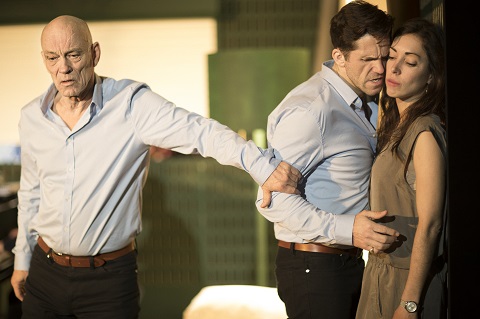 Photo credit: Jan Versweyveld.
Photo credit: Jan Versweyveld.
Not surprisingly, there have been various dramatizations of The Diary - including Shadwell Opera’s Grimeborn production in 2017. Janáček himself is reported to have said that he wanted the cycle to be performed in ghostly half-lighting. That said, the drama is present in every note of the music. The Diary does not depend for its power on overt context, gesture or symbol. That over-prescription might in fact destroy the almost visceral intensity of the work was something that I felt very strongly during this staging of Ivo van Hove’s ‘interventionist’ staging at the Royal Opera House’s Linbury Theatre. Superimposing an autobiographical narrative on the tale told in poetry, and commissioning additional music and songs from the Belgian composer Annelies Van Parys which ‘allow us to see some of the story form Zefka’s perspective’, van Hove almost doubles the work’s length while significantly diluting its expressive immediacy.
Van Hove worked with two of his regular collaborators for this 2017 production for the Belgian company Muziektheater Transparant: set and lighting designer, Jan Versweyveld, and costume designer An d’Huys. Versweyveld’s set seems to shift us forward from the latter years of the First World War to the 1960s, and from nature to ‘civilisation’: specifically, to a photographic lab-cum-studio flat, comprising kitchen, dark room, office and bedroom, the patterned lighting effects intended, I assume, to evoke the landscape of the original woodland tryst. The confined space can, however, accommodate a grand piano. Janíček (tenor Ed Lyon) is now a photographer; rather than reliving his memories through music, he projects his remembered encounter - the gypsy’s name, an image of the Romany girl - onto the lab-apartment’s walls, assisted by an elderly man (Wim van der Grijn) who, we learn, is the composer himself.
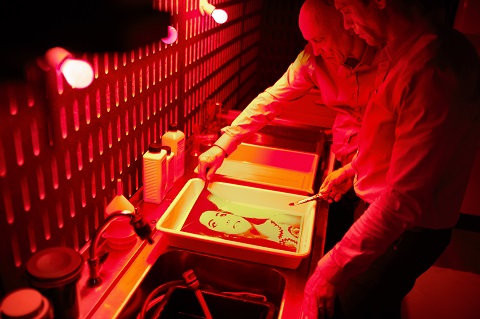 Photo credit: Jan Versweyveld.
Photo credit: Jan Versweyveld.
At the start, all is silent. A woman in red (Marie Hamard) enters and is instructed by a recorded male voice to make a cup of tea, sit at the piano and tap out a scale, some snatches of melody. It feels clunky and awkward. Pianist Lada Valesova then takes her place at the keyboard; her playing is the linchpin of the performance, every gesture redolent with a clear vision of musical meaning and empathy for the composer’s emotive language. What a pity the piano lid remains closed throughout, though this does not prevent Valesova from conjuring emotional fire and frailty with equal insight and impact.
Lyon’s singing is fervent and precise, though there’s a lack of Slavic colour and passion, for all the rolling around on the carpet in which he and Hamard indulge. But, Lyon also conjures a telling sincerity and vulnerability which is countered by Hamard’s vocal strength. Van Parys’ music merges into Janáček’s songs with surprising persuasiveness, though I can’t help but feel that Janáček’s decision to allow the gypsy’s voice to be heard only in the central encounter strengthens the yearning and desire communicated by Janíček.
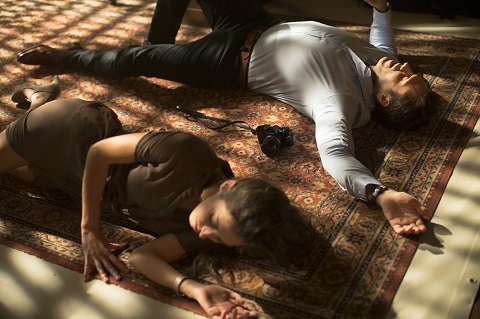 Marie Hamard and Ed Lyon. Photo credit: Jan Versweyveld.
Marie Hamard and Ed Lyon. Photo credit: Jan Versweyveld.
There’s nothing amiss with the ‘quality’ of the individual performances. But, the whole is strangely cold and clinical. One thing that is sadly missing is the exoticism of the ‘gypsy’; a red ‘business dress’ and hooped earrings don’t really compensate. Writing to Stösslova from Hukvaldy in July 1924, the composer declared, ‘And Kát’a, you know, that was you beside me. And that black Gypsy girl in my Diary of One Who Disappeared - that was especially you even more.’ Later, in April 1927, a year before his death Janáček wrote, ‘Wherever I am, I think to myself: you can’t want anything else in life if you’ve got this dear, cheerful, black little ‘Gypsy girl’ of yours’.
At the time of The Diary’s composition, there was considerable prejudice against the gypsy population in Moravia, and the cycle’s original text had included political comments about the need for a gypsy homeland (and indirect plea, perhaps, for a Czech homeland). Janáček scholar Michael Beckerman’s observations are instructive: ‘For centuries the Gypsies, hated and reviled, nonetheless furnished material for myriad erotic fantasies, becoming the dark tabula rasa on which all the base and sensual fantasies of white society were projected.’ In 1918 the new country of Czechoslovakia was formed, guaranteeing equal rights to all citizens - including 20,000 gypsies: ‘far from being a harsh, disturbing or sinister presence, the Gypsies at this time functioned as what we might call “orientalism from within”, an exotic symbol of freedom, passion and improvisation.’ Van Hove almost completely ignores, or destroys, this - surely fundamental - dimension of the work.
At the close of van Hove’s realisation, the seated figure of Wim van der Grijn reads and then burns his letters to Stösslova, dropping the flaming pages into a waste-paper bin. His unfulfilled dreams now ashes, he climbs into the small bed, presumably ready for death. But, The Diary ends in defiance and hope, not despair. Originally the vocal climax came in song 14, the height of Janíček’s desolation and hopelessness, “Oh what have I lost!” But, Janáček’s revisions shifted the emotional peak to the final song, which rises to a top C: “All that is left is for me to say goodbye forever.” And, with a farewell to his father, mother and little sister, “the apple of my eye”, Janíček departs: “Zefka is waiting for me with our son in her arms!”
Van Hove’s staging is refined where it could be raw; elegant where it could be elemental. He denies us intimacy, immediacy - an intensity, recalling the string quartets, which draws us into the stories the composer tells, whether fictional or autobiographical. And, he denies us the hope and consolation that Janáček’s final song exudes.
Claire Seymour
The Diary of One Who Disappeared : Leoš Janáček and Annelies Van Parys
Tenor - Ed Lyon, Zefka - Marie Hamard, Actor - Wim van der Grijn; Director - Ivo van Hove, Set/lighting designer - Jan Versweyveld, Costume designer - An d’Huys, Dramaturg - Krystian Lada.
Linbury Theatre, Royal Opera House, London; Wednesday 5th June 2019.
image=http://www.operatoday.com/Diary%20ROH.jpg image_description= product=yes product_title=The Diary of One Who Disappeared: Linbury Theatre, Royal Opera House product_by=A review by Claire Seymour product_id=Above: Wim van der Grijn, Ed Lyon and Marie HamardPhoto credit: Jan Versweyveld
The Royal Opera Tours to Japan in September 2019
In September 2019, The Royal Opera will present performances of David McVicar’s sumptuous staging of Charles-François Gounod’s masterpiece Faust, and of Keith Warner’s psychologically probing and moving production of Giuseppe Verdi’s Shakespeare-inspired opera Otello. All performances are conducted by The Royal Opera’s Music Director Antonio Pappano.
Faust opens the tour on Thursday 12 September 2019 and features a cast including Italian tenor Vittorio Grigòlo in the title role, Italian bass-baritone Ildebrando D’Arcangelo as his diabolic companion Méphistophélès and American soprano Rachel Willis-Sørensen as Faust’s lover Marguerite. The production was last performed by The Royal Opera in April 2019.
The opera tells the story of the philosopher Faust’s ill-considered pact with the devil Méphistophélès, who offers him youth and the love of the beautiful Marguerite, in exchange for the philosopher’s soul. All too soon, Faust realizes that his quest for pleasure may have disastrous consequences.
This production sets the action in Paris in the early 1870s, draws parallels between the experiences of Gounod and Faust, and revels in the opera’s gothic elements. Themes of love, betrayal and the battle between good and evil are brought to life through the spectacular set designs of Charles Edwards, elegant costume designs by Brigitte Reiffenstuel and atmospheric lighting design by Paule Constable. David McVicar’s staging is revived by Bruno Ravella. The vigorous original choreography by Michael Keegan-Dolan is revived for this run by Emmanuel Obeya.
Verdi’s penultimate opera Otello opens on Saturday 14 September 2019 and features a cast including American tenor Gregory Kunde in the title role, Armenian soprano Hrachuhi Bassenz as Desdemona and Canadian bass-baritone Gerald Finley as Iago. The production was last seen at the Royal Opera House in June 2017.
Designer Boris Kudlička’s semi-abstract sets and Kaspar Glarner’s period costumes highlight the contrasting innocence of Desdemona and malevolence of Iago, while Bruno Poet’s lighting designs reflect Otello’s increasingly troubled emotions. Warner sensitively examines the relationships between Moors, Turks and Westerners in Shakespeare’s time, and shows how Otello feels an outsider in his society, which contributes to his loss of confidence and gradual mental collapse. For this run of performances, Keith Warner’s staging is revived by Royal Opera Staff Director Julia Burbach.
Faust opens the tour at Tokyo Bunka Kaikan in Ueno Park on 12 September 2019, with subsequent performances on 15 and 18 September 2019. The production also visits Kanagawa Kenmin Hall in Yokohama on 22 September 2019. Otello opens at Kanagawa Kenmin Hall on 14 September 2019, with an additional performance on 16 September 2019, and visits Tokyo Bunka Kaikan on 21 and 23 September 2019.
image=http://www.operatoday.com/Left%2C%20Faust%2C%20Act%20II%2C%20The%20Royal%20Opera%20%282011%29%20%C2%A9ROH%20Catherine%20Ashmore.png
image_description=
product=yes
product_title=The Royal Opera tours to Japan in September 2019
product_by=
product_id=Above: Faust, Act II, The Royal Opera (2011)
Photo credit: Catherine Ashmore
Manon Lescaut opens Investec Opera Holland Park's 2019 season
The decade when black-and-white was trumped by technicolour; when Mary Quant’s mini-skirts liberated women, and when freedom of physical movement was matched by new opportunities for women that would have seemed equally outrageous just a few years before; when the legalisation of the pill meant that feminine dreams and aspirations soared beyond marriage and motherhood. The years which saw the rise of ‘second-wave’ feminism hardly seem an apt moment in history to choose to tell a tale of the derision, punishment and death of a ‘fallen woman’?
Second, given that it is the ‘gaze’ of her lovers and of society at large -
a gaze which objectifies her as something to be looked at, a bird in a
golden cage - which is the destructive force which drives Manon’s to
self-damage, despair and finally death, why do Sofulak and designer George
Johnson-Leigh give us so little to look at? “Heavens, how
beautiful she is!” cries Des Grieux when he sees Manon for the first time,
as the students reassure him that this “fair and divine angel
has come from heaven for your delight”. “She is too lovely!” marvels
Geronte. “Am I beautiful?” Manon asks herself as she anxiously awaits Des
Grieux’s arrival. Admiring herself in the mirror she delights, “Oh, I shall
be the most beautiful!” Surely, we should be as compelled by the spectacle
which is Manon’s tragic history as are those whose eyes are drawn to, and
mesmerised by, the eponymous heroine herself?
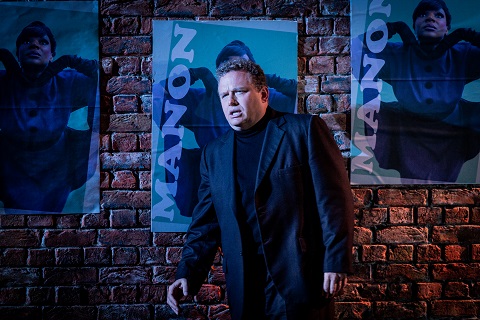 Peter Auty as Les Grieux. Photo credit: Robert Workman.
Peter Auty as Les Grieux. Photo credit: Robert Workman.
Sofulak and Johnson-Leigh eschew the four settings which Puccini’s team of librettists drew from Abbé Prévost’s 1731 novel, L’Histoire du Chevalier des Grieux et de Manon Lescaut. This is a pity as the original settings form four distinct tableaux which take us from Amiens to Paris, on to Le Havre and finally to Louisiana, articulating through the progression of time and place the stages of Manon’s tragedy, and thereby binding the discontinuous plot.
Instead of the public squares in Amiens and Le Havre, we have a club-bar, in Acts 1 and 3, where the ‘students’ party - singing, drinking, doing The Twist, playing Twister (they don’t appear to be smoking marijuana or taking LSD). Geronte’s sumptuous Parisian salon is replaced by a down-at-heel pad, furnished with some shabby red chesterfields and a drab dressing-table. And, finally, the parched Louisiana wasteland near New Orleans is swapped for a brick wall and a lamppost. We are ‘anywhere’ and ‘nowhere’. This Manon does not so much as die in the desert as expire in a deserted street, dissolving enigmatically into the darkness.
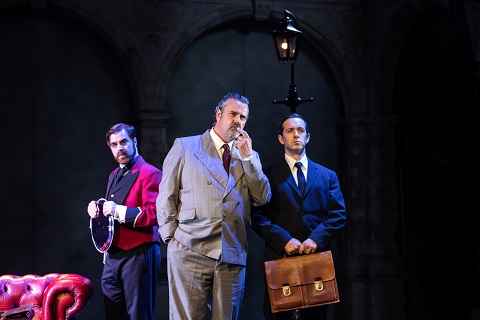 Stephen Aviss as Edmondo, Stephen Richardson as Geronte di Ravoir and Alistair Sutherland as Innkeeper/Sergeant. Photo credit: Ali Wright.
Stephen Aviss as Edmondo, Stephen Richardson as Geronte di Ravoir and Alistair Sutherland as Innkeeper/Sergeant. Photo credit: Ali Wright.
Admittedly, the busy action of Act 1 is well-choreographed (Tim Claydon), and the stage action and stage music - with the Opera Holland Park Chorus in strong voice - create a fertile ambience for the first meeting of Des Grieux and Manon. Stephen Aviss’s Edmondo and Alistair Sutherland’s bartender make a particularly strong impression. But, surely no one would be enticed by the ‘luxury’ of Geronte’s apartment; and, no would-be Jean Shrimpton or Twiggy would be seen dead in the ghastly green and blue get-up that Manon wears.
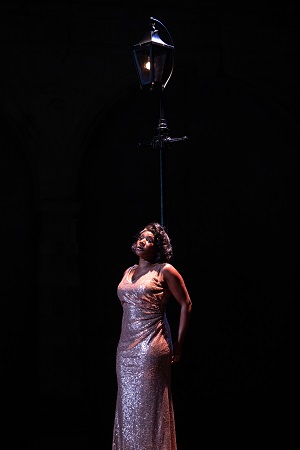 Elizabeth Llewellyn as Manon. Photo credit: Ali Wright.
Elizabeth Llewellyn as Manon. Photo credit: Ali Wright.
The good news is that there is much fine singing to enjoy. The announcement pre-curtain that soprano Elizabeth Llewellyn had only recently recovered from laryngitis was inauspicious, and Llewellyn understandably played it safe at first. But, when in the latter stages, reassured that her voice would hold out, she relaxed and released a wonderfully expressive and dramatic flood of glorious colour, the wait was proven more than worthwhile. In fact, the slight frailty at the start was not inapt, capturing as it did some of the innocence of the young Manon (especially as she is not presented here as a young girl being escorted to a convent), and the blossoming of Llewellyn’s soprano in the final two Acts communicated the maturity and growth borne of Manon’s experiences. Llewellyn exploited the full range of her soprano, including a rich chest voice, encompassing a vast emotional spectrum and sensitively capturing Manon’s femininity. As Manon finds herself at the limits of her resilience, so Llewellyn pushed her soprano to its limits, though never sacrificing her creamily smooth legato, with compelling power and effect. As her voice recovers fully, Llewellyn’s performance will be a persuasive reason to see this production.
Tenor Peter Auty was consistent and strong as Des Grieux. Auty displayed just one timbre (fittingly Italianate) and employed a single volume (loud), but he negotiated the rises to the top smoothly, if without subtlety, and sang with intensity, just about usustaining the vocal passion to the close. It was a pity that such vocal intensity was not matched by dramatic credibility: there was no hint of the light-hearted student of the first scene, nor of the bewitched lover. For there was a strange sense of disengagement between the two lovers and the love duet didn’t make the theatrical impact that it should - though that’s perhaps not surprising when the pair were so often positioned yards apart even as Manon pleads, “In your arms clasp Manon who loves you! … hold me close to your breast!”
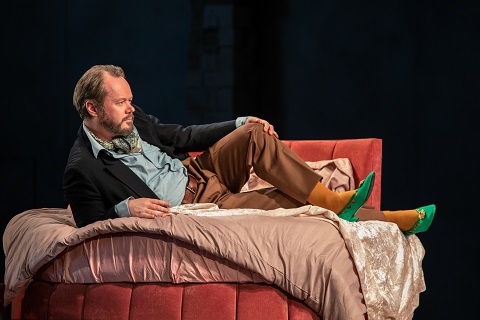 Paul Carey Jones as Lescaut. Photo credit: Ali Wright.
Paul Carey Jones as Lescaut. Photo credit: Ali Wright.
Puccini doesn’t lavish much time and attention on Lescaut, but Paul Carey Jones made more of this amateur pimp than both score and libretto imply. His baritone is light and slick - just right for this oleaginous conman. Stephen Richardson was a similarly unpleasant Geronte, cruel, authoritative and vocally powerful. Ellie Edmonds’ Singer and John Wood’s Dancing Master both made a strong impression.
Conductor Peter Robinson drew a disciplined performance from the City of London Sinfonia; the Act 3 intermezzo was particularly absorbing, the strings sounding plusher than their numbers should have allowed. Elsewhere, while there was attention to detail, there was sometimes a lack of Puccinian sentimentality, but Robinson paced the drama effectively.
Sofulak’s production has one, significant redeeming feature. If Manon’s arrest at the end of Act 2 passes by practically unnoticed, then her humiliation in Act 3 is superbly staged. The roll call of prostitutes become a parade of replica Manons - glittering in identikit gold lame gowns, expressions frozen in contemptuous indifference. As they form a circle around Llewellyn now our gaze is fixated on the visual spectacle on stage, just as the sneering oglers feast on the women displayed before them. There is delight but also discomfort as, at last, the raw power and theatrical punch of Puccini’s score makes its mark.
Claire Seymour
Puccini: Manon Lescaut
Manon Lescaut - Elizabeth Llewellyn, Chevalier des Grieux - Peter Auty, Lescaut - Paul Carey Jones, Geronte de Revoir - Stephen Richardson, Edmondo - Stephen Aviss, Singer - Ellie Edmonds, Dancing Master - John Wood, Innkeeper/Sergeant of the Royal Archers - Alistair Sutherland, Backing Singers (Hannah Boxall, Susie Buckle, Lara Rebekah Harvey, Ayaka Tanimoto), Shadow Manons (Angelica Barroga, Isabella Martinez, Hanan Mugga); Director - Karolina Sofulak, Conductor - Peter Robinson, Designer - George Johnson-Leigh, Lighting - Rory Beaton, Choreographer - Tim Claydon, Opera Holland Park Chorus, City of London Sinfonia.
Investec Opera Holland Park, London; Tuesday 4th June 2019.
image=http://www.operatoday.com/Shadow%20Manons%20title.jpg image_description= product=yes product_title=Manon Lescaut: Investec Opera Holland Park product_by=A review by Claire Seymour product_id=Above: Elizabeth Llewellyn as Manon Lescaut with Shadow Manons and the Opera Holland Park ChorusPhoto credit: Robert Workman
June 4, 2019
Karlheinz Stockhausen: Cosmic traveling through his Klavierstücke, Kontakte and Stimmung
What was so beautifully crafted about these two concerts was the indisputable linear logic to them. To those who find Stockhausen enigmatic and random - and there is much of this in his music that is both - there was ample evidence here of a composer (and performer) working in a progressive way. Pierre-Laurent Aimard’s programming of the Klavierstücke I-XI was not numerical but was crafted to internalise - and externalise - what would come afterwards. Klavierstück X, which came just before the interval of the first concert, is a piece that stands in relation to both Kontakte and Stimmung, works which would follow it in these concerts. The hammering clusters of Klavierstück X will take on a new form in Kontakte just as the sonorities of the piano and its decaying voices will foreshadow the new-world that Stockhausen created for Stimmung. But if Stockhausen is about anything he is about geometry - and where Aimard began his journey through the Klavierstücke, in the humming, vocal patterns of the early pieces, to its conclusion in X, and especially XI, with its polyvalent structure and unpredictable randomness, London Voices were to end their performance of Stimmung almost four hours later in a similar state of unpredictability.
Stockhausen described his Klavierstücke as “drawings”. When I reviewed David Tudor’s landmark recordings of these pieces last year, I interpreted this description by Stockhausen as ‘evolutionary’ - in part because drawings by their very nature can be fragmentary and incomplete. It was certainly the case some of these pieces went through substantial revision (VI went through such change that Tudor’s recording of it is the 1955 version and not the one which we hear today from 1960/61). But just as evolutionary is the kind of playing we hear in this music. Early pioneers of the Klavierstücke, from Tudor himself, to Aloys Kontarsky (who premiered XI) and Frederic Rzewski (who premiered X) brought enormous discipline and virtuosity to the keyboard but pianists today - and most notably Aimard - approach these pieces in a much broader musical context. Try as you might to hear inflections of Brahms, Bach, Ravel or Messiaen in performances of the Klavierstücke from the late 1950s and early 1960s you just won’t latch on to it. Aimard, on the other hand, simply fleshes out colour in these works - these are no longer drawings, but full-scale canvases lavished with detail, brush strokes taken to every fine line of what Stockhausen originally drew until what we end up with is a complete masterwork.
Perhaps Aimard was teasing us a little by starting with III. It was the Klavierstück which was composed first in the cycle - but it also happens to be the shortest work Stockhausen ever wrote, at just over 30 seconds long. I-IV form a kind of sonata and Aimard’s approach was to take it this way - but what magnificent brutalism he fired this music with, as if stripping away the piano keys like bark from a tree. Often the instrument felt synthesised, forward-looking, Aimard entirely at one with treating these early pieces as experimental art. Those inner voices were often heavenly articulated - in IV, for example, Aimard would stretch the concept that hands playing at different pressures could project the idea of opera in action.
If the progression of this first half meant you often got more splintered, resonant blasts of destruction, the latter part was built on sculpture. Think more of Giacometti’s Femme égorgée, which brutalises and distorts, and is like a torn open crustacean - or, the fragmentary semi-allusions of Bruno Catalano which suggest something both visible and invisible - or, in the case of these later Stockhausen Klavierstücke works defined as much for their sound as they are for their silence. The oscillating tempos of VI, and how the work collapses into sections of vast swells of sound and silence, can make it treacherous for both pianist and audience. But like Stimmung, it’s a work which is best seen as a vast paradise of meditation. Aimard was superb at using the pedals to give the piano a decaying echo - but what was most striking was the Gallic colour which he brought to his playing. I’m not sure I’ve ever heard a performance of VI which conjured up so much halo-like luminosity beside the bleakness of the clusters.
Klavierstücke IX-XI, which ended the first part of this programme, are simply extraordinary works. The opening of IX is unforgettable - music of such inexorable power it obliterates everything that has come before it. If there was a palpable sense of struggle to Aimard’s playing through that first section, where a chord is played 139 times in a gradual decrescendo (and then played again another 87 times with the same dynamic decrescendo) it felt entirely intentional. And randomness is entirely intentional in XI, a piece that will never be the same in any two performances. Labyrinthine, unpredictable, perhaps closer to some of the piano writing of John Cage like 4’33 or Morton Feldman’s Intermission 6, it rather defies description in performance because it has no comparison. Lengths of it vary - simply because where you start and where you end depends on how long it takes to play each fragment three times. All I can say of Aimard’s performance is that it seemed both timeless and finite, but as random as a snowflake in shape and form.
And so to X. This volcanic, explosive piece - played with fingerless gloves - is torrential. Perhaps more than in any of the other Klavierstücke this was the one where Aimard most brought comparisons to Giacometti and Catalano - contrasts between the blistering glissandi and tremor-like clusters against the vanishing, disintegrating silences were utterly profound. Fists and elbows thrashed and pummelled the keyboard with a pyroclastic force - but the clarity of Aimard’s unravelling of the gossamer gauze of dense scoring had a Bach-like clarity. Stockhausen demands his pianist take this music as fast as possible - as he does, incidentally, most of these Klavierstücke - and Aimard simply didn’t hold back. As with everything that had preceded it, the virtuosity just seemed to push boundaries.
Kontakte , which came after the interval, still strikes me - even today - as a radical work. It’s a piece I’ve always rather preferred to listen to in concert with my eyes firmly shut specifically because everything is engineered towards the ears. But, Kontakte is in part a highly visual work - and it was undoubtedly fascinating to see Pierre-Laurent Aimard extend his skills beyond playing the piano into elements of the second percussion player here. If this is music that is about time and space, about pulse, pitch and its polar opposite, the fusion of electronics and pure instrumentation it is also music which is about reaction and contradiction, the interlocking of rhythms and the entire spectrum of different tones.
There is a similarity in the piano part to Klavierstück X in that the music shifts between vast glissandi and crests of massively weighted chords tempered with sudden silences. The percussion (here played by Dirk Rothbrust) is in conversation with both the pianist and the electronic diffuser (Marco Stroppa) - but also his own personality. Aimard was himself a witty interloper on percussion mirroring Rothbrust’s playing on everything from bamboo rattles, claves, bongos filled with beans, crotales and gongs. In essence, Aimard and Rothbrust gave a seminal lesson in contact musicianship - and with it related entirely to create a spatial narrative that connected entirely at one with the audience. With Stroppa’s electronics giving bandwidth to what we were hearing from the two performers on stage it became an overwhelming aural experience.
Although we heard Stimmung with pretty much no interval - the Aimard concert having run to almost 150 minutes in length - the difference in pace and tone was noticeable almost immediately. There is a comforting minimalism to a lot of Stimmung and its kaleidoscope of overlayered voice frequencies remains hypnotic no matter how many times one hears the work (this was my fourth concert of it in little under two years). What also remains somewhat magical about it is that performances of it rarely identify as similar - and this one, given by London Voices, was striking in one very obvious way in how the work ended.
There was, it is true to say, a little too much reverberation from the microphones for my taste either because I was so close to the performers (I could literally see the time on their watch faces) or just because of the relative intimacy of the Purcell Room. But the clarity of the diction was impeccable, the phonetics of the complex vowel combinations tight and lucid, the distinctions between the upper and lower voices so finely attuned and balanced. Ideally, I might have wanted greater contrast between the two tenors but what we had never inhibited what we heard.
Where this performance differed from the previous ones I have recently been to was in the ending. The resolution of this work always fills me with a sense of dread - a deficit of my autism - because of the whistling. It is certainly marked as such in Stockhausen’s score of the work, but here we got something closer to overtone whispers that faded away. There was undoubtedly effortless virtuosity, with a freshness of insight to this performance by London Voices. Stimmung often embraces everything that seems prohibitive about 1968 (revolution, drugs, sex) even though Stockhausen’s inspiration for the work has a childlike simplicity which looks in the opposite direction to this. It was probably an unintended consequence of London Voice’s performance that I left this concert some 75 minutes later infused with the more radical aspects of 1968.
As demanding and challenging as this evening was, it was also unequivocally one of the highest artistic order imaginable. Few who heard Aimard’s Klavierstücke are likely to ever forget them. But this Southbank Stockhausen season, from the extraordinary Donnerstag aus Licht through to this impeccably designed programme of two events, were fascinating insights into a composer who is as revolutionary and radical today as he was more than half a century ago. He is, as this series was titled, a Cosmic Prophet.
Marc Bridle
Klavierstücke
and Kontakte
Pierre-Laurent Aimard (piano), Dirk Rothbrust (percussion), Marco Stoppa
(sound diffusion)
Queen Elizabeth Hall, London; Saturday 1st June 2019, 7.30pm.
Stimmung
London Voices: Joanna Forbes L’Estrange (soprano), Laura Oldfield (soprano)
Clara Sanabras (mezzo), Richard Eteson (tenor), Ben Parry (tenor), Nicholas
Garrett (bass), Ian Dearden (sound projection)
Purcell Room, London; Saturday 1st June 2019, 10.15pm.
image=http://www.operatoday.com/Pierre-Laurent%20Aimard.jpg image_description= product=yes product_title=Stockhausen, Cosmic Prophet: Royal Festival Hall product_by=A review by Marc Bridle product_id=Above: Pierre-Laurent AimardJune 3, 2019
Longborough Festival Opera announces collaboration with The Academy of Ancient Music in 2020
The production will also mark Longborough Artistic Director Polly Graham’s directing debut at the festival.
Photo credit: Matthew Williams-Ellis
Don Giovanni at Garsington Opera
In comparison with the engaging, comforting business which populated the overture to The Bartered Bride the previous evening, the overture foreplay which director Michael Boyd has devised for his new production of Don Giovanni at Garsington Opera unsettles and generates questions and debate.
It’s both enigmatic and edgy. On the one hand, one asks what the visual display has to do with the drama that one hears being prepared in the orchestral overture; especially as Garsington’s Artistic Director, Dougie Boyd, conducts the Garsington Opera Orchestra with a taut baton that whips up real fire from the light chattering, then, with dramatic fluency, lets the fierceness subside into flowing melody. Then again, the notion of Don Giovanni as an ‘artist’ whose vision raises him above mere ‘mortals’, granting him privileges and prerogatives which some might see as abusive, is not an inapt trope for the modern age.
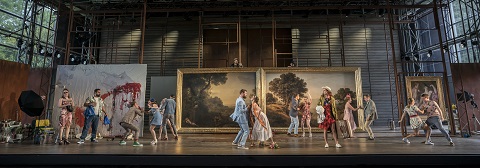 Thomas Faulkner (Masetto), Mireille Asselin (Zerlina) and Garsington Opera Chorus. Photo credit: Johan Persson.
Thomas Faulkner (Masetto), Mireille Asselin (Zerlina) and Garsington Opera Chorus. Photo credit: Johan Persson.
Designer Tom Piper places the action in Don Giovanni’s grand atelier; spacious and airy, it would be the envy of many a struggling young artist. Alongside the Pollock-splashes rest huge canvases à la Manet and Claude Lorraine - the latter are perhaps useful subsequently, in hinting at the original ‘rural peasant’ status of Masetto, Zerlina and their buddies. Painters’ scaffolding protrudes behind the framed masterpieces and will later emerge like a children’s giant climbing-frame.
The opening is striking and thought-provoking. The challenge, though, is to sustain the concept, and here almost immediately the dramatic continuity is broken, when Don Giovanni emerges clutching Donna Anna, who seeks to evade his predatory embrace, and not Donna Elvira, who had so obligingly joined him behind the canvas.
For a while, Boyd tries to sustain the metaphor. The Commendatore appears wearing what look like pale-blue pyjamas (the sun is blazing outside the Garsington pavilion) and is promptly murdered by the splattering emissions of a fire extinguisher filled with crimson-red gouache … it certainly looks very bloody, and there’s lots of mopping up for Leporello and Don Giovanni’s black-clad protection-officer heavies to turn their brooms and sponges to (doubtless health and safety intervened here, too).
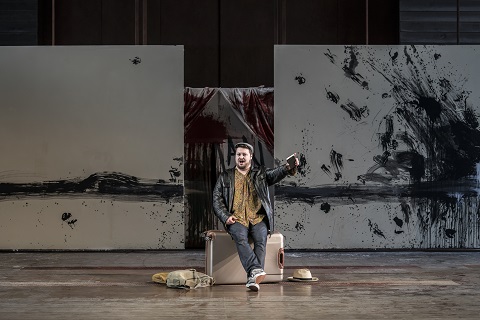 David Ireland (Leporello). Photo credit: Johan Persson.
David Ireland (Leporello). Photo credit: Johan Persson.
Thereafter, though, art - in a visual sense - is largely forgotten and we return to da Ponte’s original tale. This would-be Andy Warhol or Damien Hirst wears a red and gold brocade coat and, the masked trio tell us, is armed with a sword. Admittedly, the Don whips out a camera to entice Elvira’s maid down from her balcony - references to Mario Testino, Terry Richardson and Bruce Weber et al, here, perhaps? And, the grand masterpieces serve as a graffiti playground when, during the dancing and drinking they are crudely defaced with black paint. In Act 3 the Commendatore’s gravestone is a grey-white canvas upon which Donna Anna daubs: “Here I wait for vengeance on the faithless man who murdered me”. As night draws in during the second half, there are chiaroscuro effects (lighting - Malcolm Rippeth) of which Caravaggio would be proud.
But, on the whole, the concept languishes. And, there’s little direction of either soloists or chorus: the wide Garsington stage is a big space for singers to be left standing about. In the catalogue aria, Elvira and Leporello simply squat on her silver suitcase and look through the Don’s little black book. In ‘Là ci darem la mano’, though the shortening, then overlapping, phrases of the music bring the lustful Giovanni and the tempted Zerlina ever-closer, here we they keep a tense distancing: a red carpet is unfurled to lure Zerlina to the Don’s ‘palace’, but the characters remain 20 feet apart; despite asking for Zerlina’s ‘hand’, Giovanni seems to have his own in his pockets.
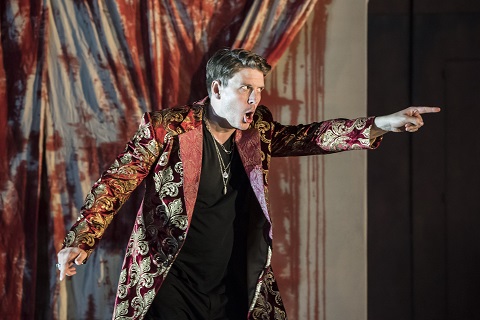 Jonathan McGovern (Don Giovanni). Photo credit: Johan Persson.
Jonathan McGovern (Don Giovanni). Photo credit: Johan Persson.
On the previous evening, the chorus scenes in The Bartered Bride had been choreographed to crossed-‘t’ and dotted-‘i’ perfection but remained naturalistically engaging. Here, the choruses were disordered and the movements seemingly random: perhaps that was the intent, but the music - in the dance sequences especially - speaks of patterns which represent hierarchies, to be sustained or smashed depending on your political point-of-view: “Viva la libertà!” the masqueraders cry.
And, speaking of social hierarches, this is one aspect of the opera that is dissolved by the artist’s paint stripper. Don Giovanni may tell Zerlina that he’s a gentleman, but his swagger, tight black ti-shirt and silver chain speak more of East End barrow-boy turned City trader. Jonathan McGovern - last year’s Papageno - gesticulates with a flourish, spins extravagantly and throws a mean punch. He might be addressed as “His Lordship”, “His Excellency”, but he is no aristocrat, though. McGovern sang with strong tone, a flexible line and dramatic colour. Don Giovanni’s champagne aria may have been delivered at a fairly steady tempo, but this ensured clarity and accuracy. But, this Don is not regal or refined: in Act 3 he stuffs down fistfuls of the takeaway chicken and chips that the put-upon Leporello has served up, smothering them in ketchup seemingly dispensed from a giant paint-gun, with the same reckless abandon with which he had killed the Commendatore. Nor is he a ‘seducer’; bully, braggart and bruiser, perhaps, but romancer, no.
Fortunately, the cast’s singing is accomplished. David Ireland’s Leporello is beaten and abused - and such thuggery further coarsens his ‘Lordship’ - but he sang with defiance and strong character. Ireland and McGovern have quite a similar tone and range, which worked well when master and servant swapped clothes: in the wooing scene, as he manically mimicked his ‘off-stage’ master’s gestures, Ireland introduced a welcome comic note into this dramma giocoso.
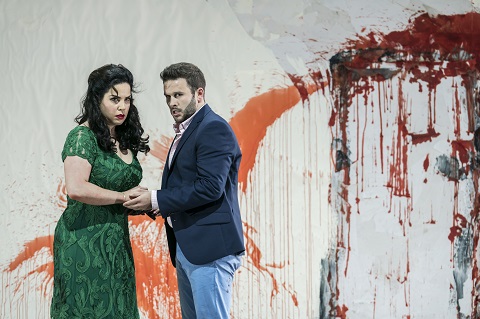 Camilla Titinger (Donna Anna), Trystan Llŷr Griffiths (Don Ottavio). Photo credit: Johan Persson.
Camilla Titinger (Donna Anna), Trystan Llŷr Griffiths (Don Ottavio). Photo credit: Johan Persson.
Trystan Llŷr Griffith’s Ottavio was a strong presence in the ensembles and deservedly got to sing both of his arias, in which he demonstrated sensitive variation and gradation of colour, warmth and strength: he earned his rich applause. But, it was a shame that just as his second aria, ‘Il mio tesoro’, in which Ottavio attests to his determination to make sure that Donna Anna gets her revenge on her father’s assassin, had to battle against the distraction of Donna Anna’s art vandalism, so during ‘Dalla sua pace’ Anna’s entry into the audience-space and her ascent of the wooden aisle risked diverting attention from the vocal prowess and sensitivity on stage.
Camilla Titinger had some fine moments as Donna Anna, and these were warmly appreciated by the audience; but there were some tuning problems, and her projection was inconsistent: I found her less than communicative in the recitatives and ensembles. That said, Donna Anna’s ‘Non mi dir’, though perhaps a little slow, was expressive.
Mireille Asselin took a while to warm up dramatically as Zerlina - initially it didn’t seem as if she had any genuine affection for Masetto or real attraction to Don Giovanni - but when she got into her stride, she found her musico-dramatic shoes and wore them with style. ‘Vedrai, carino’ was particularly persuasive and beautifully sung. Thomas Faulkner sang strongly as Masetto, his fluency and appealing tone complementing Masetto’s naivety and vulnerability.
Sky Ingram was a terrific Donna Elvira. She sang with a winning combination of strong and colourful emotion and control of melodic line; ‘Mi tradi quell’alma ingrata’ was one of the evening’s highlights. This was no hysterical abandonata or a seria parody; this Elvira was a real flesh and blood woman, very ‘modern’ in many senses, and sincere in her desire to speak out and protect others.
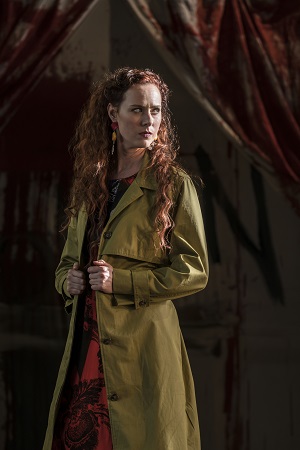 Sky Ingram (Donna Elvira). Photo credit: Johan Persson.
Sky Ingram (Donna Elvira). Photo credit: Johan Persson.
Paul Whelan’s Commendatore didn’t make much of a mark in Act 1 - perhaps it’s difficult to be imposing when felled by a fire extinguisher. But, he came into his own in Act 3, singing with refinement and ‘human’ feeling, if perhaps lacking a little in menace.
The close, though, failed to make its blood-chilling mark. And, this was, uncharacteristically, partly due to the slow tempi adopted by Dougie Boyd in the final sequence of scenes. Perhaps we’re talking miniscule ‘measurements’ here, but from the moment when Leporello reports to his master that the statue’s head has nodded, everything felt just a fraction too ponderous, and dramatic momentum was lost. Deprived of the epilogue ‘motto’, the ending - Don Giovanni was dragged down to hell on a backward-sliding painter’s ladder - was anticlimactic.
This felt like an opportunity lost. While Paul Curran the previous evening had drilled everything to such perfection that we didn’t notice the artifice, here the cogs chugged, sputtered and then ran out of steam. Michael Boyd’s conceptual seed was not without promise, but he didn’t water it with sufficient consistency or discipline to enable it to flower as it might.
Claire Seymour
Don Giovanni - Jonathan McGovern, Leporello - David Ireland, Donna Anna - Camila Titinger, Donna Elvira - Sky Ingram, Don Ottavio - Trystan Llŷr Griffiths, Commendatore - Paul Whelan, Zerlina - Mireille Asselin, Masetto - Thomas Faulkner; Director - Michael Boyd, Conductor - Douglas Boyd, Designer - Tom Piper, Lighting Designer - Malcolm Rippeth, Movement Director/Choreographer - Liz Ranken, Garsington Opera Orchestra & Chorus.
Garsington Opera; Saturday 1st June 2019.
image=http://www.operatoday.com/DG%20Garsington%20title.jpg image_description= product=yes product_title=Don Giovanni: Garsington Opera 2019 product_by=A review by Claire Seymour product_id=Above: Jonathan McGvern (Don Giovanni)Photo credit: Johan Persson
June 2, 2019
A brilliant The Bartered Bride to open Garsington's 2019 30th anniversary season
Bedřich Smetana’s The Bartered Bride is essentially a sentimental rom com. To benefit his own purse, Kecal tries to persuade Jeník to give up his claim on Mařenka and barter her for a monetary reward, because Mařenka’s parents have agreed that that she must marry Vašek, the younger son of the rich landowner Mícha and his wife, Háta, to settle an earlier debt. Kecal’s plans are eventually thwarted by Jeník’s cunning, when he devises a contract which allows him, Mícha’s older son from his first marriage, to take Mařenka as his bride. Love conquers all, after all.
Smetana colours his tale of Czech village life with toe-tapping polkas, furiants and drinking songs, foot-stamping choruses and, in the final Act, a full-blown circus spectacular. And, Paul Curran’s production of The Bartered Bride proved the perfect headliner for Garsington Opera’s 30th seasons. In Curran’s hands the party goes with a swing, the action is slick, and the music - with Jac van Steen conducting the Philharmonia Orchestra - rouses one’s spirits.
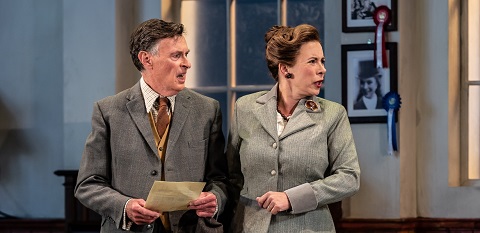 Peter Savidge (Krušina), Heather Shipp (Ludmila). Photo credit: Clive Barda.
Peter Savidge (Krušina), Heather Shipp (Ludmila). Photo credit: Clive Barda.
Curran ignores the fact that The Bartered Bride is almost synonymous with ‘Czech opera’. We have travelled far from Bohemian villages and find ourselves in an English parish church hall in the 1950s. It’s not an unprecedented transportation. Much has been written about the debt to Smetana evident in Benjamin Britten’s early operas and, more specifically, Martin Nedbal [1] has drawn attention to the way the stuttering Albert Herring - a mummy’s boy who longs to grow up and break away from the apron strings, and who becomes ever more alienated from his fellow villagers - draws on Smetana’s characterisation of Vašek.
Nedbal notes that ‘in his 1995 reminiscences about the inception of Benjamin Britten’s fourth opera … librettist Eric Crozier acknowledged that Bedřich Smetana’s opera The Bartered Bride served as an inspiration for the project’ and that ‘in his discussion of the 1951 opera Billy Budd, Donald Mitchell went so far as to claim that “Britten fell in creative love with Vašek’s stutter.”’ It can surely be no coincidence that in 1943 Sadler’s Wells Opera produced The Bartered Bride, with Peter Pears cast as Vašek.
But this musical relationship is no guarantee that a transplantation from Český ráj to Loxford will be a success. That it undoubtedly is a triumph par excellence owes to the imagination, skill, attention to detail and total commitment of Curran, Kevin Knight (designer), Howard Hudson (lighting) and Darren Royston (choreographer). And, it must be emphasised, the hours, days, weeks of rehearsal that the dedicated chorus and cast must have devoted to ensuring that everything was pitch perfect and timed to a tee.
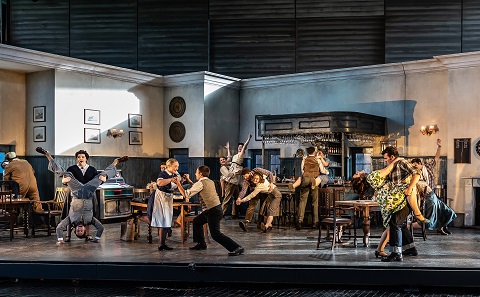 Photo credit: Clive Barda.
Photo credit: Clive Barda.
And, it’s not just Albert Herring who seems to resurface in this tale of parochial avarice and amour. Britten’s Mr Gedge, the vicar, seems to rush into the church hall at the start, enthusiastically directing the workman to shuffle the table along, and plug in the LP player from which his favourite music, the overture of Smetana’s The Bartered Bride, will burst forth with heart-stopping energy and daring. He chats politely with the ladies who do the flowers and bake the cakes for the church bazaars. Later, he joins in heartily in the pub drinking-song frolics, before bashfully apologising to a young lass whose waist he might have circled a little too tightly.
And, in Háta, Mícha’s second wife, we have a cross between Albert’s mum - she’s forever combing Vašek’s hair or blowing the sad lad’s nose - and Lady Billows, when she disapproves of his defiant refusal of Mařenka’s hand and apparent desire to run away with the circus.
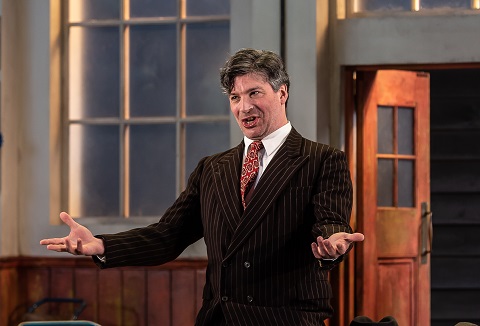 Joshua Bloom (Kecal). Photo credit: Clive Barda.
Joshua Bloom (Kecal). Photo credit: Clive Barda.
Knight’s designs are ingenious and persuasive. We start Act 1 in a village hall equipped with a small raised stage for am dram - there’s a determined parish nurse at hand ready to rehearse the rank and file - and with a piano, proudly sporting gymkhana cups and rosettes, in position to accompany a dance or communal song. Stage-left is a kitchen with a range and fridge, shelves heaving with pots and baskets (and a violin case resting on a trumpet!), an oversize kettle dangling from a hook, and a steaming urn. They won’t go hungry here, as spam sandwiches and Victoria sponges are piled high for post-entertainment refreshments.
As the chorus assembled during the overture, the way that Curran and Royston made so much activity of so diverse a nature seem utterly fluid, natural and absorbing was nothing short of miraculous. Stepladders are shifted by handy-men; ladies in twin-sets dust the piano; the nurse drills the dancers through their steps; a pair of cool dudes try to sabotage Smetana and establish Elvis as the grooviest of them all; a cake is deftly iced. Ladders swing - some in the hall are in danger of decapitation - and doors slam, leaving others at risk of a headache, at the least: it’s The Play that Goes Wrong with the farce replaces by verisimilitude and earnestness. And, it’s brilliant.
No less stunning is the set change between Acts 1 and 2. As Má vlast rings from the pit, the stagehands and chorus members effect the slickest scene change you could imagine. They dismantle blocks, swivel and slide them, whip away tables and chairs, and hey presto, before we know it, we’re in the pub: furnished with a fully equipped bar, a dartboard, and decorated with racing-horse prints. During the subsequent extended duets for Mařenka and Vašek, and Kecal and Jeník, the chorus amuse themselves, as villagers do, playing darts and card games, smoking on stools at the bar, indulging in girlie gossip. The beer is flowing and there are several slightly desperate trips to the gents. Then, the community come together to let rip to a duke box waltz.
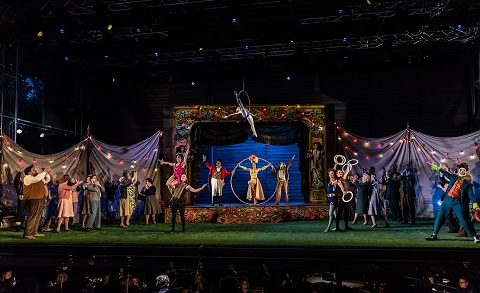 Photo credit: Clive Barda.
Photo credit: Clive Barda.
In Act 3 the circus comes to town - and offers a rather more elaborate display and entertainment than Albert’s May-King fête. Standing in front of a brightly curtained stage ‘à la Punch and Judy’, festooned with red and light bulbs, the Ring-Master promises chair-swallowing native Indians, a floor show of acrobatic improbabilities and a dancing bear. What eventually ensues might not quite be Cirque du Soleil, but the six circus performers present an unbelievably varied, overlapping sequence of skills and tricks: they balance on shoulders and heads, juggle, ride uni-cycles, hang from suspended rings by their toes, somersault and achieve astonishing feats of strength.
Natalya Romaniw’s Mařenka and Brendall Gunnell’s Jeník are ‘made for each other’ in just about every way. It doesn’t matter that, when slicing the bread for the spam sandwiches, she aims for delicate while he prefers doorstop: they’re a perfect vocal and romantic match. Both have endless stamina and reserves of power, which they use judiciously. They can conjure huge passion through emotive colourings and nuances, but they can also sing with real tenderness, as in their Act 1 duet. They share a sense of fun - an extended farewell is sweet and never twee - and even when they argue there is a humorous undercurrent, Jeník haughtily but forgivingly mimicking the leg-crossing fury of the young lady who is too stubborn to listen to the truth, when she fears that her beloved has betrayed her.
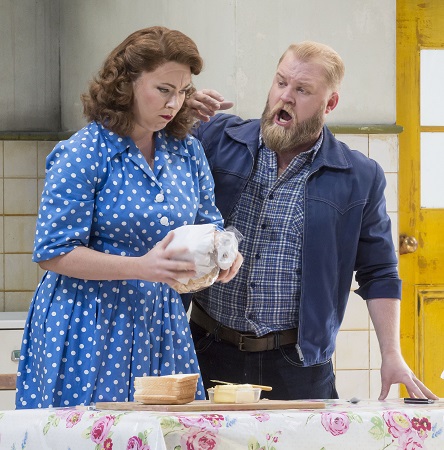 Natalya Romaniw (Mařenka) and Brendan Gunnell (Jeník). Photo credit: Clive Barda.
Natalya Romaniw (Mařenka) and Brendan Gunnell (Jeník). Photo credit: Clive Barda.
Romaniw’s Mařenka is no shrew: but she knows her own mind and is frustrated when her desires and ambitions are hindered - though she is more likely to take it out on a Victoria sponge, which is sliced to smithereens, than on the parents and community who inhibit her. Romaniw has a free and powerful lyric voice but she knows how to sing quietly too, to wonderful expressive effect. Her tone is full and warm, at whatever dynamic level. When she sang of her imagined betrayal in Act 3, there can’t have been an untouched heart in the Garsington pavilion; but in Act 2, she was a mischievous minx, teasing Vašek with tales of his betrothed - who plans to run away just as soon as she has poisoned him. Gunnell displayed really captivating strength and colour; there was an ardency borne of both love and the independence of spirit with which he overcame his rejection by his step-mother.
Joshua Bloom’s Kecal swaggered in body and voice - with the bluster of the bold, the bully and the blunderbuss. It’s a tricky task to embody the marriage broker who must be both a nasty piece of work - deserving of the villagers’ scornful eviction at the close - but also warm enough to make us laugh. Bloom surmounted the challenges and sang with terrific authority and spirit throughout.
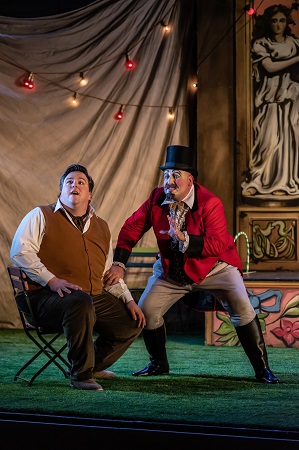 Photo credit: Stuart Jackson (Vašek) and Jeffrey Lloyd-Robert (Ring-Master). Clive Barda.
Photo credit: Stuart Jackson (Vašek) and Jeffrey Lloyd-Robert (Ring-Master). Clive Barda.
Stuart Jackson’s Vašek stuttered and stumbled eloquently; Jackson has a tenderness of tone that was just right for the unworldly Vašek’s naivety and nincompoop-ness; his tenor was an effective counterpoint to Jeník’s masculine strength, but that’s not to suggest there was a lack of power or expressiveness. And, Jackson milked the comic moments without tilting into mawkishness or mockery. Desperate to know what love means, he was a bear with a spring in his step.
Heather Shipp was excellent as Mařenka’s mother, Ludmila, especially in the closing moments when it became clear from whence her daughter’s own spiritedness had been borne. She was partnered well by Peter Savidge as Krušina, her husband, who proved more sensitive than one might suppose of one prepared to sell off his daughter to save his own skin from penury and public humiliation.
The Chorus almost stole the show; singing so rousingly, dancing with aplomb, twisting the May-pole ribbons with dexterity and ease. And, the Philharmonia shone from the pit in glorious technicolour. One impressive aspect of Jac van Steen’s leadership was the way in which he shaped the extended duets - as those in Act 2 for, first, Mařenka and Vašek, and then for Kecal and Jeník - clarifying the pace and nature of the changing dramatic temperature and mood, and allowing the performers to sing with flexible phrases which enhanced the dramatic naturalism.
Quite frankly, it’s difficult to imagine The Bartered Bride being staged with more sincerity and charm than this. A brilliant and totally beguiling start to Garsington’s 30th anniversary season.
Claire Seymour
Mařenka - Natalya Romaniw, Jeník - Brenden Gunnell, Kecal - Joshua Bloom, Vašek - Stuart Jackson, Krušina - Peter Savidge, Ludmila - Heather Shipp, Mícha - Paul Whelan, Háta - Anne-Marie Owens, Circus Master - Jeffrey Lloyd-Roberts, Esmeralda - Lara Marie Müller; Director - Paul Curran, Conductor - Jac van Steen, Designer - Kevin Knight, Lighting Designer - Howard Hudson, Choreographer - Darren Royston, Philharmonia Orchestra, Garsington Opera Chorus.
Garsington Opera; Friday 31st May 2019.
[1] [1] (2015) ‘Reinterpreting The Bartered Bride: Vašek as a Model for Britten’s Albert Herring’, Journal of Musicological Research, 34:4, 275-298.
Photo credit: Clive Barda
June 1, 2019
A reverent Gluck double bill by Classical Opera
As a long-time employee of the Hapsburg estate, Gluck was required to devise suitable entertainments for festive occasions. The celebrations for the 1769 wedding of Ferdinand, Duke of Parma (who was the grandson of Louis XV of France), and Maria Amalia, Archduchess of Austria (and sister of Marie Antoinette) were elaborate, extensive and drawn out over several months. Alongside feasts, a tournament, a Chinese fair and a display of new scientific inventions, Gluck contributed an opera-ballet titled Le feste d’Apollo comprising a prologue and three acts on Ovidian tales: Aristeo, Bauci e Filemone, and a revised and shortened version of his 1762 opera, Orfeo ed Euridice.
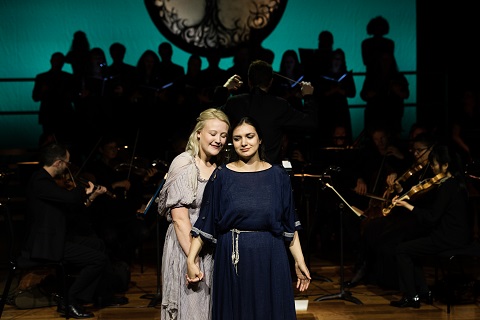 Kiandra Howarth (Euridice) and Lena Belkina (Orfeo). Photo credit: Benjamin Ealovega.
Kiandra Howarth (Euridice) and Lena Belkina (Orfeo). Photo credit: Benjamin Ealovega.
Classical Opera presented semi-stagings of the last two parts of the trio, their performance of the 1769 score of Orfeo being the UK premiere of this version. The pairing offered a good opportunity to hear the development of Gluck’s style, the ‘conventional’ seria sequence of recitative and aria in Bauci e Filemone evolving into a more dramatic interaction of words and music in Orfeo.
Bauci e Filemone tells of two young lovers, the eponymous shepherd and shepherdess, who show great respect and care for the god Jupiter when he appears before them disguised as a pilgrim. In return, the rustic couple are blessed by Jupiter with everlasting life and elevated to the status of demigods. At the same time, he curses their fellow Phrygians who had refused to help him.
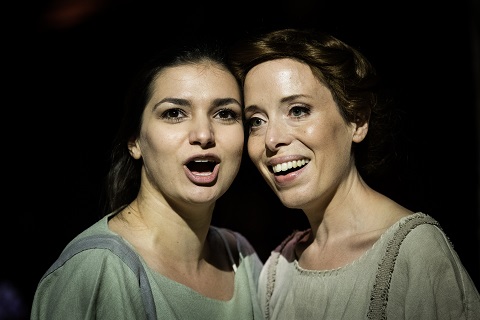 Lena Belkina (Philemon) and Rebecca Bottone (Bauci). Photo credit: Benjamin Ealovega.
Lena Belkina (Philemon) and Rebecca Bottone (Bauci). Photo credit: Benjamin Ealovega.
It’s a tender pastorale, which Wilkie and his designers, Emily Adamson and Philly Noone, sought to convey by placing a thicket of distressed silver birch trees at the side of Queen Elizabeth Hall stage and illuminating a silhouetted tree on a backdrop swathed in a sequence of strong colours - cerise, ultramarine, indigo. The action unfolded both in front of the orchestra and behind, a raised platform lifting the cast a little higher than the musicians.
The action unfolded gently, though the rather unflattering and indistinctive costumes - all beige smocks and sandals - didn’t immediately assist the ‘story-telling’, the shepherds being less than individualised. But, the music charmed, with some especially vivid and dynamic playing from The Mozartists. Lena Belkina’s Philemon and Rebecca Bottone’s Bauci formed a dulcet-toned and convincing sweet-natured duo in Gluck’s inventive duets, and Bottone confidently tackled Bauci’s stratospheric ascents in ‘Il mio pastor tu sei’, firing out heaven-bound notes that hit their target every time, the tone remaining true and full. Tenor Gwilym Bowen, looking every ounce the golden-haired god once he had cast aside his hessian rags for regal splendour, was a forthright Jupiter, relishing his ‘rage aria’, though the accompanying flickers of light didn’t quite summon a vision of celestial tumult and wrath.
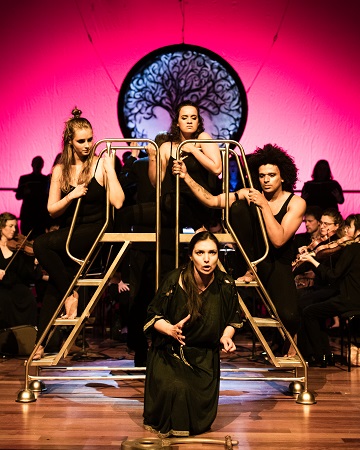 Lena Belkina (Orfeo) and Actors. Photo credit: Benjamin Ealovega.
Lena Belkina (Orfeo) and Actors. Photo credit: Benjamin Ealovega.
Kiandra Howarth sang her contribution as the Shepherdess assuredly, but had more to do as Euridice in the ensuing Orfeo. For this second part of the evening’s entertainment, Wilkie ‘enhanced’ the ragged glade by wheeling on some cheap portable ladders by which Belkina’s Orfeo, clutching a plastic lyre, would descend to Hades to rescue his beloved. Three actors, who doubled up as stage-hands, offered an array of bodily gestures which served a purpose that remained indiscernible and unfathomable to me. With the action repeated retreating to the rear, it was fortunate that the singers projected with strong characterisation and a persuasive sense of Gluckian style.
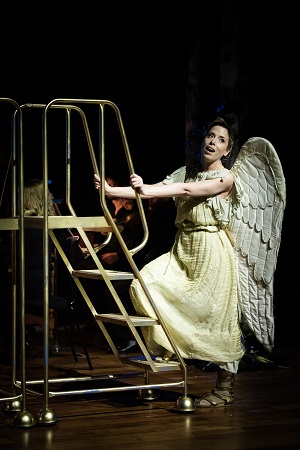 Rebecca Bottone (Amore). Photo credit: Benjamin Ealovega.
Rebecca Bottone (Amore). Photo credit: Benjamin Ealovega.
Dressed in a simple Greek tunic, Howarth expressively conveyed Euridice’s suffering. Belkina’s performance grew in intensity, impressively capturing the depth and diversity of Orfeo’s feelings. Bottone was a personable Amor, though she was encumbered with a pair of outsize wings which, along with the sliding stepladders and the flinging of gladioli about the stage, seemed out of keeping with Wilkie’s generally respectful tone. The Chorus added some of the vitality that was missing from the staging, and Ian Page, without undue fussiness, coaxed some fine playing from The Mozartists.
Last year, Classical Opera’s La finta semplice in the same hall had used costume, minimal staging and strong lighting to excellent dramatic effect. In this double bill, it was the music that took centre stage. With such fine singing and playing, perhaps it was a pity that we had not heard Aristeo too, giving us the opportunity to experience the whole of Gluck’s festale. For, Gluck himself was the star of this show.
Claire Seymour
Gluck: Bauci e Filemone and Orfeo
Lina Belkina (mezzo-soprano), Rebecca Bottone (soprano), Kiandra Howarth (soprano), Gwilym Bowen (tenor) Luke Elliott, Nadi Kemp-Sayfi & Dominyka Morkvėnaitė (actors); John Wilkie (director), Ian Page (conductor), Emily Adamson/Philly Noone (design), The Mozartists.
Queen Elizabeth Hall, London; Wednesday 29th May 2019.
image=http://www.operatoday.com/Jupiter%20Gwilym%20Bowen.jpg image_description= product=yes product_title=Bauci e Philemon and Orfeo: Classical Opera at the Queen Elizabeth Hall product_by=A review by Claire Seymour product_id=Above: Gwilym Bowen (Jupiter)Photo credit: Benjamin Ealovega